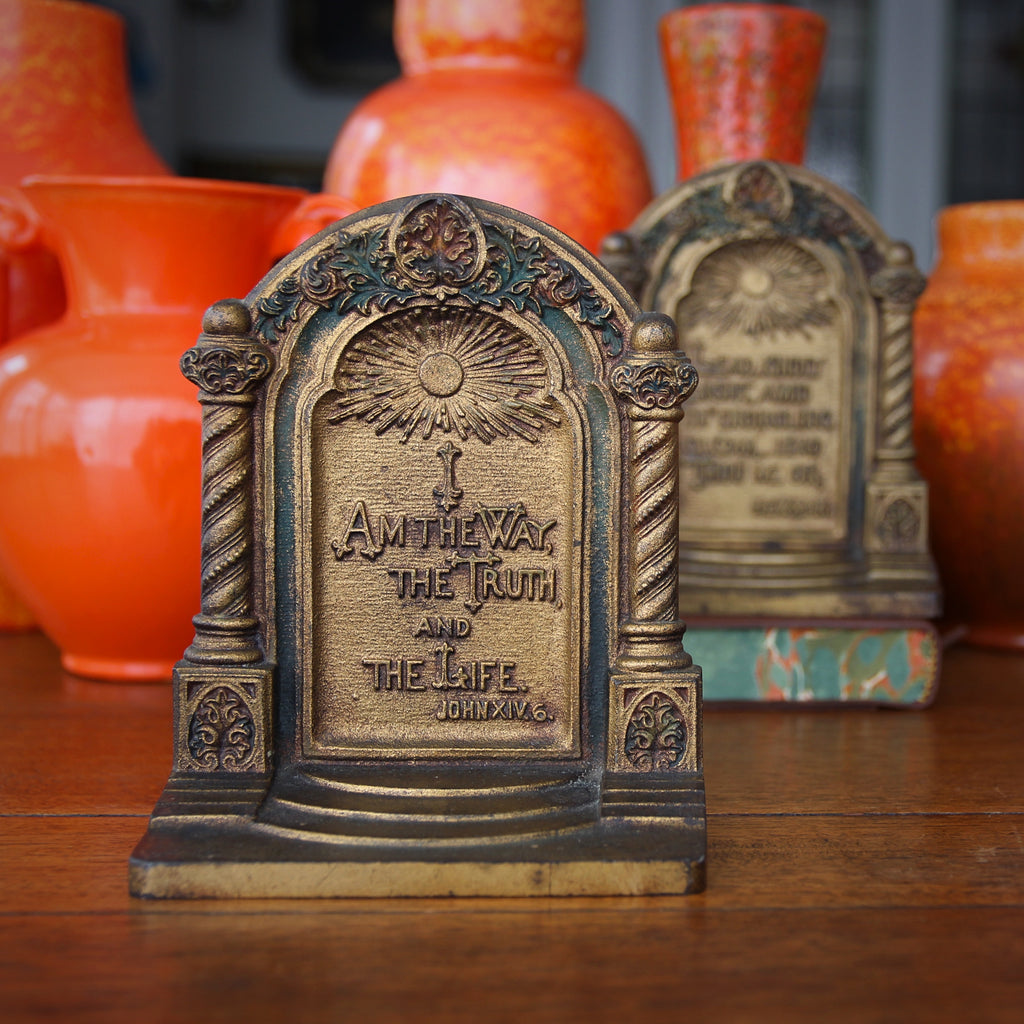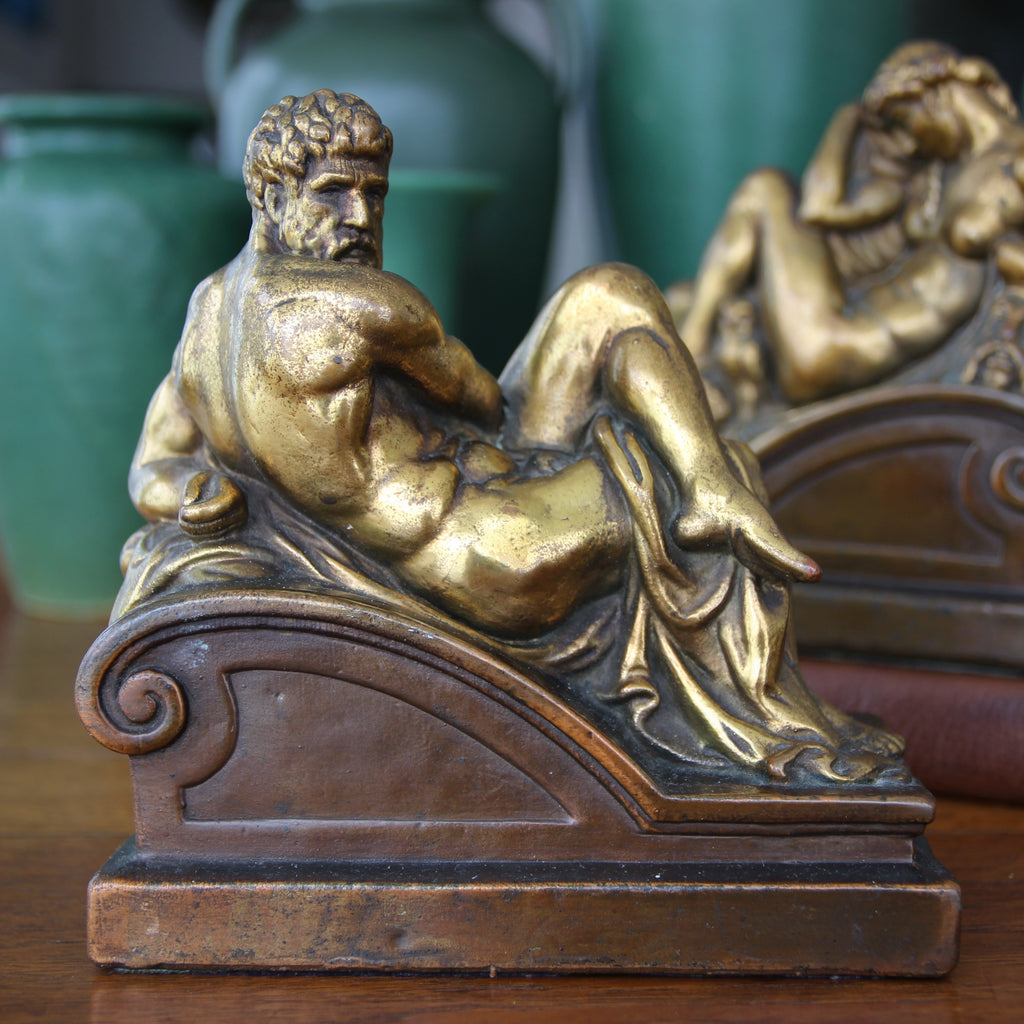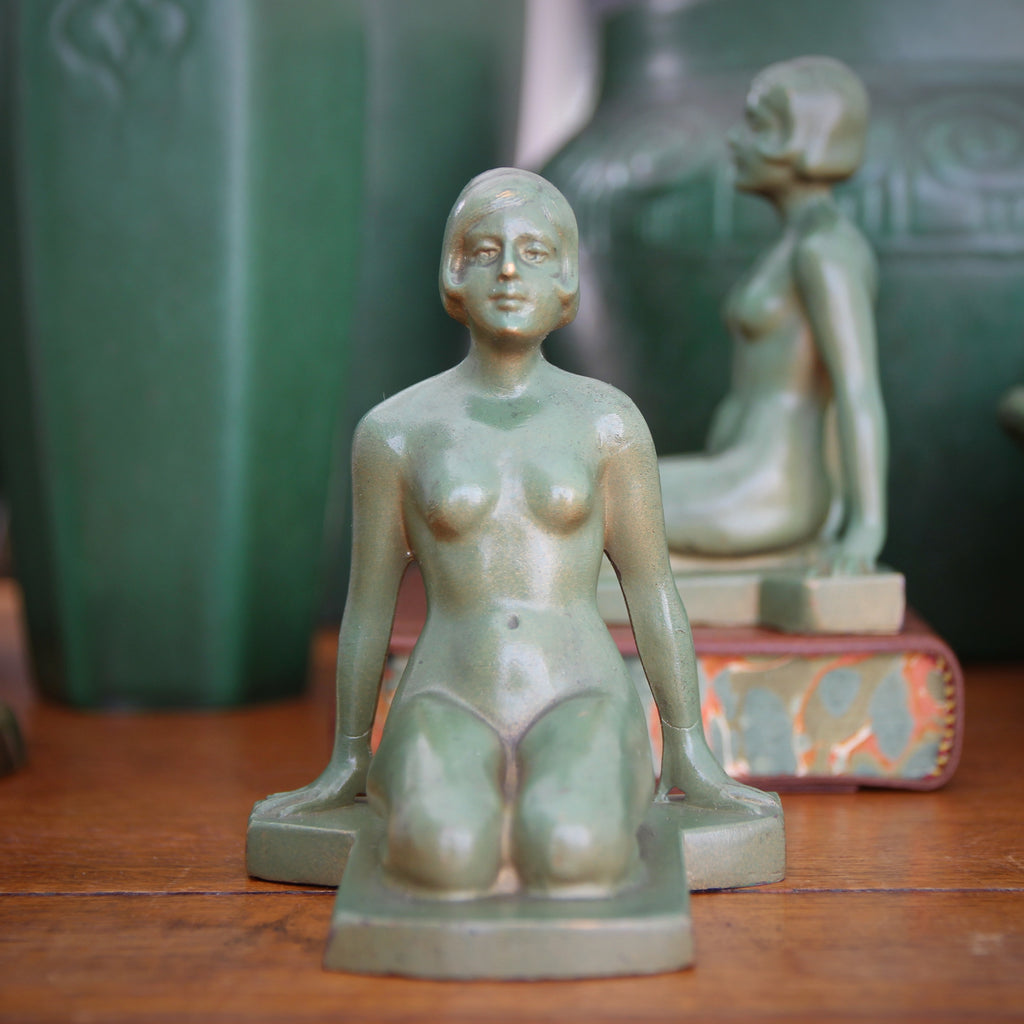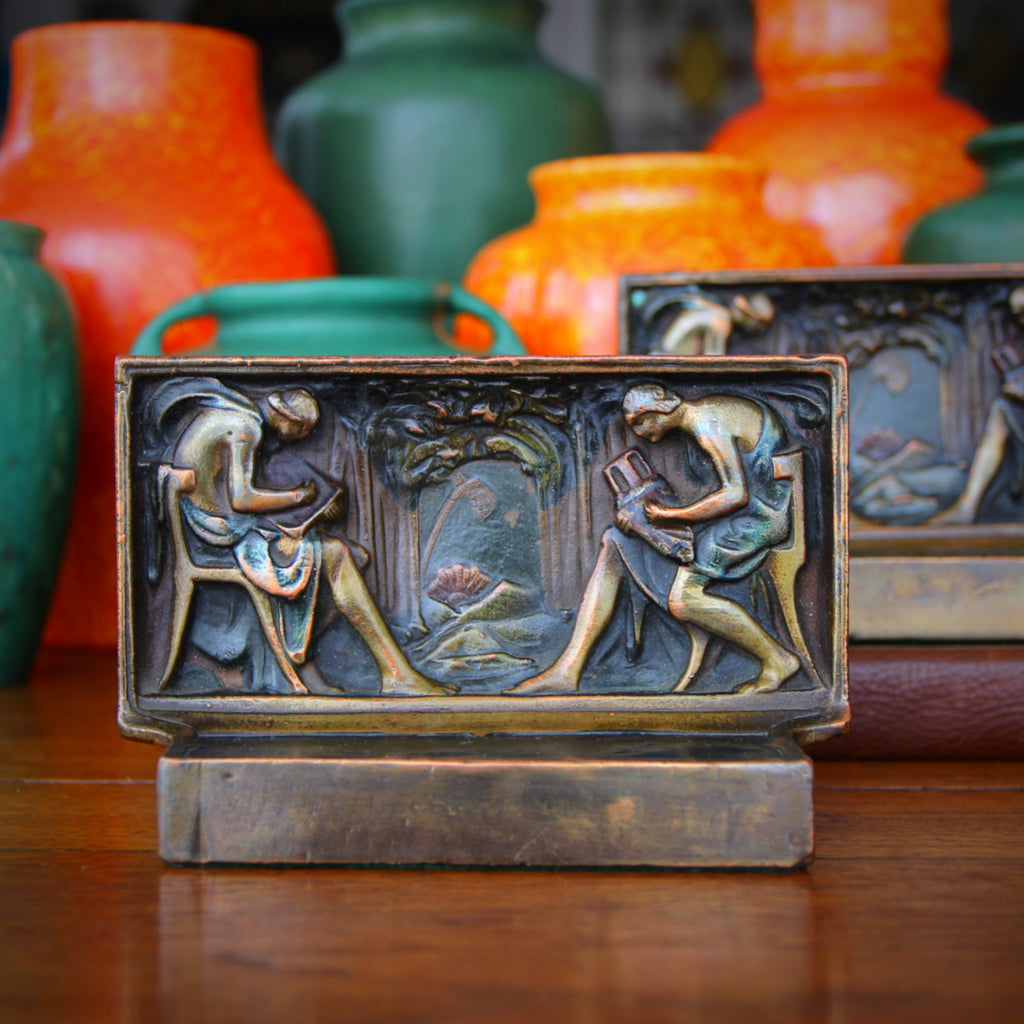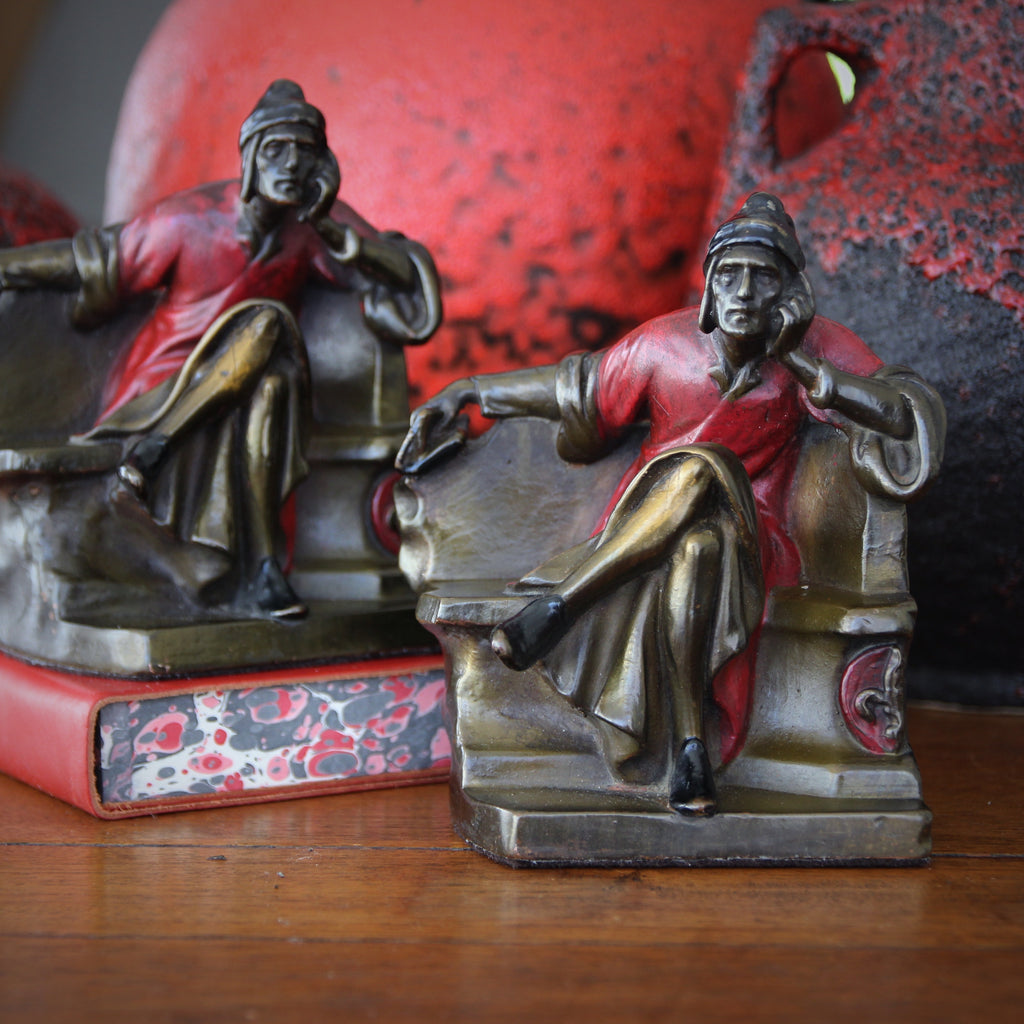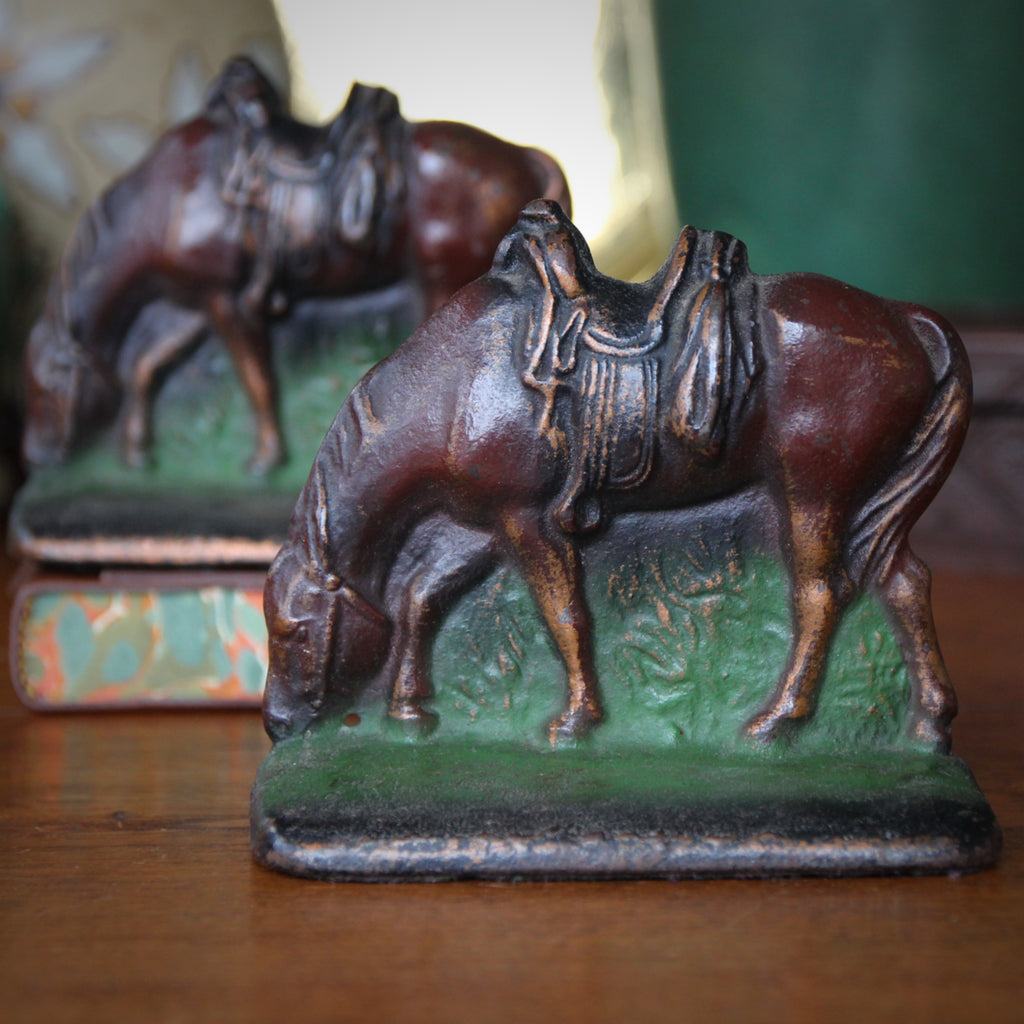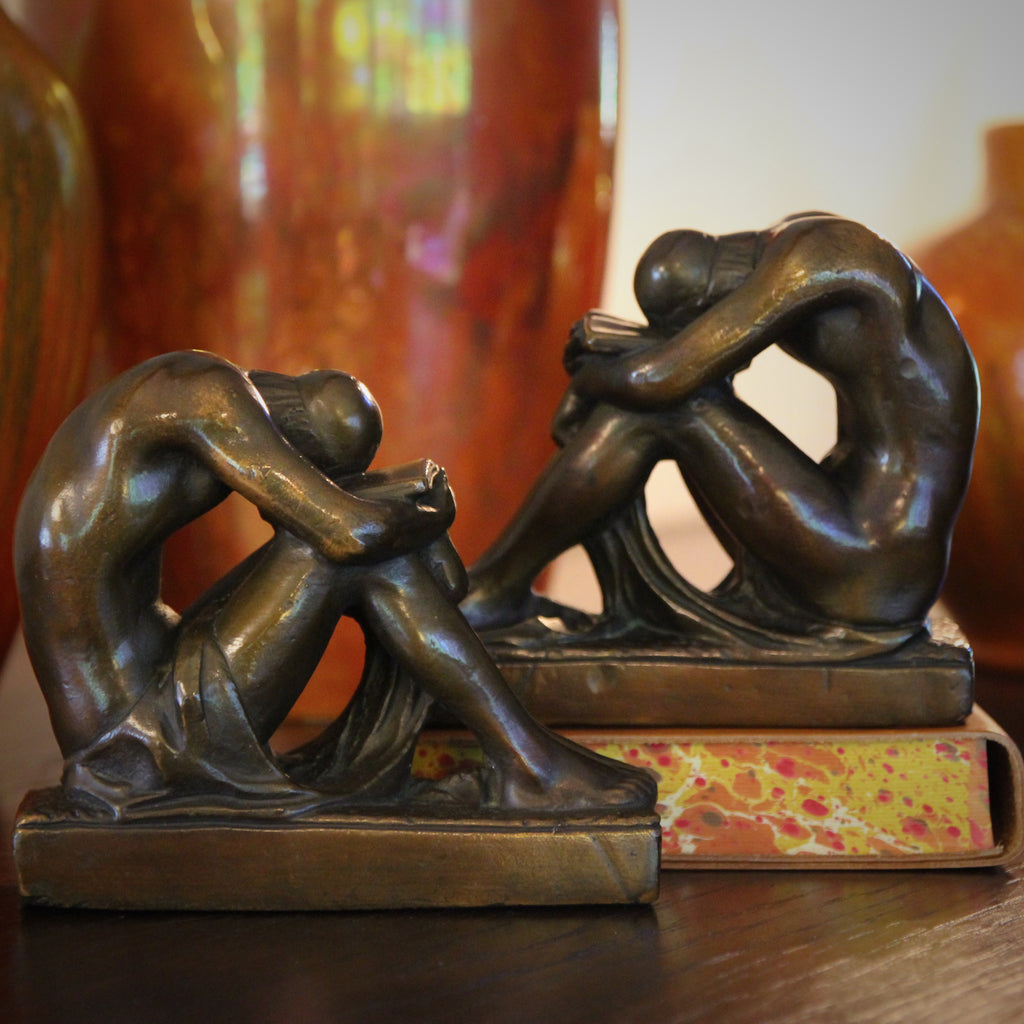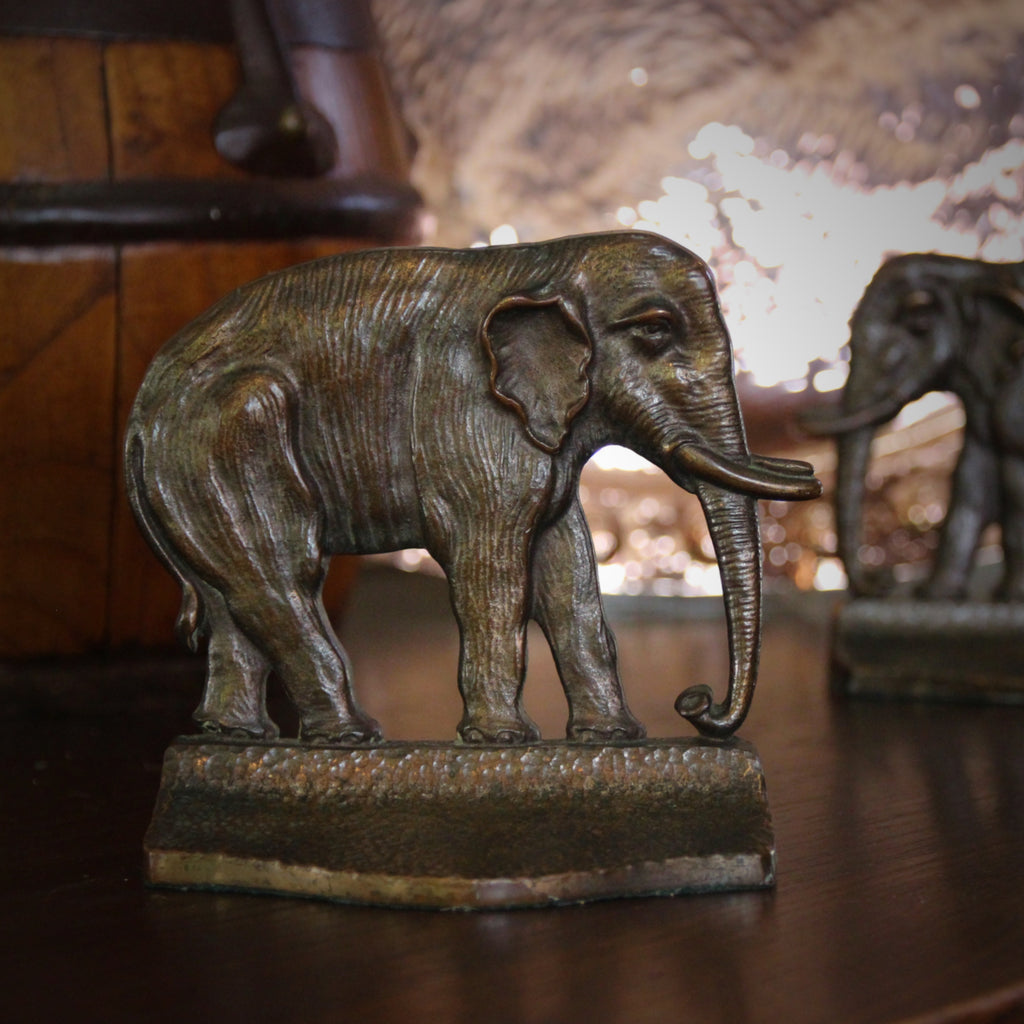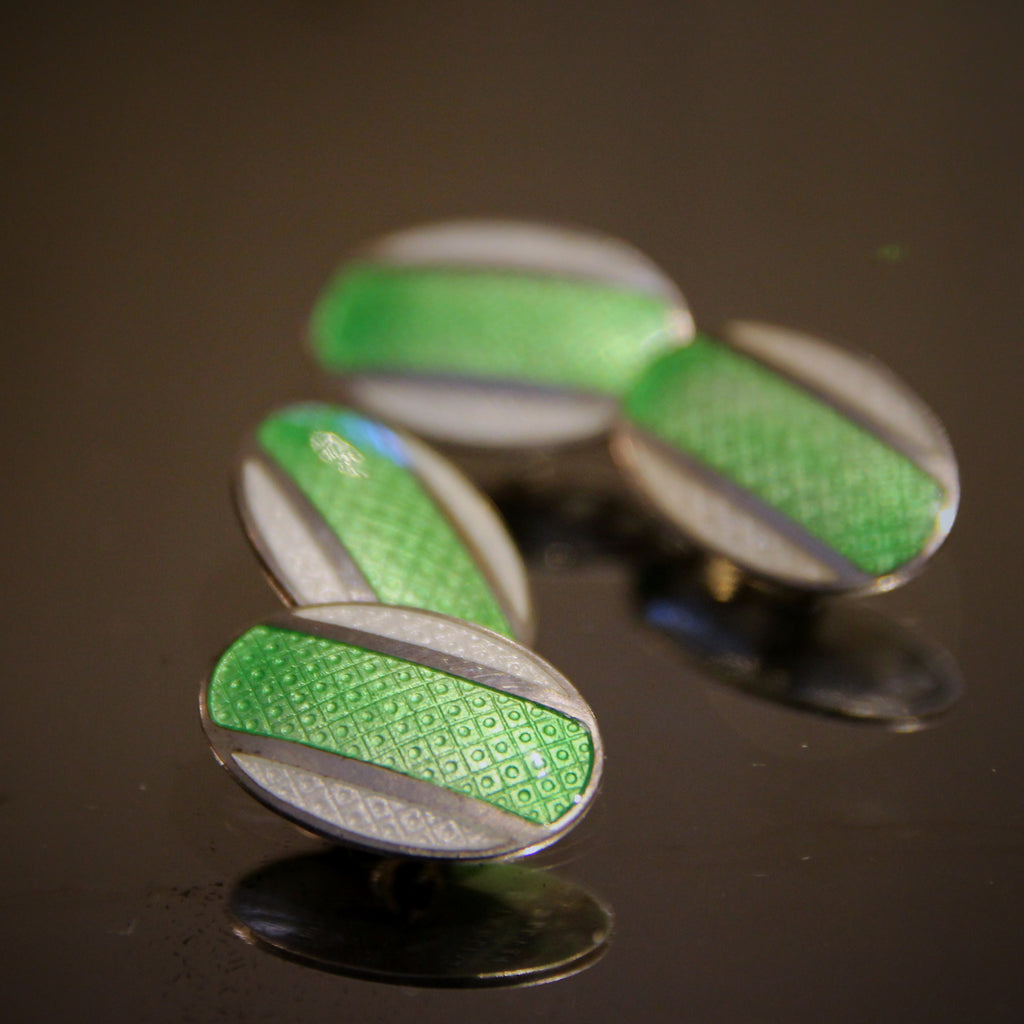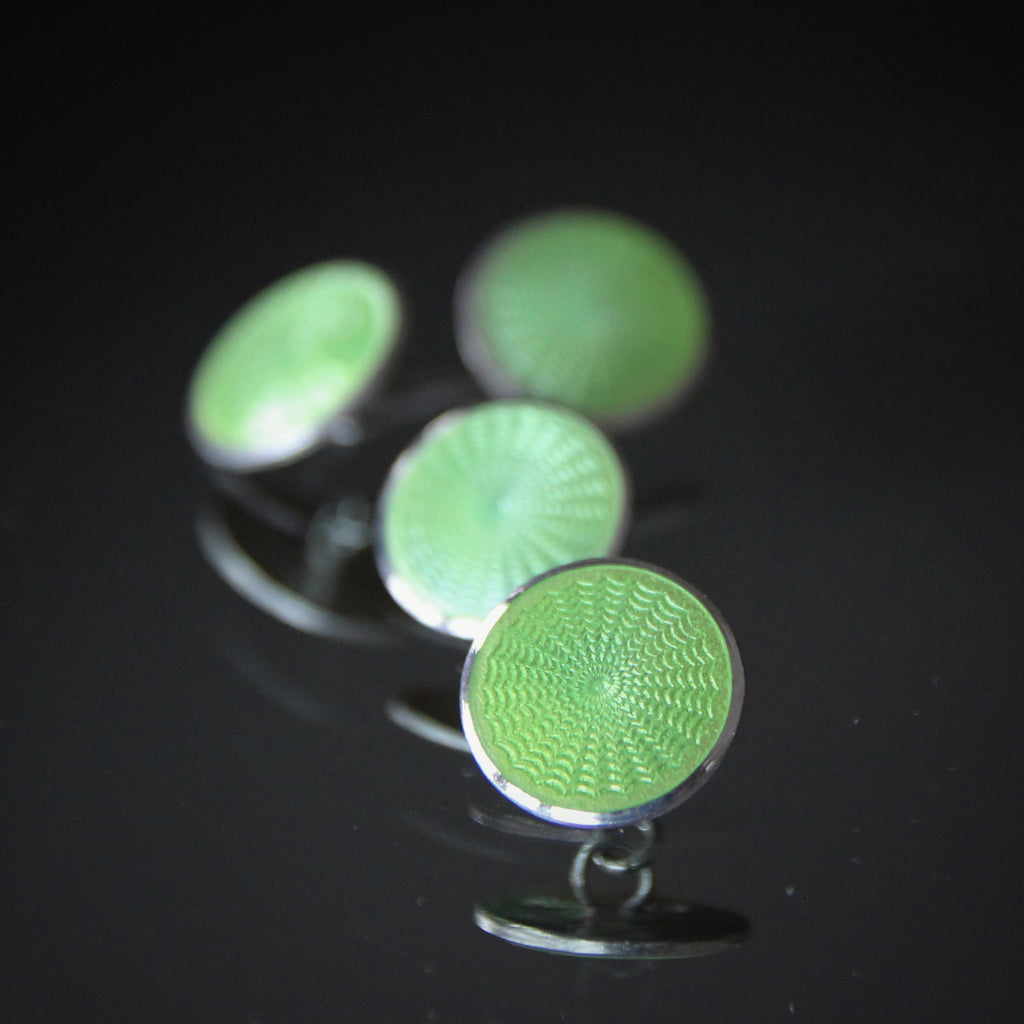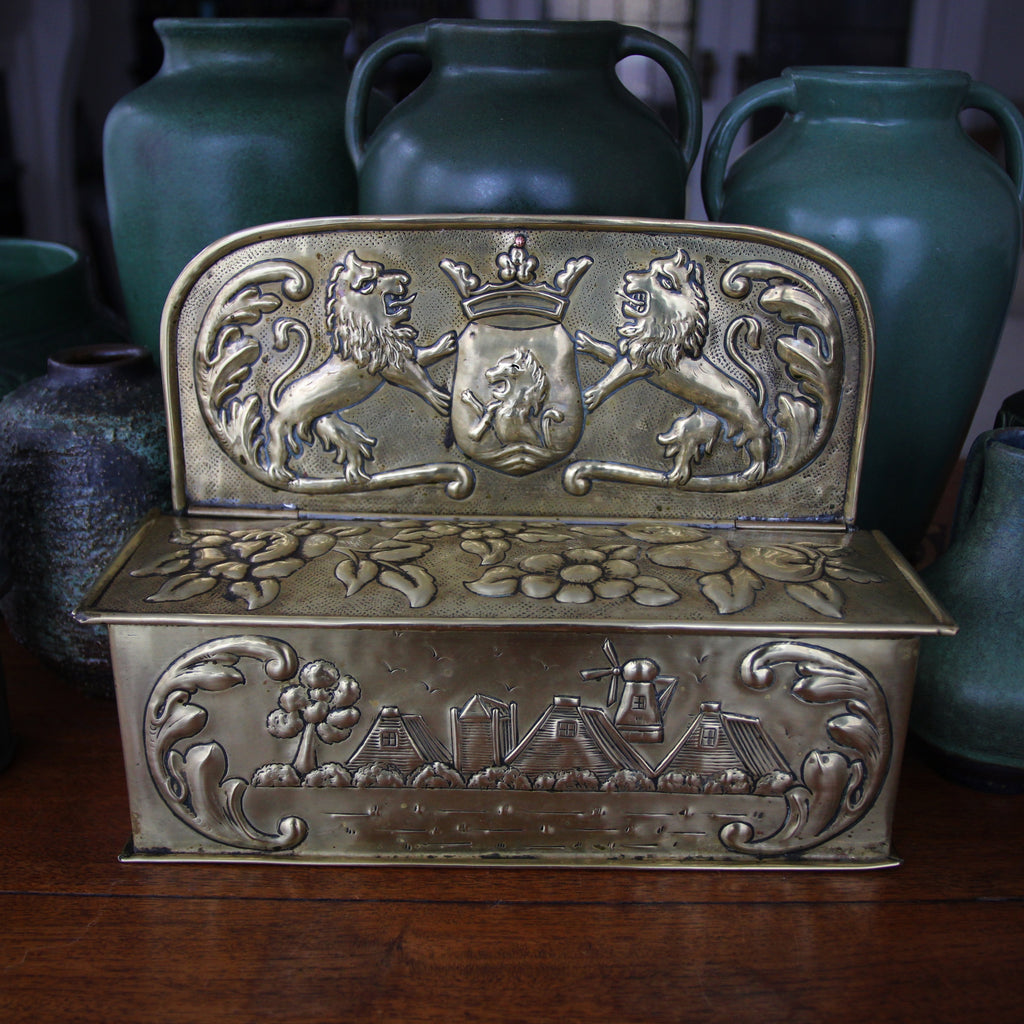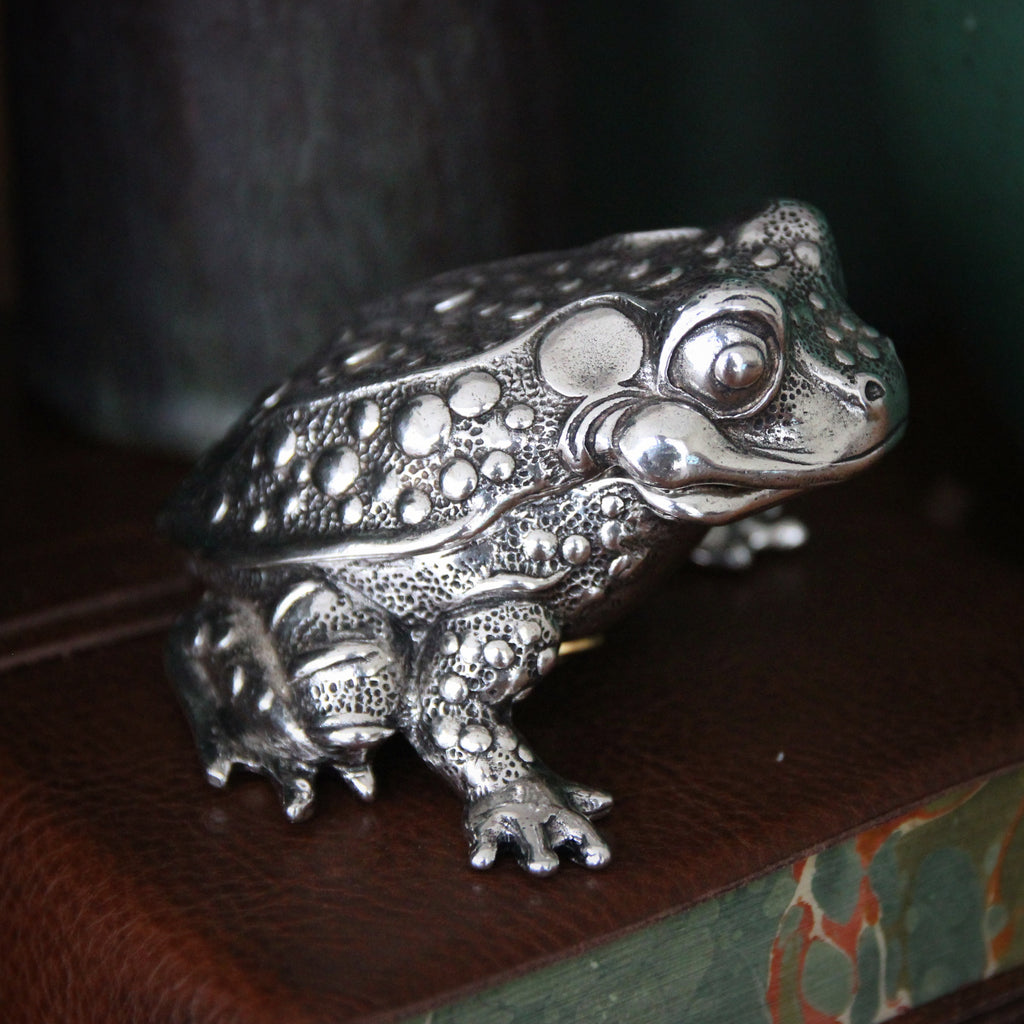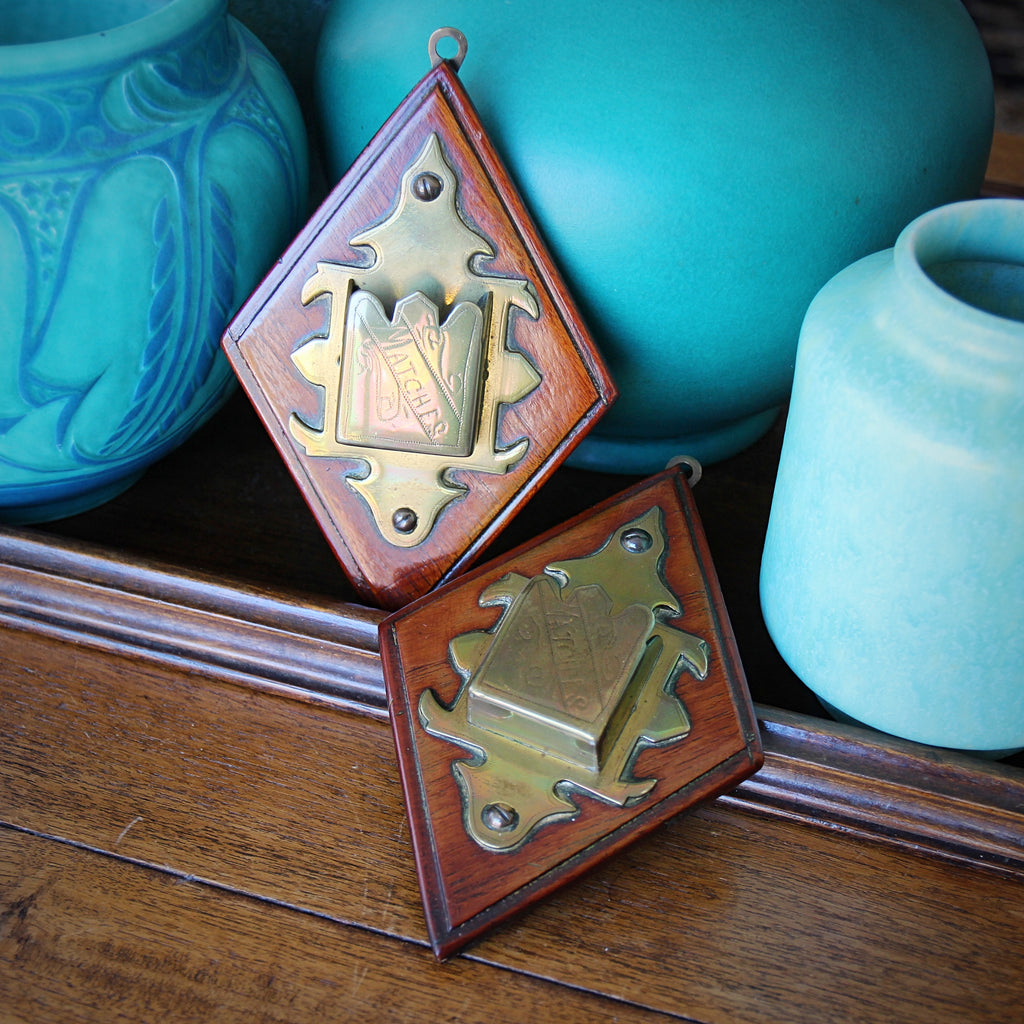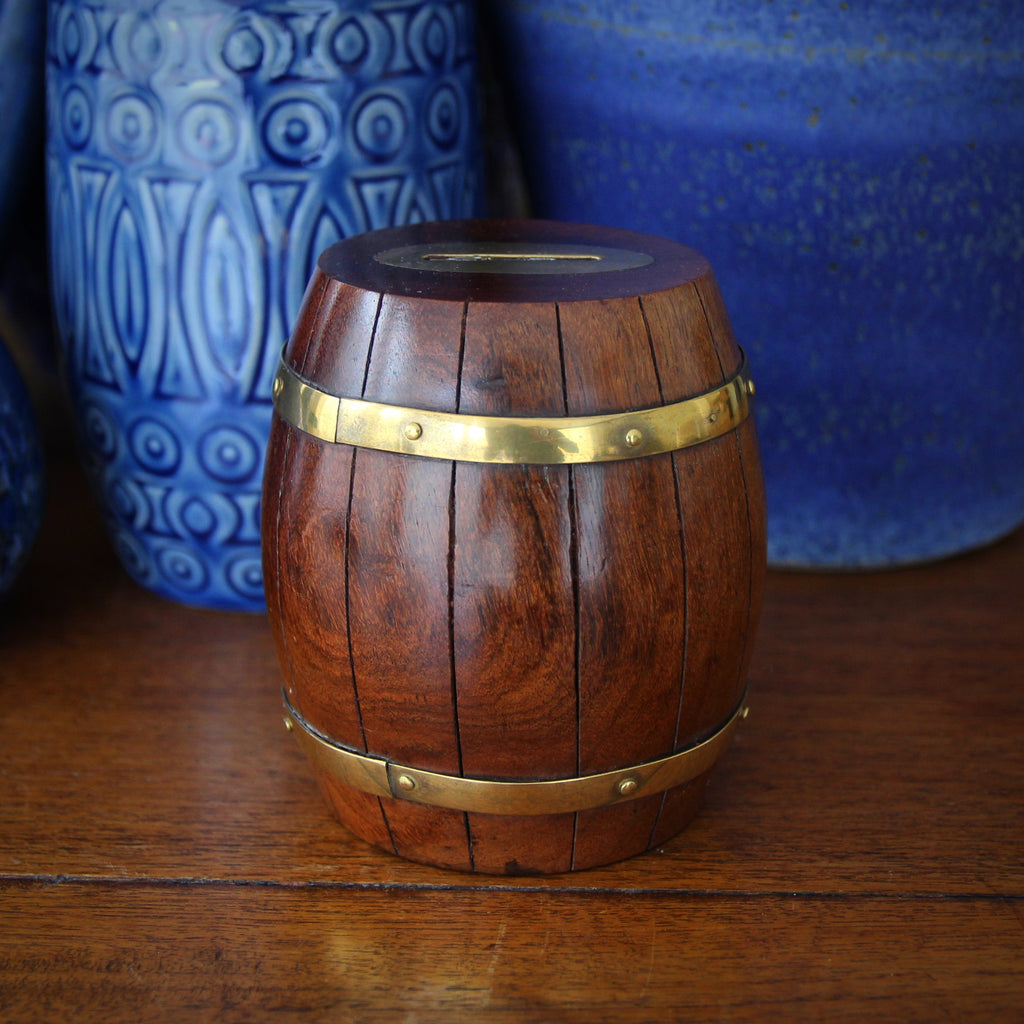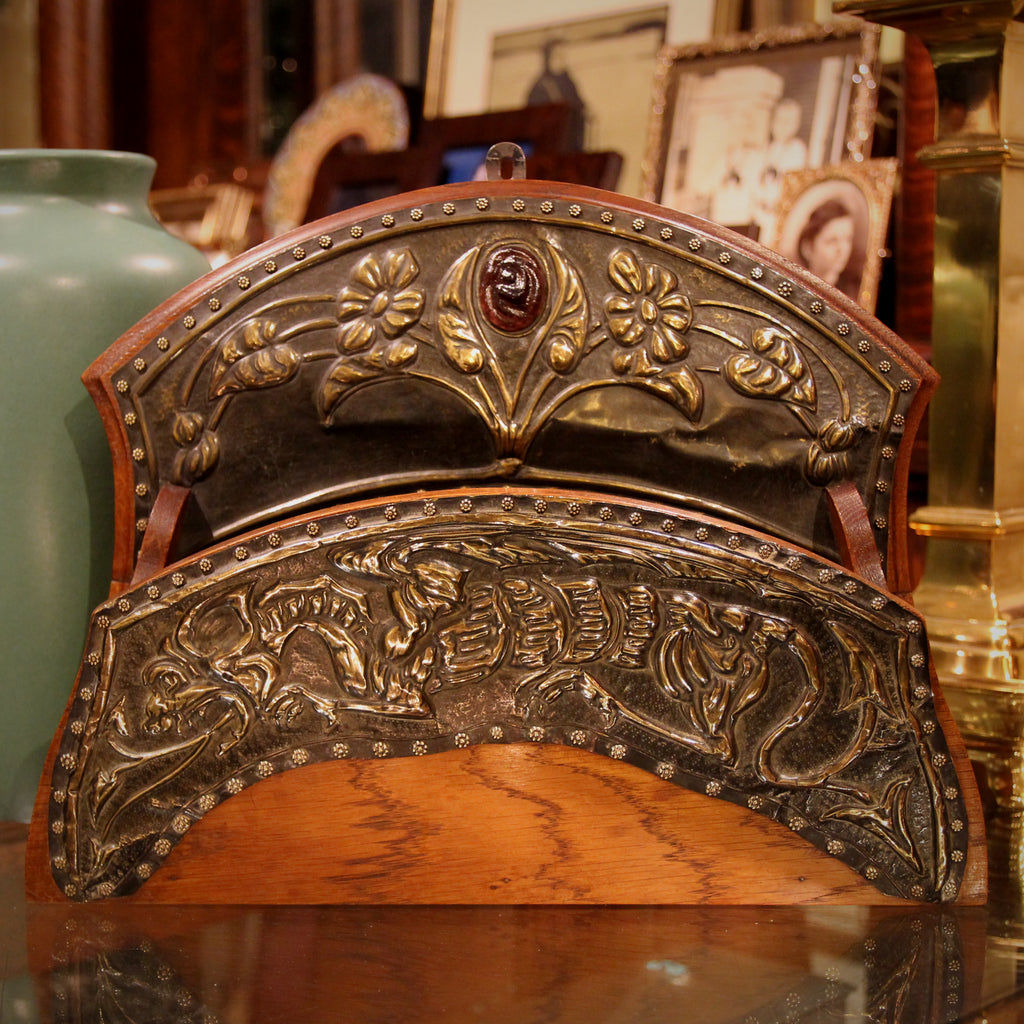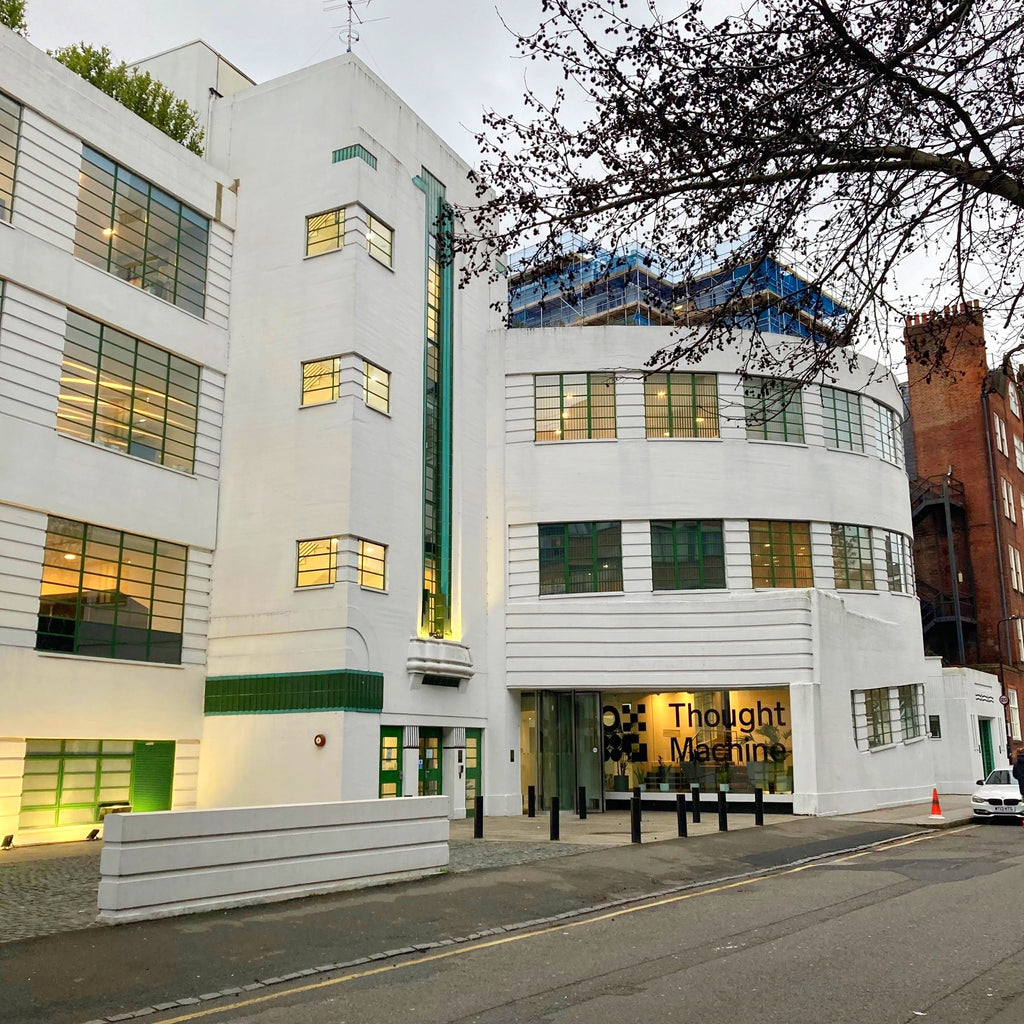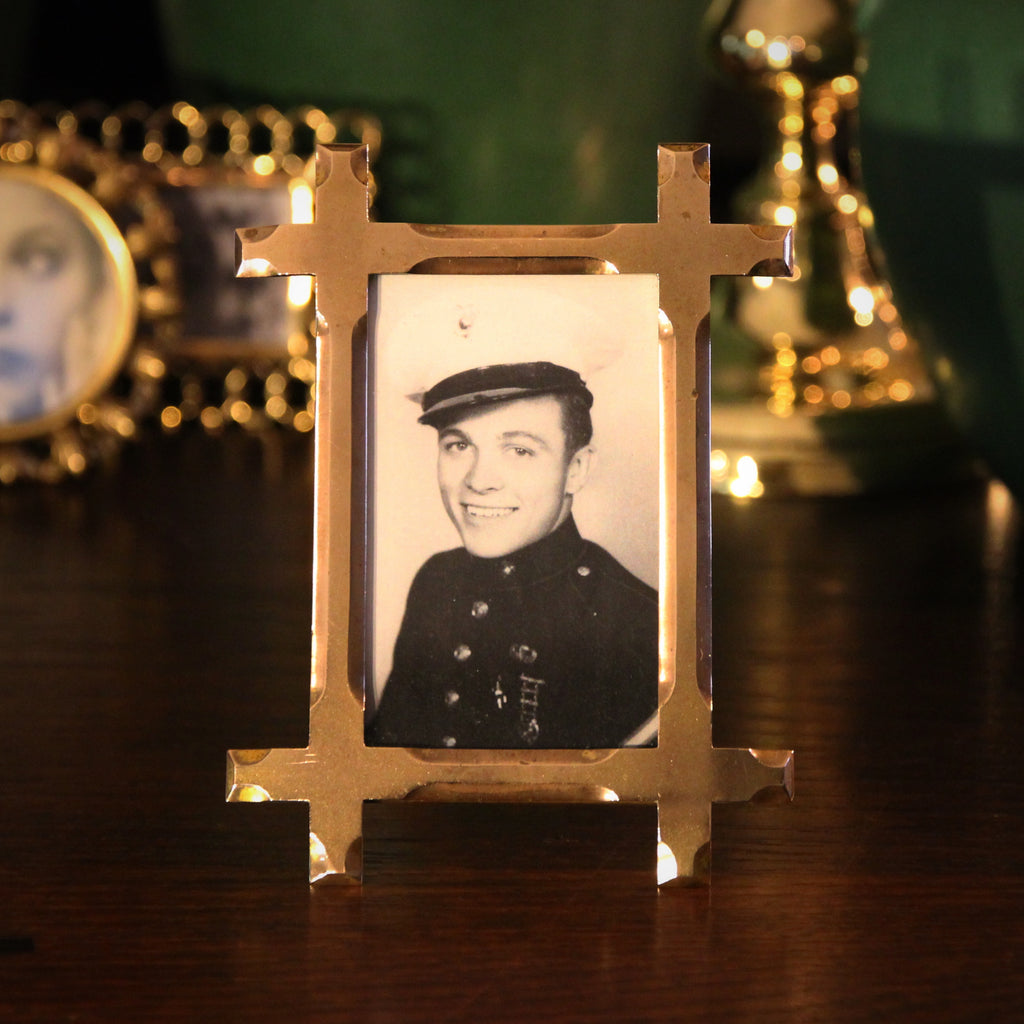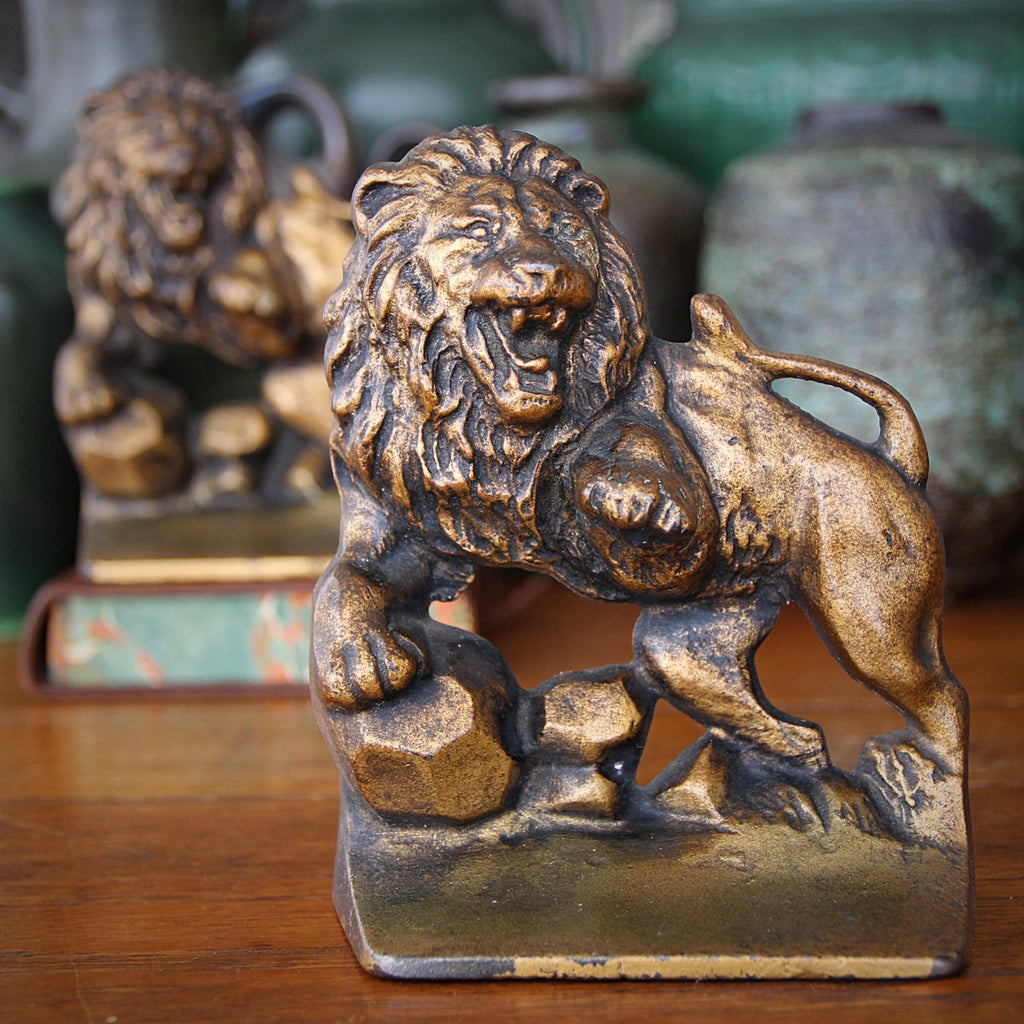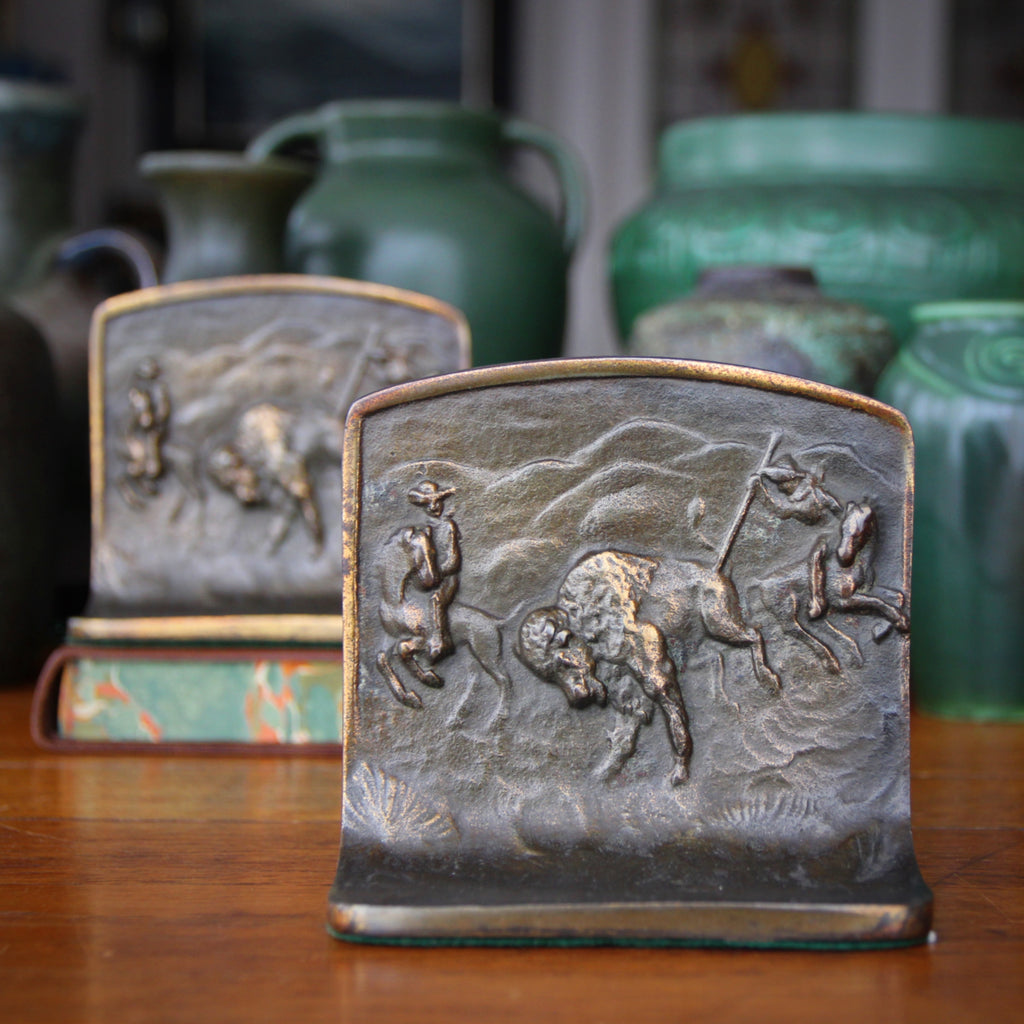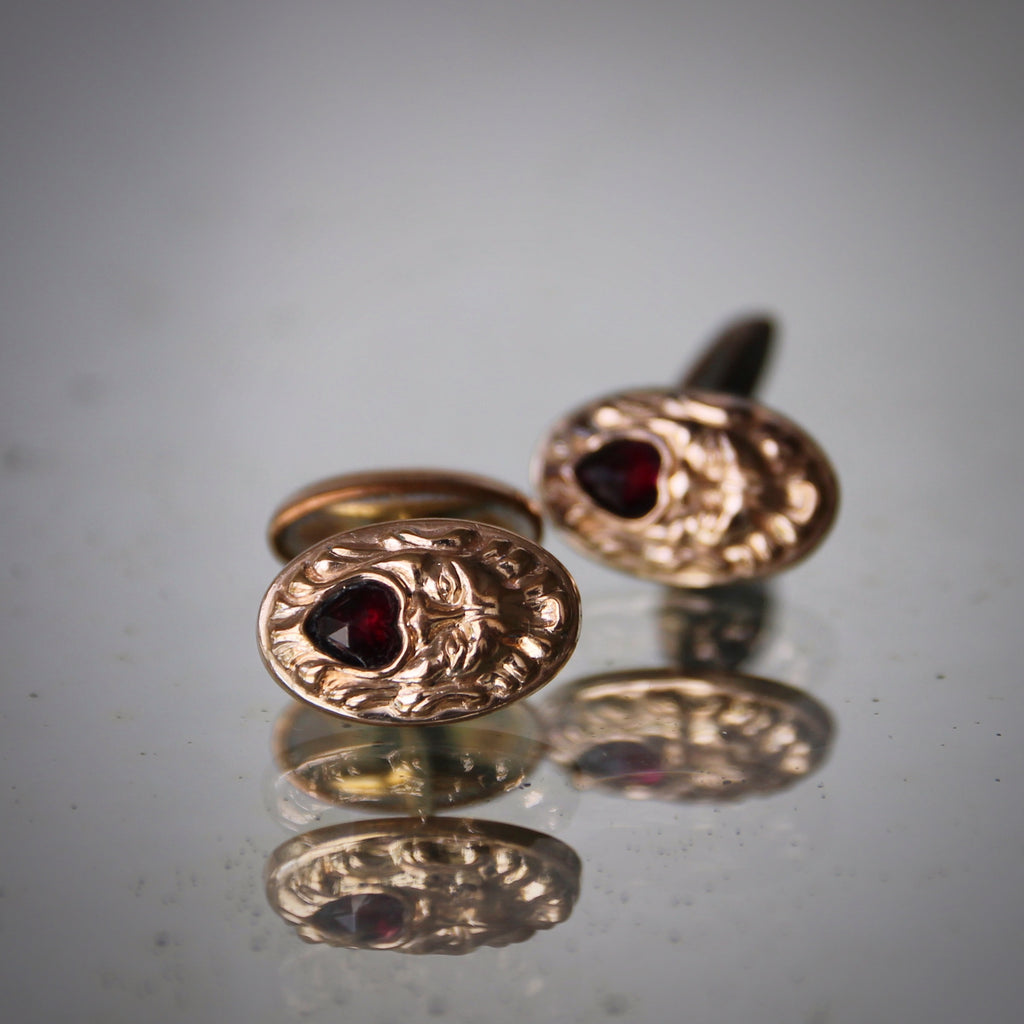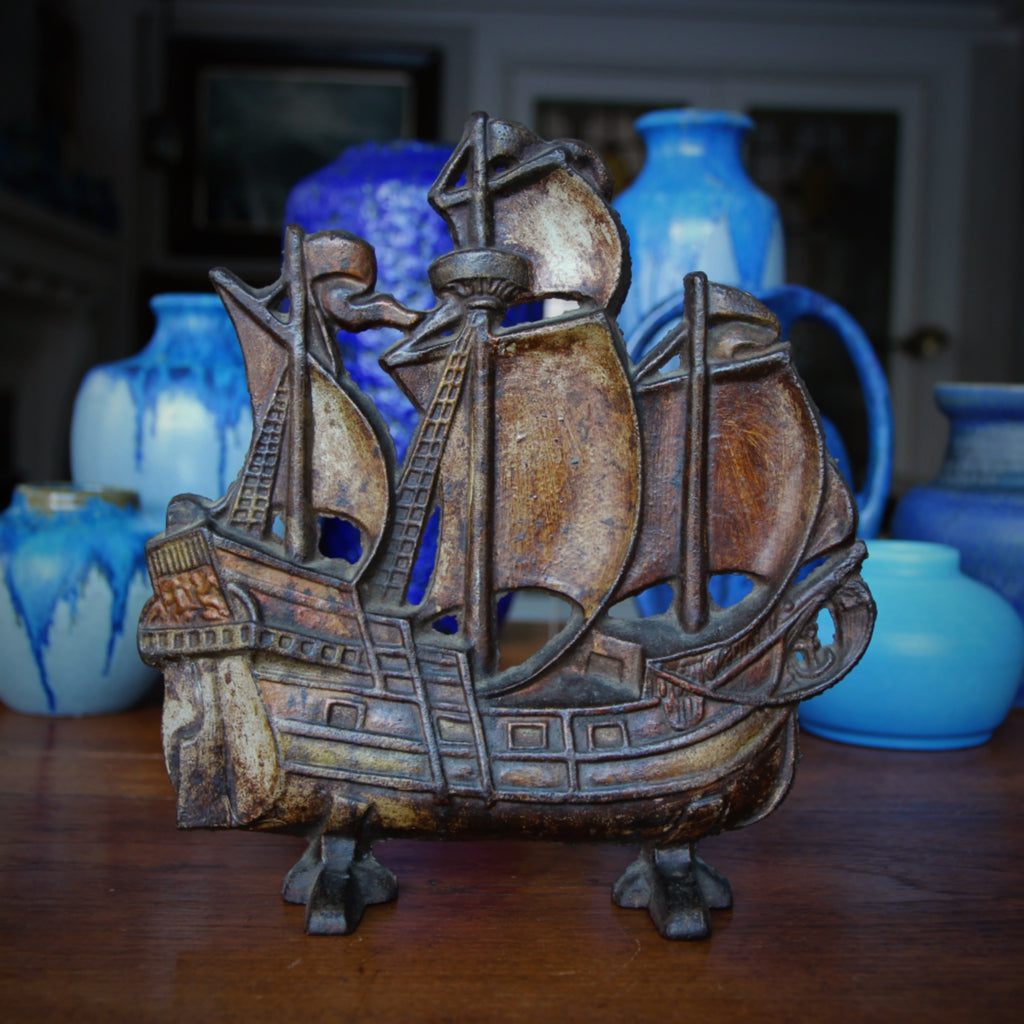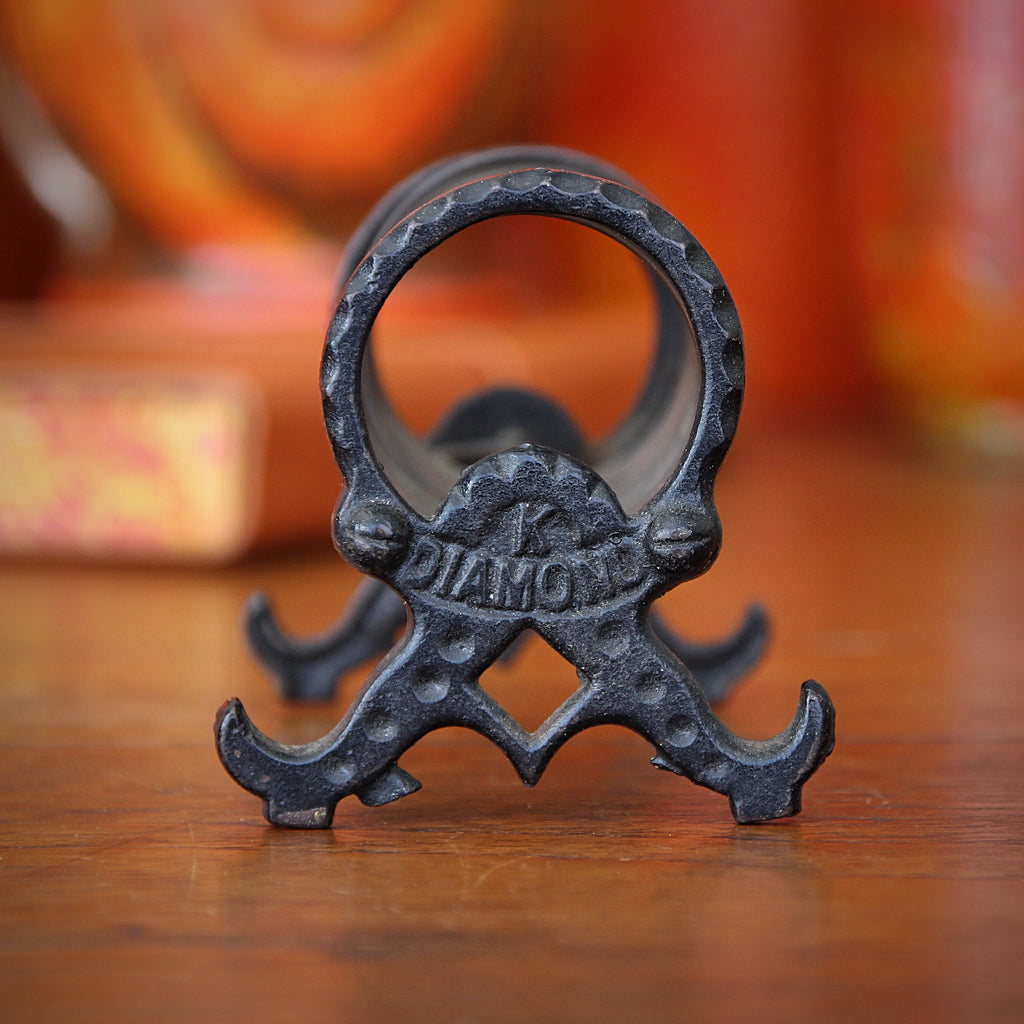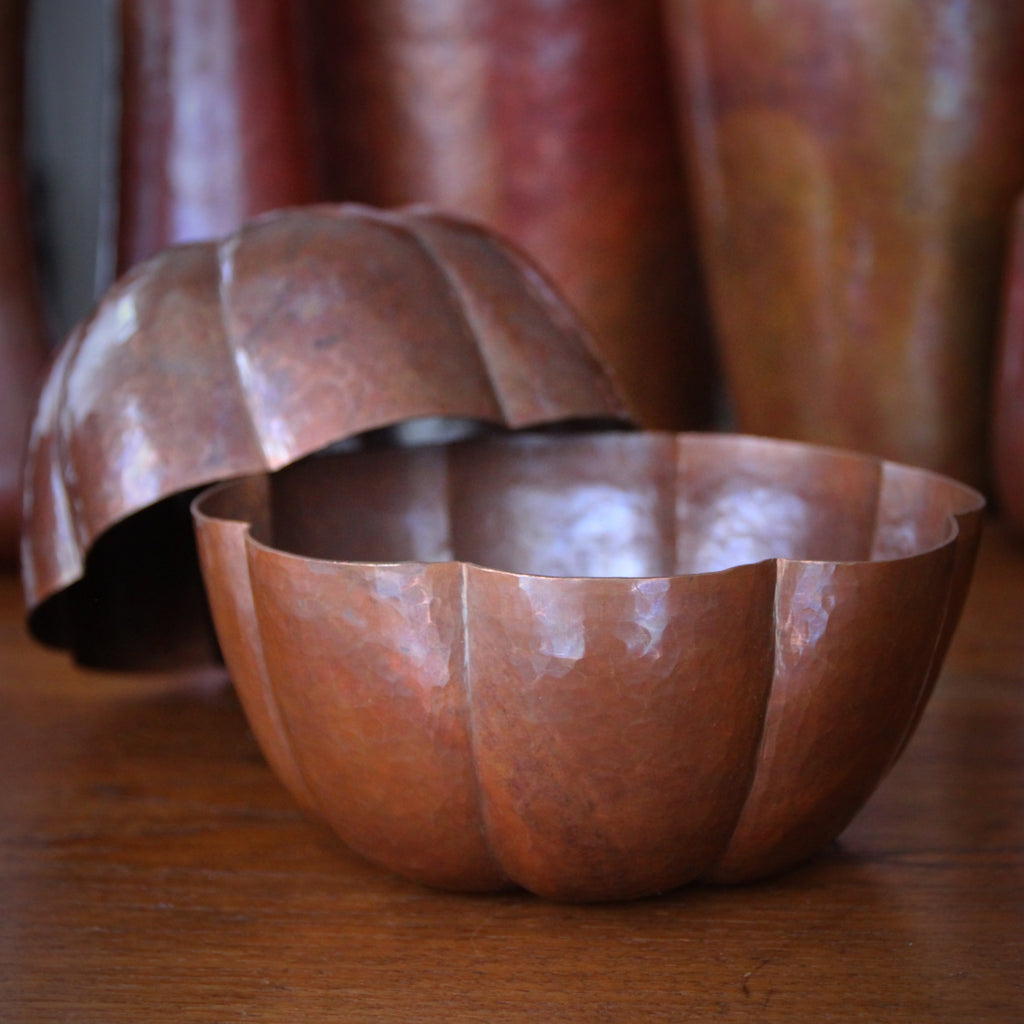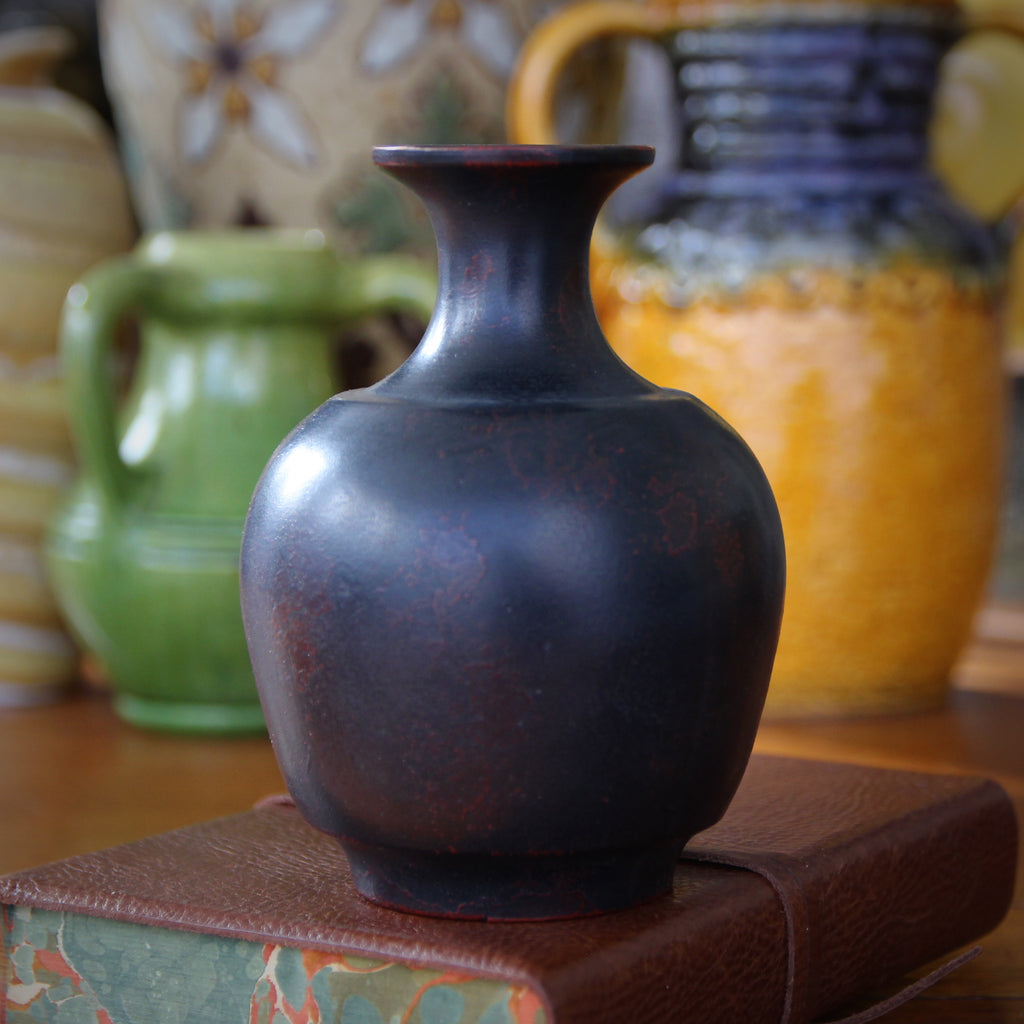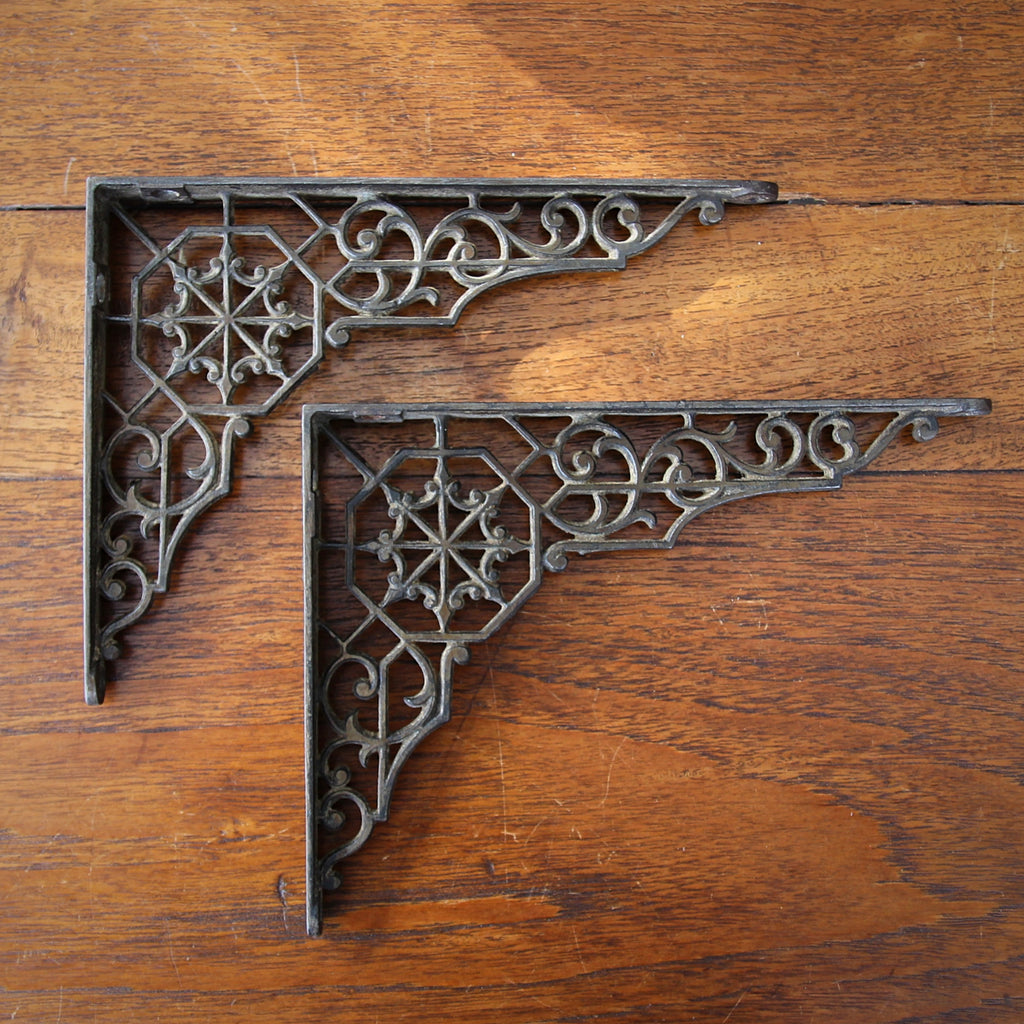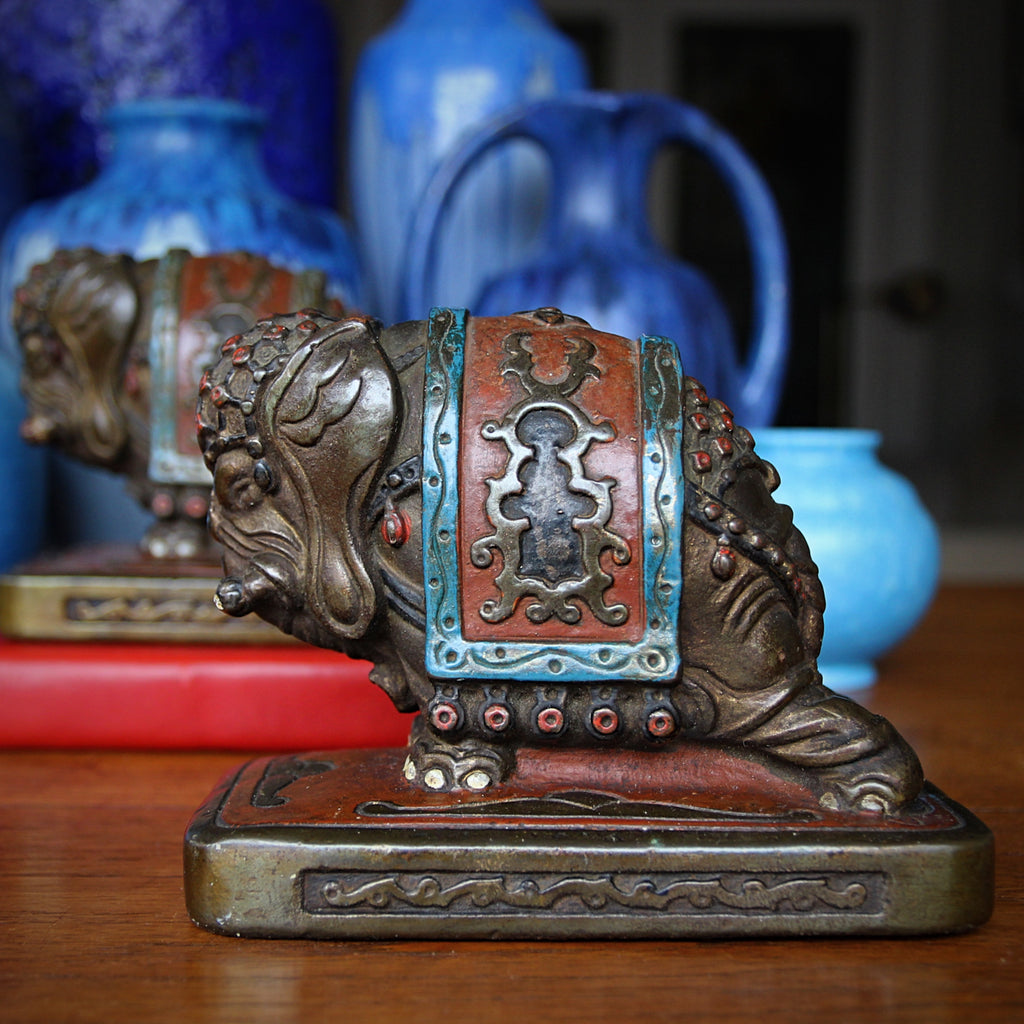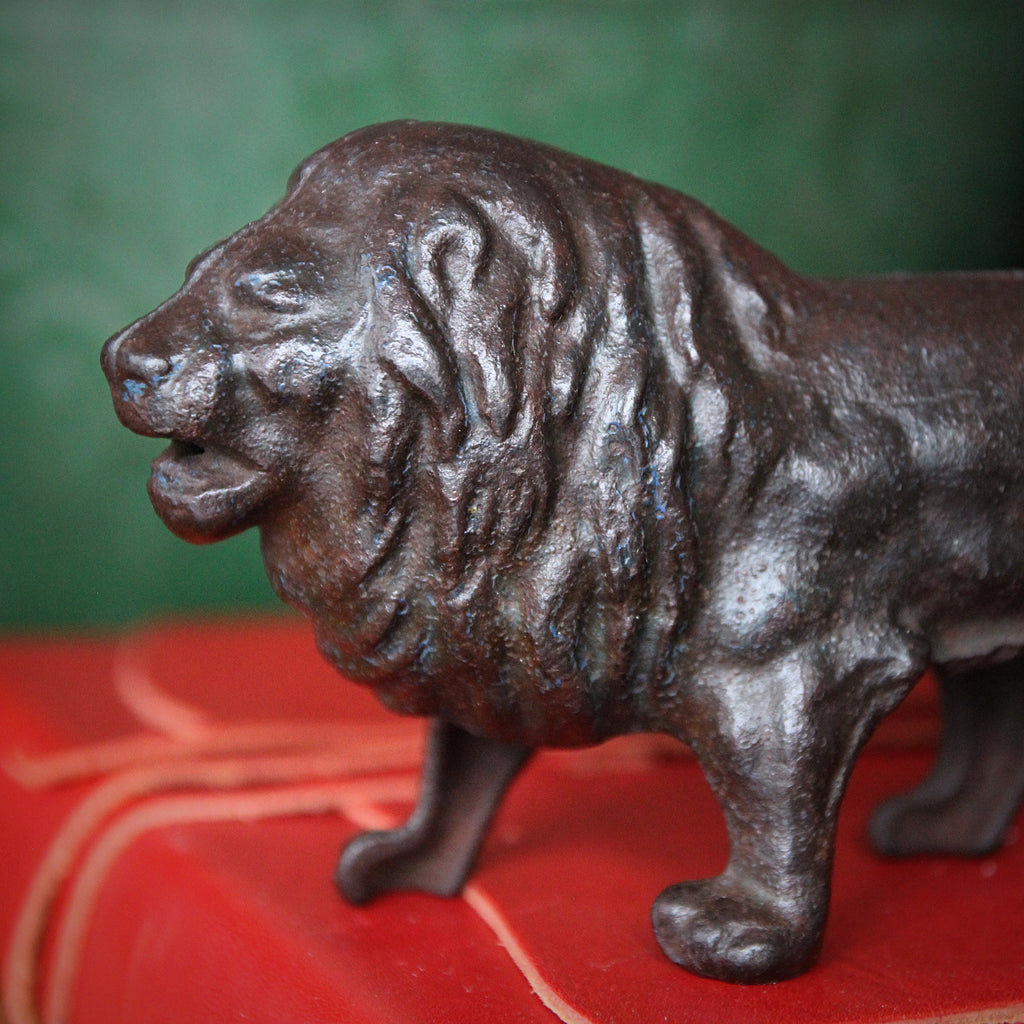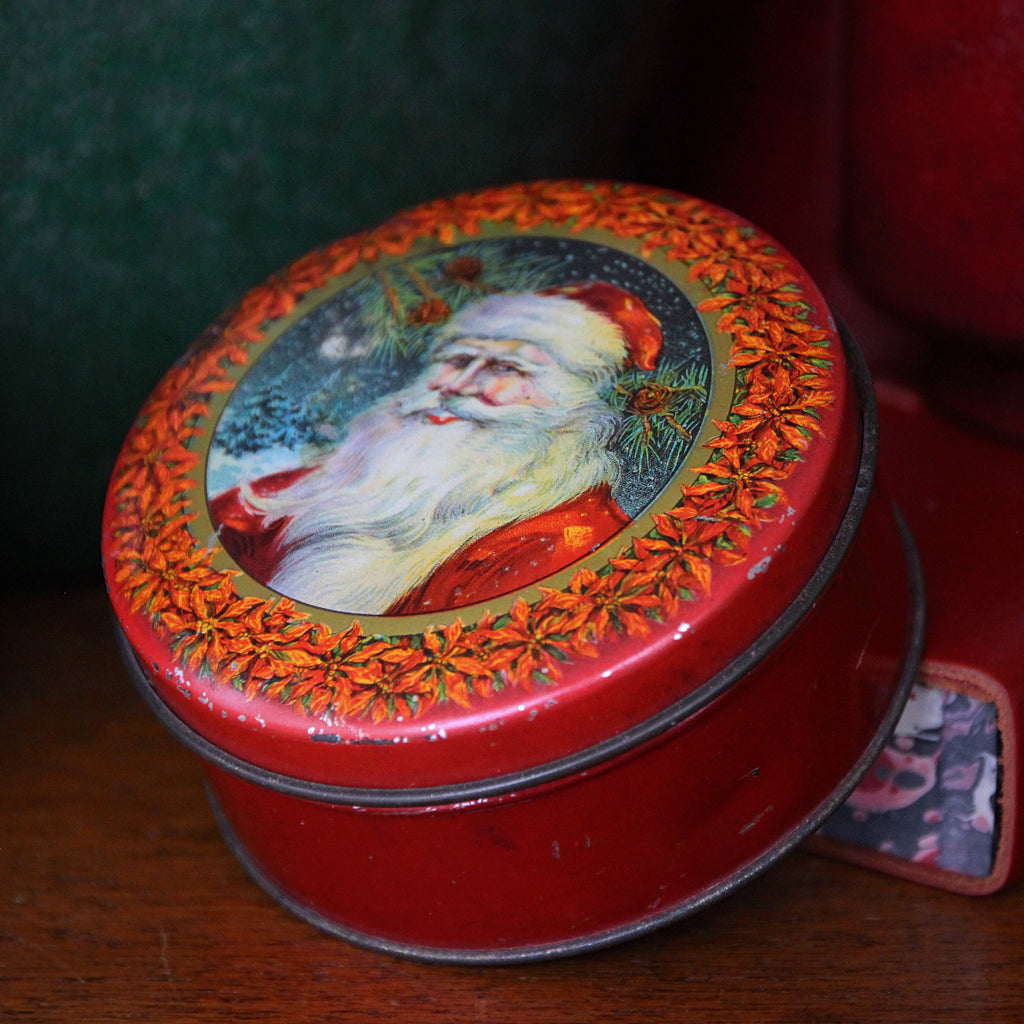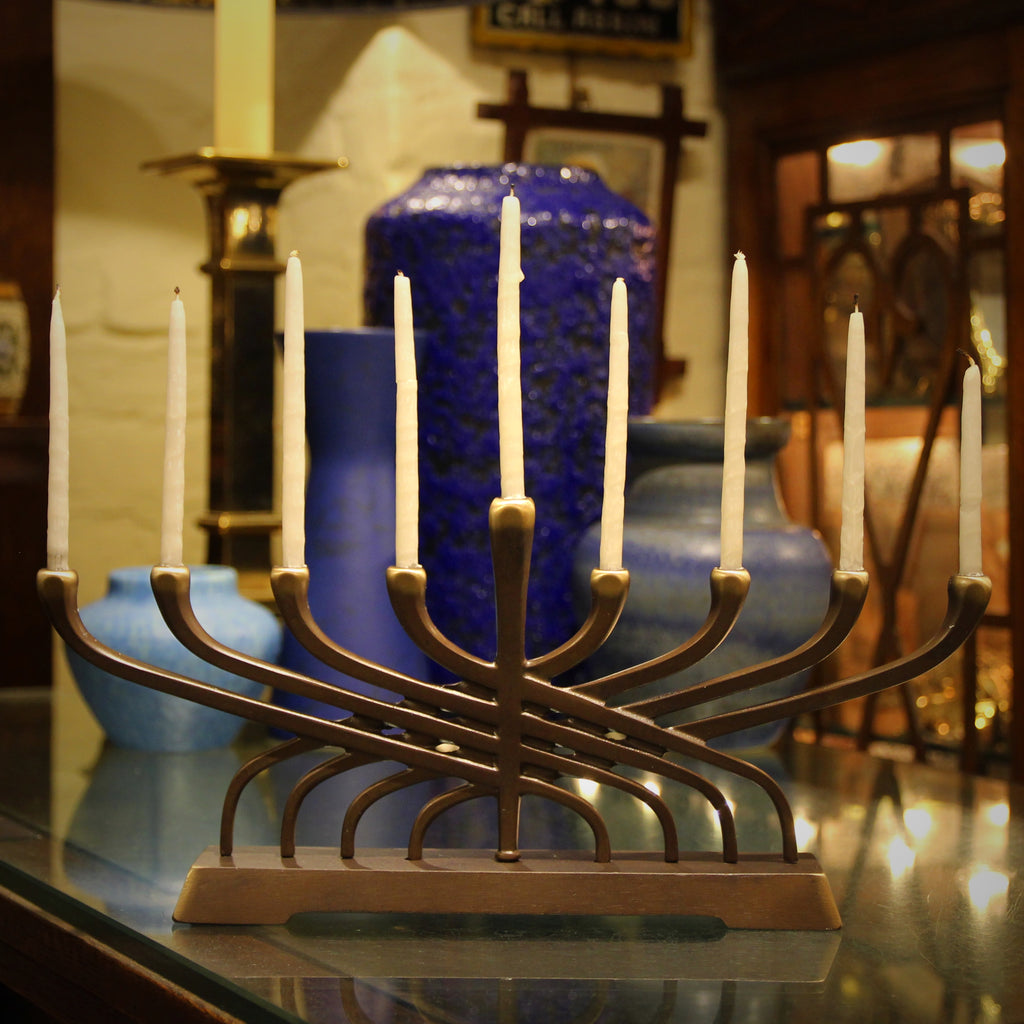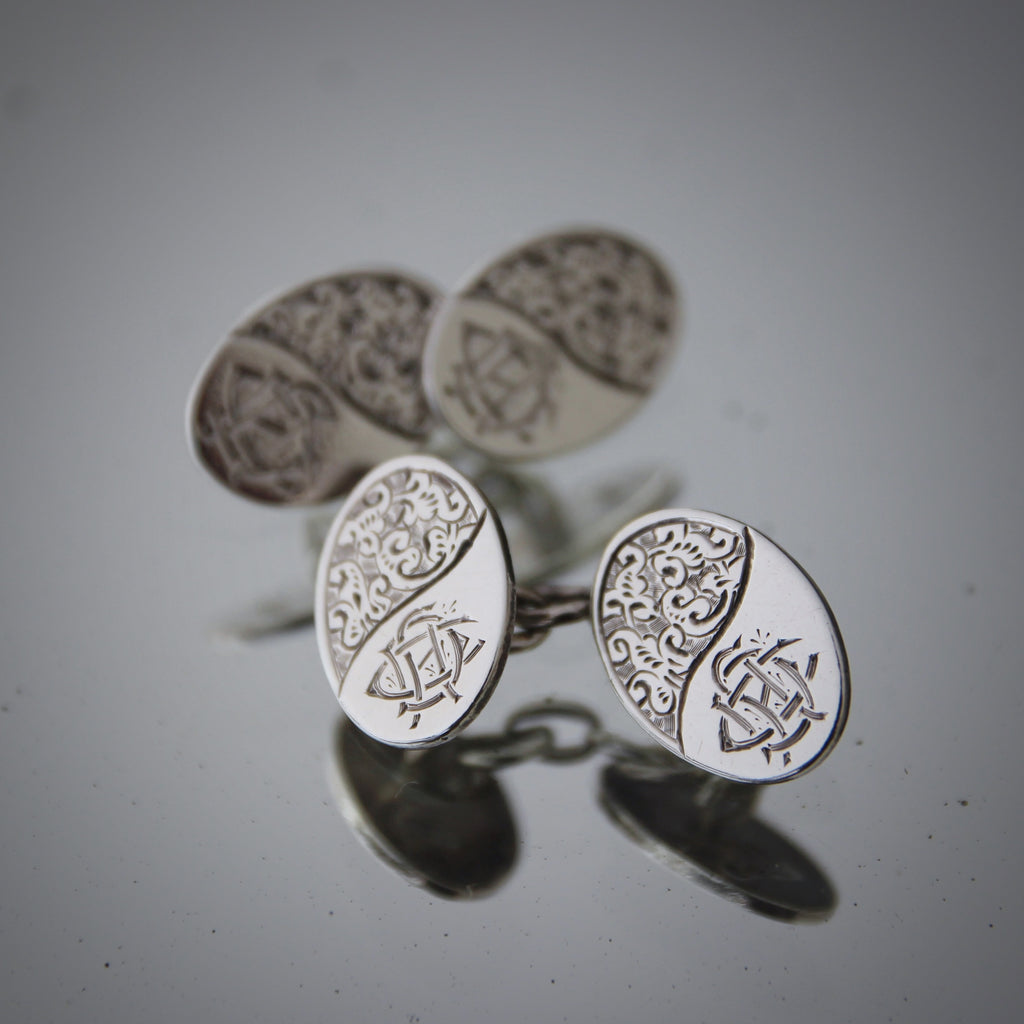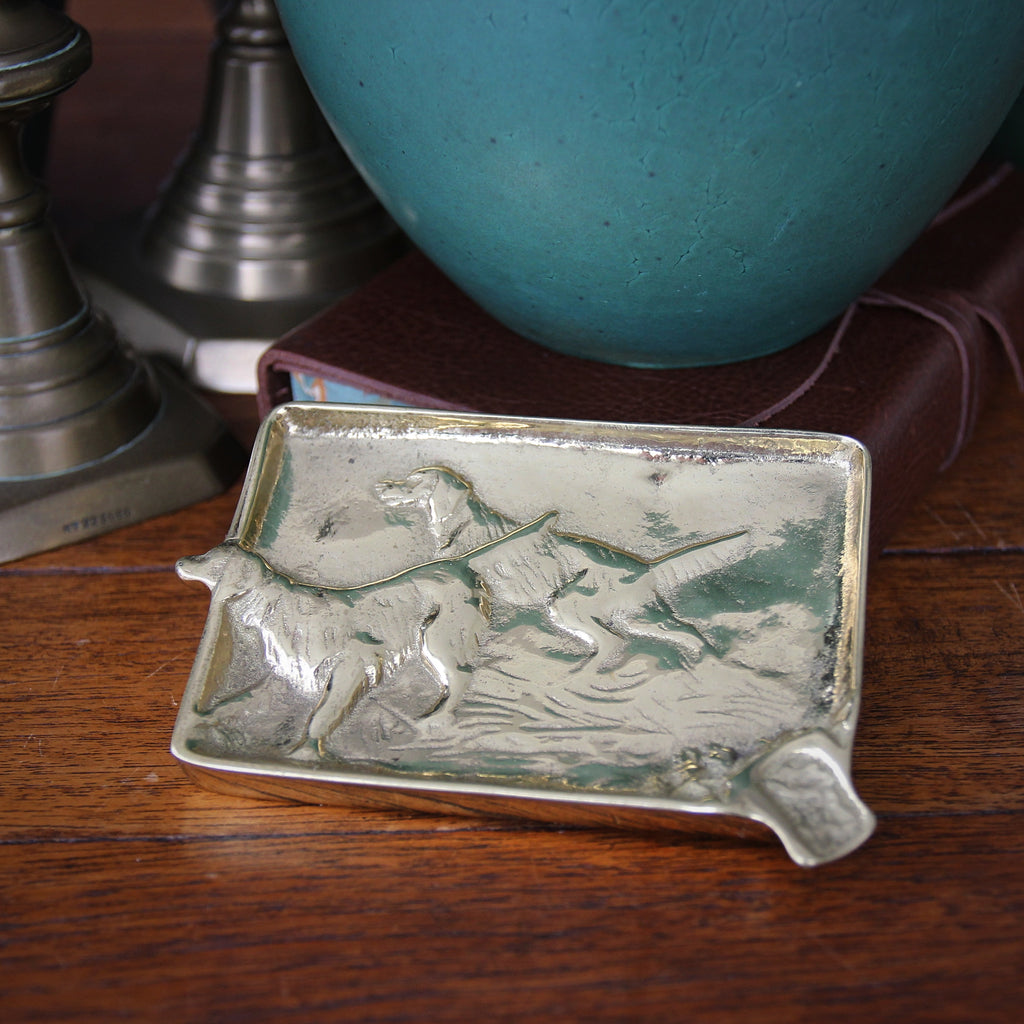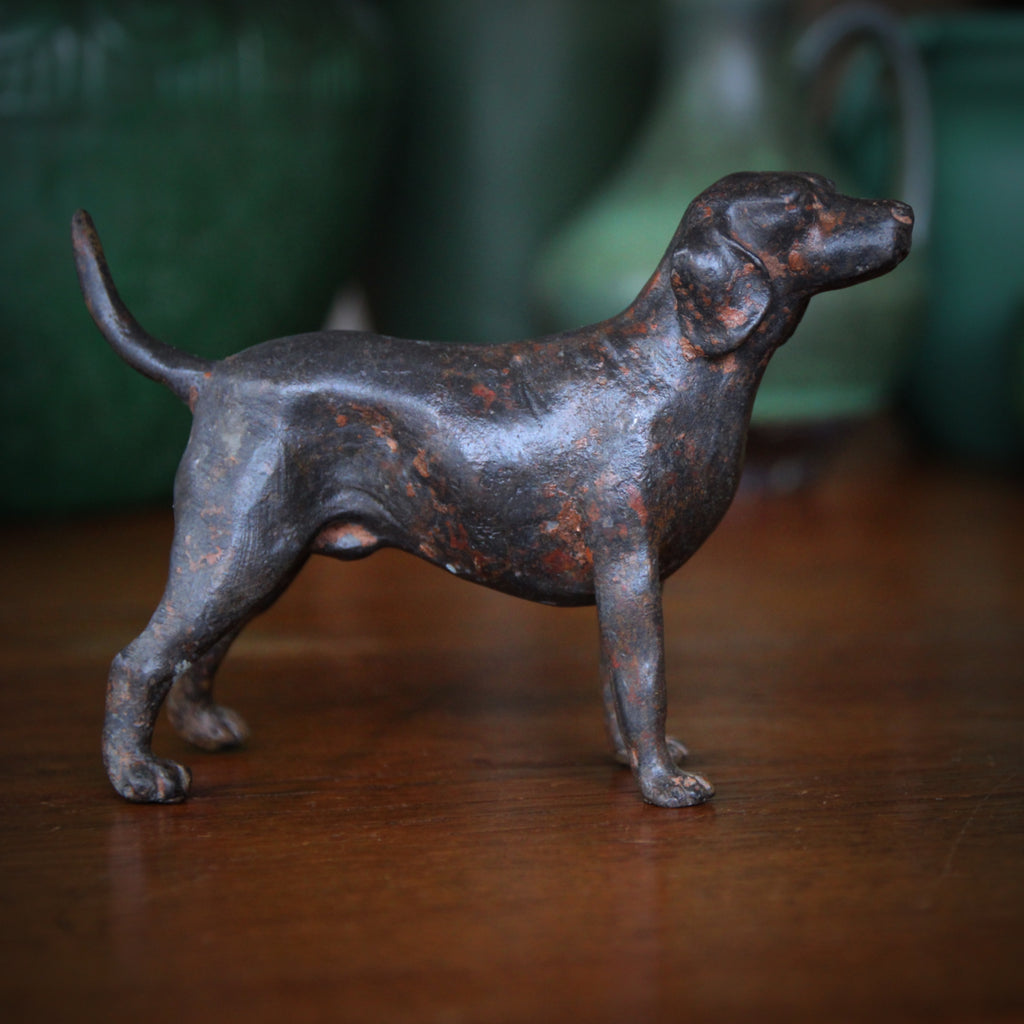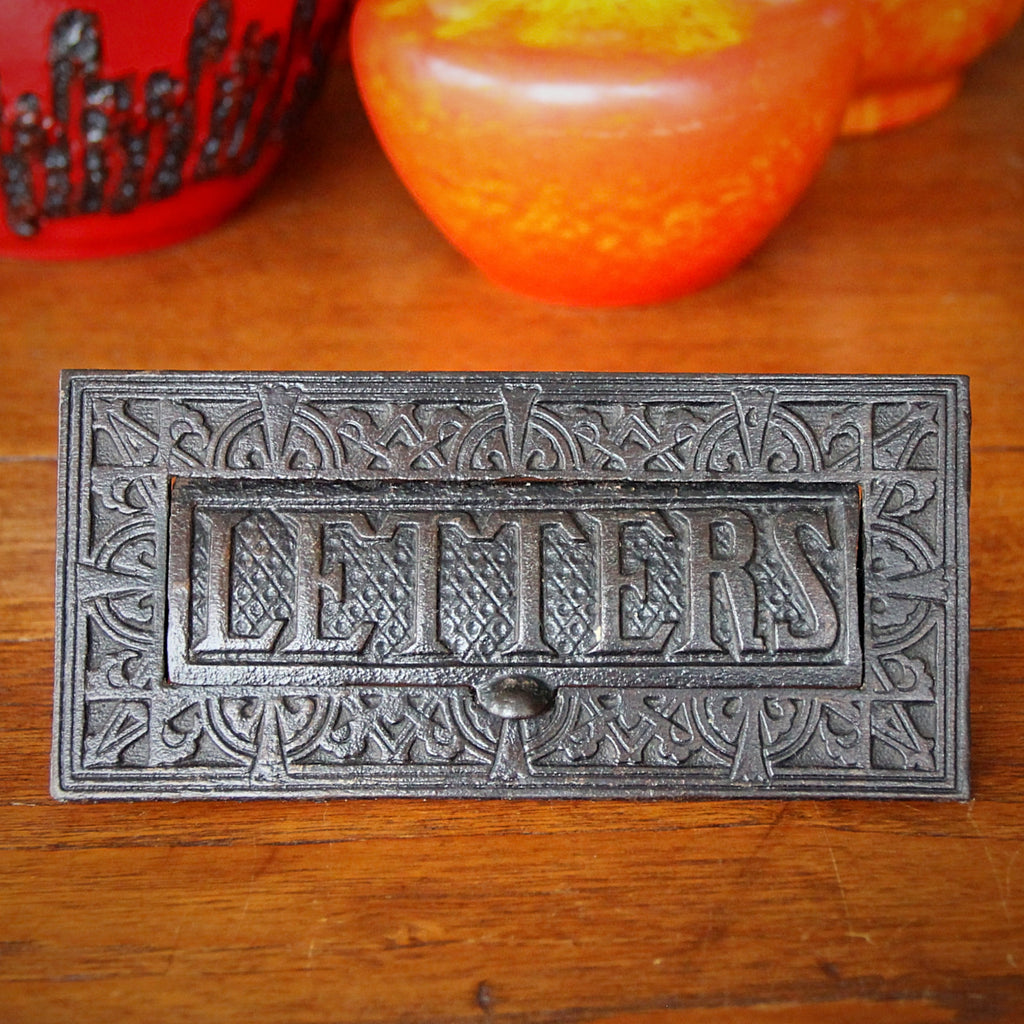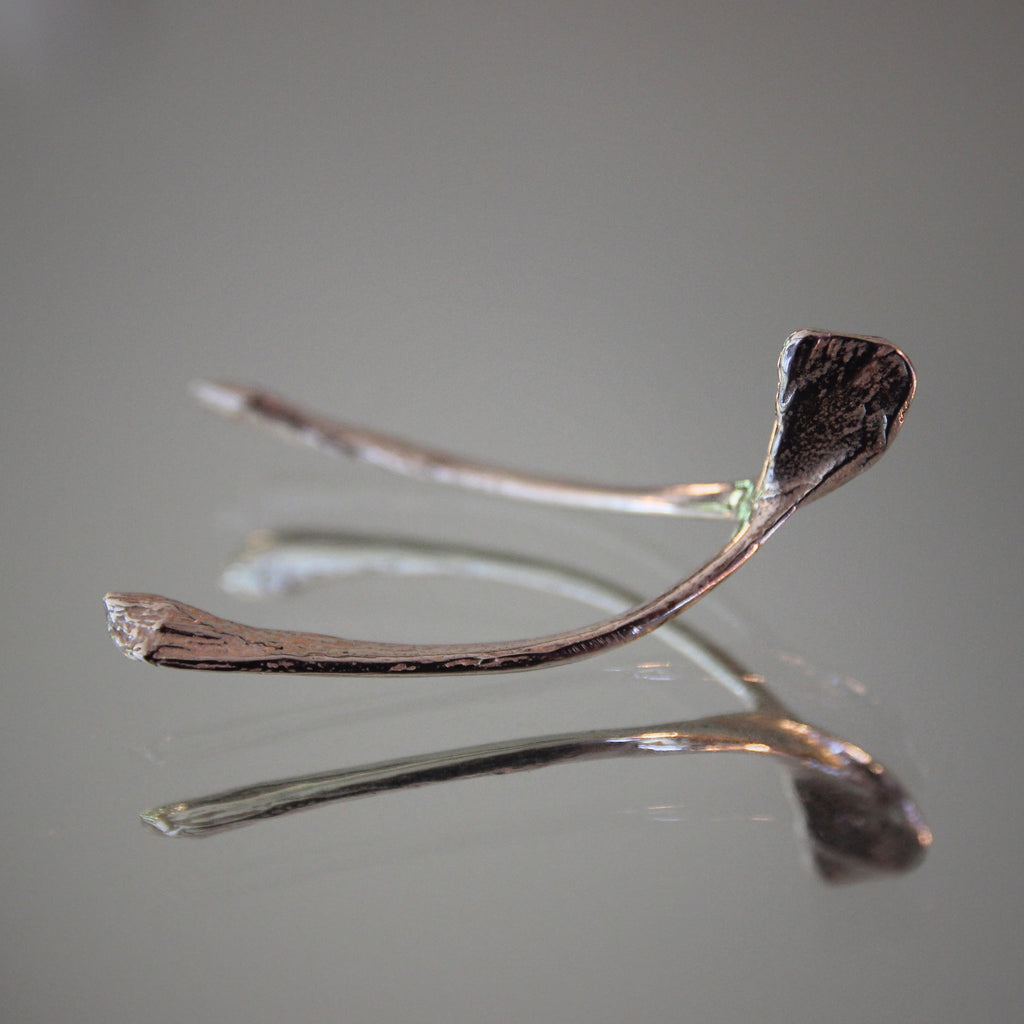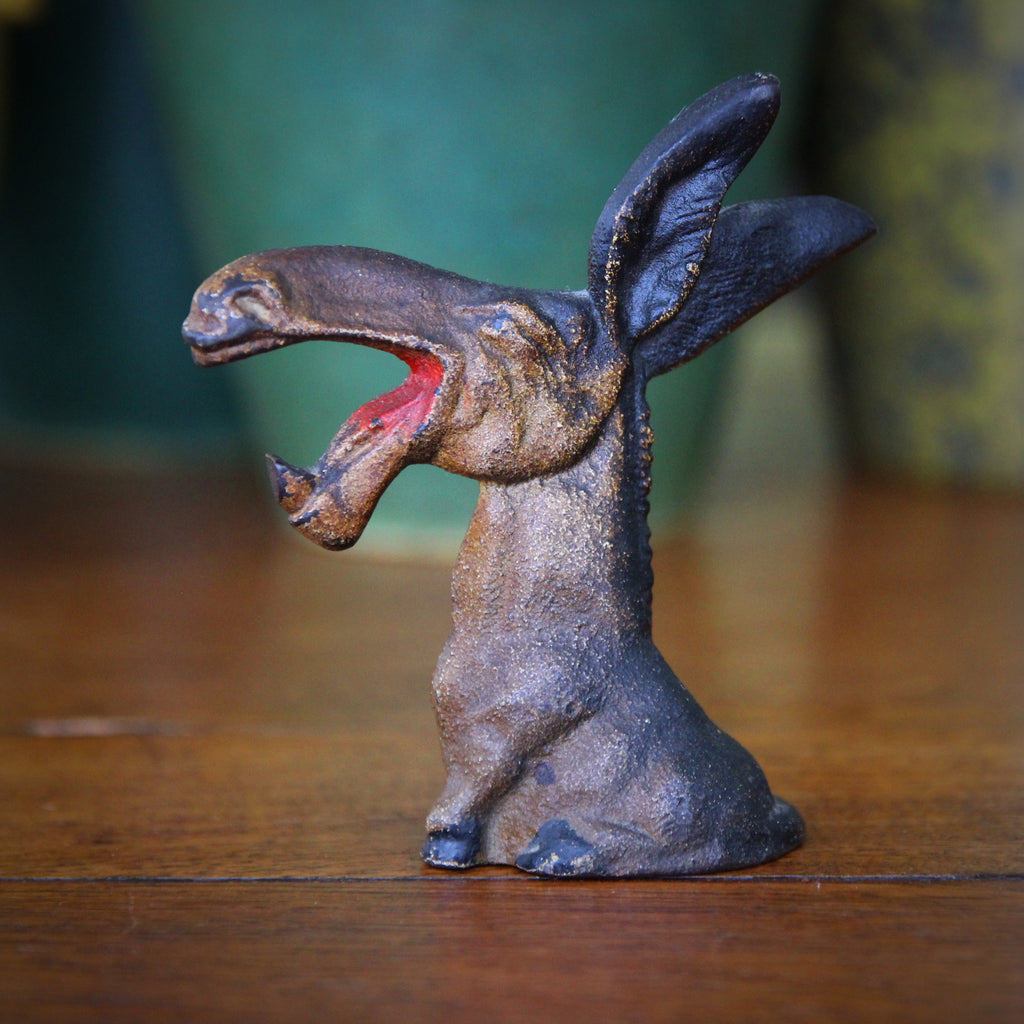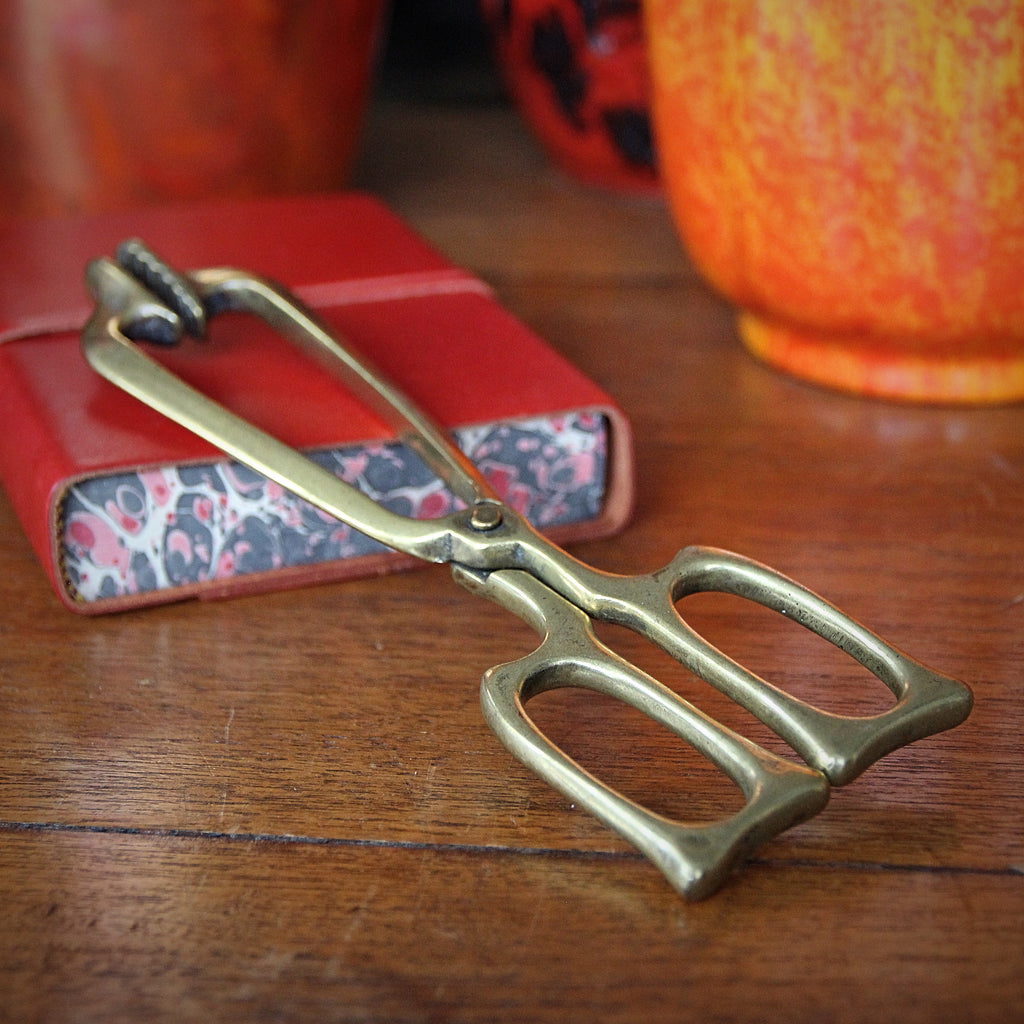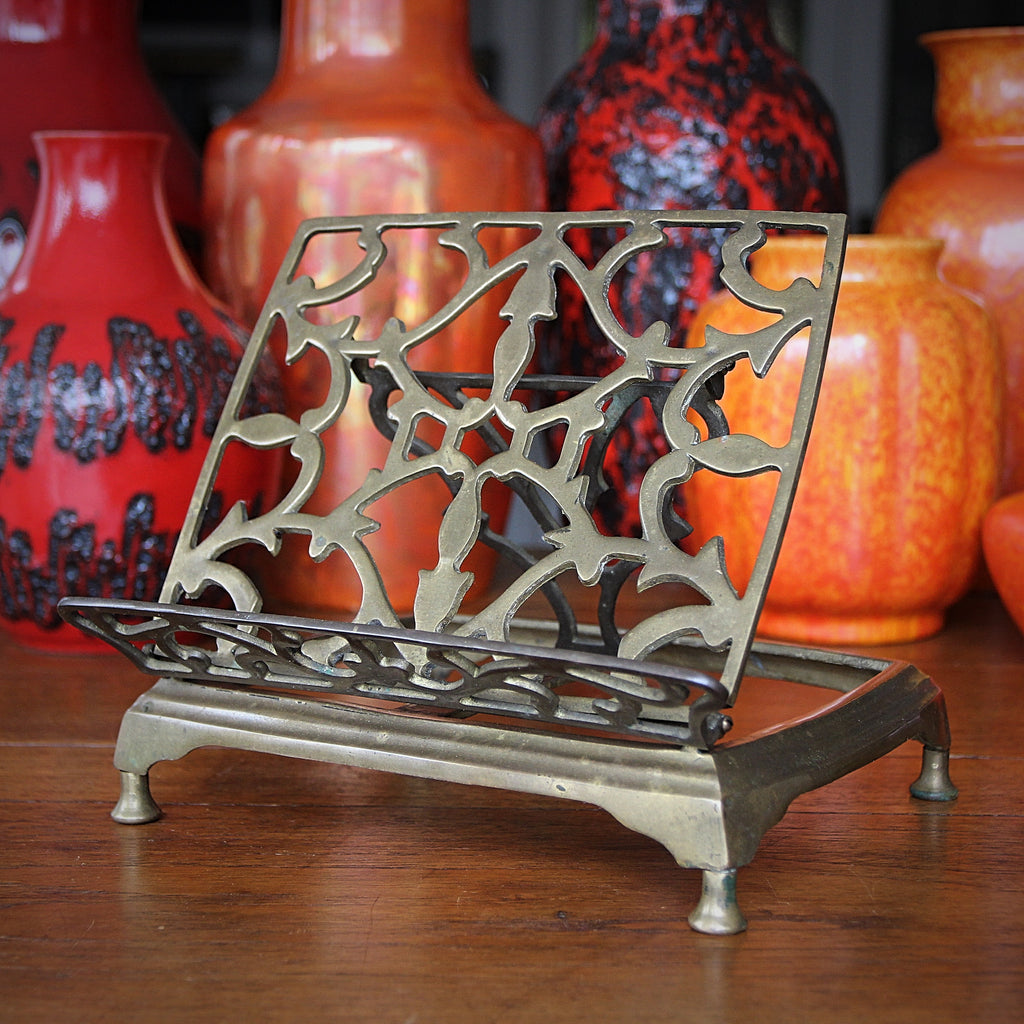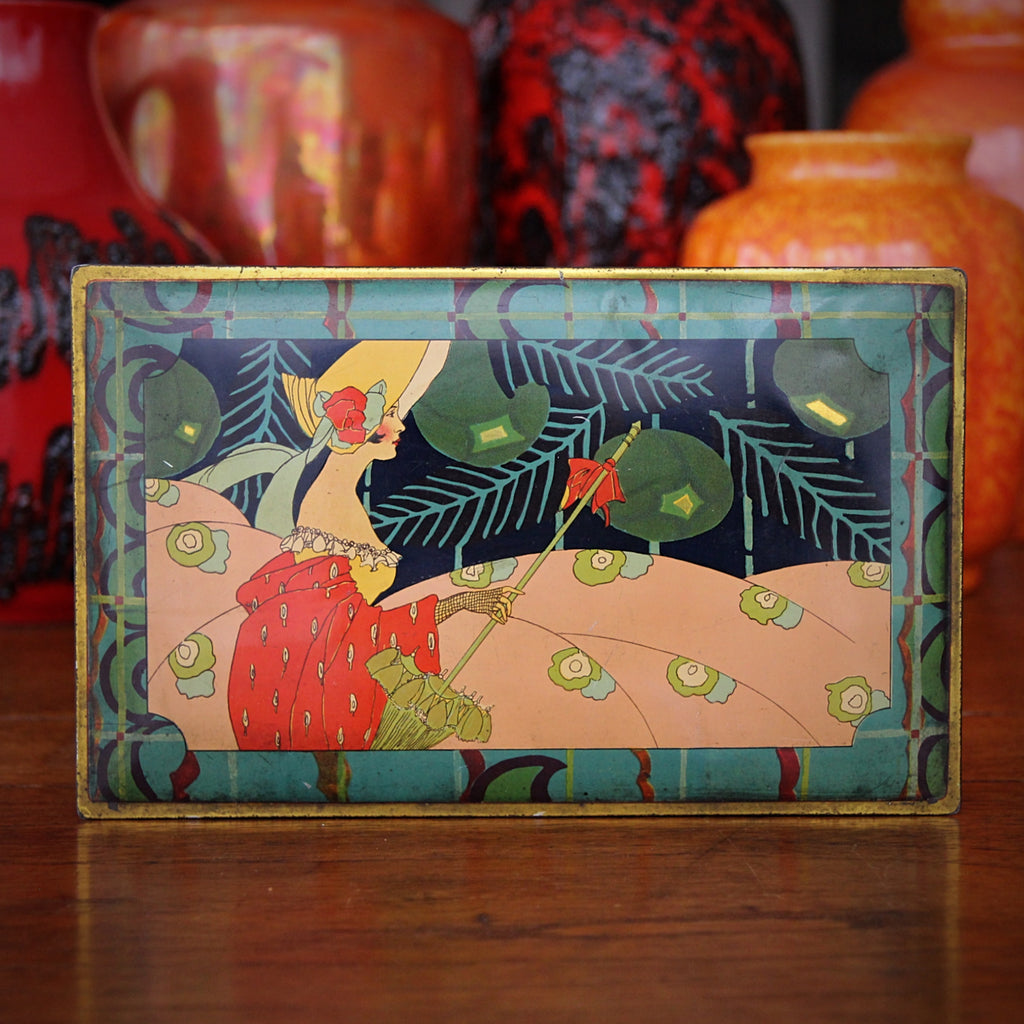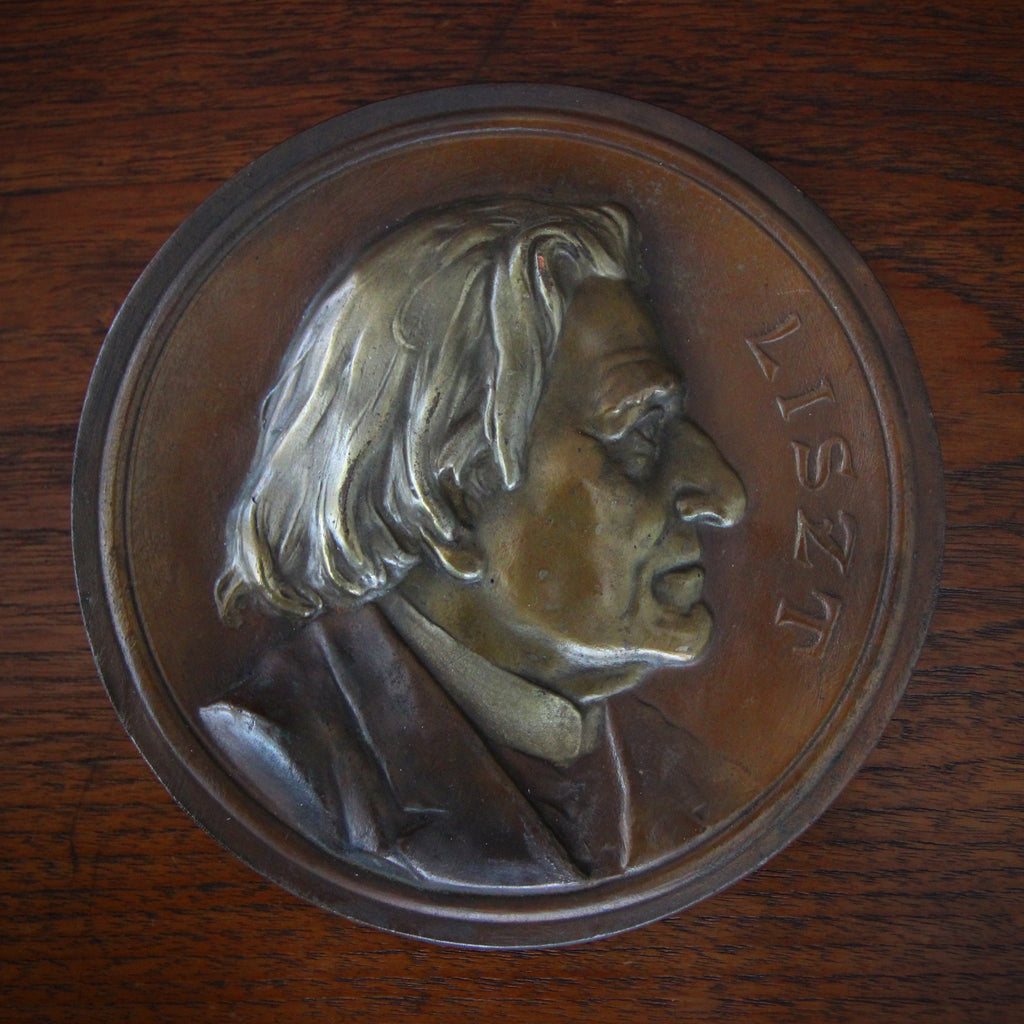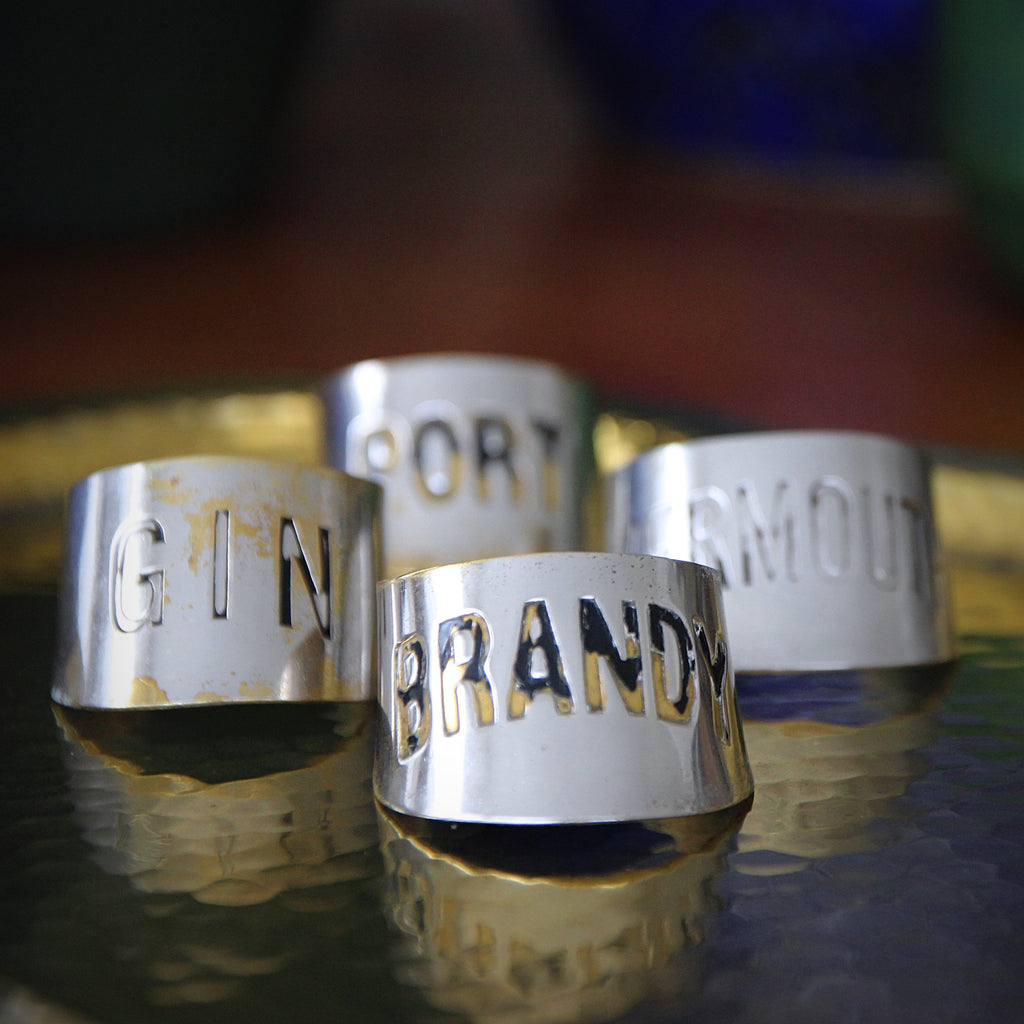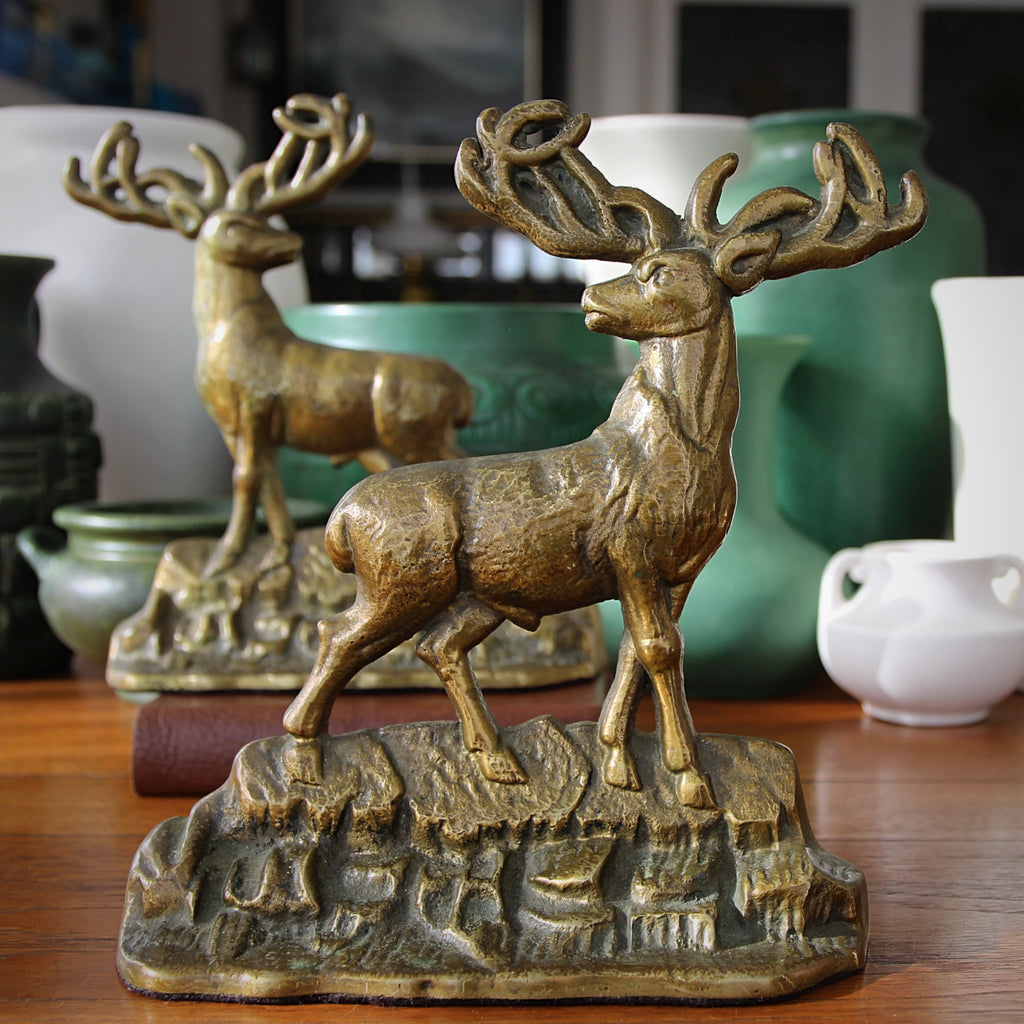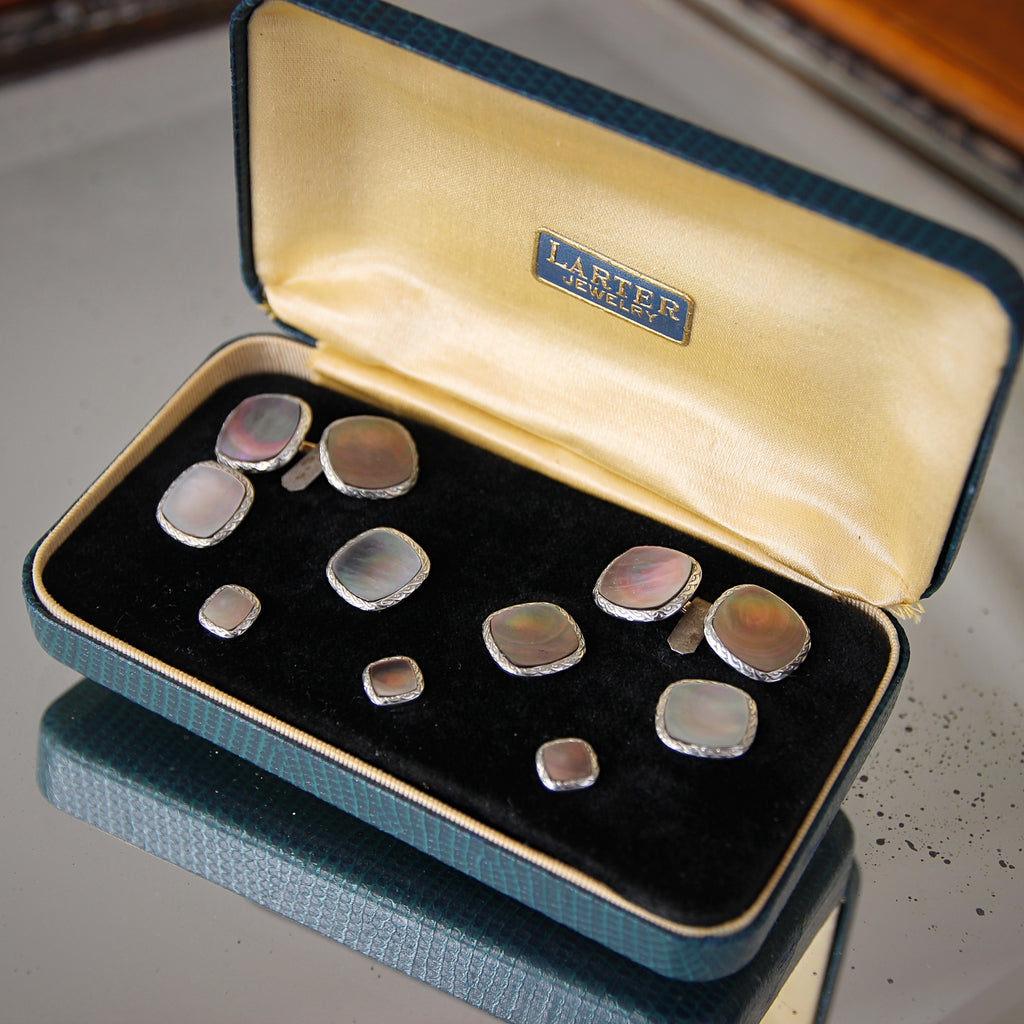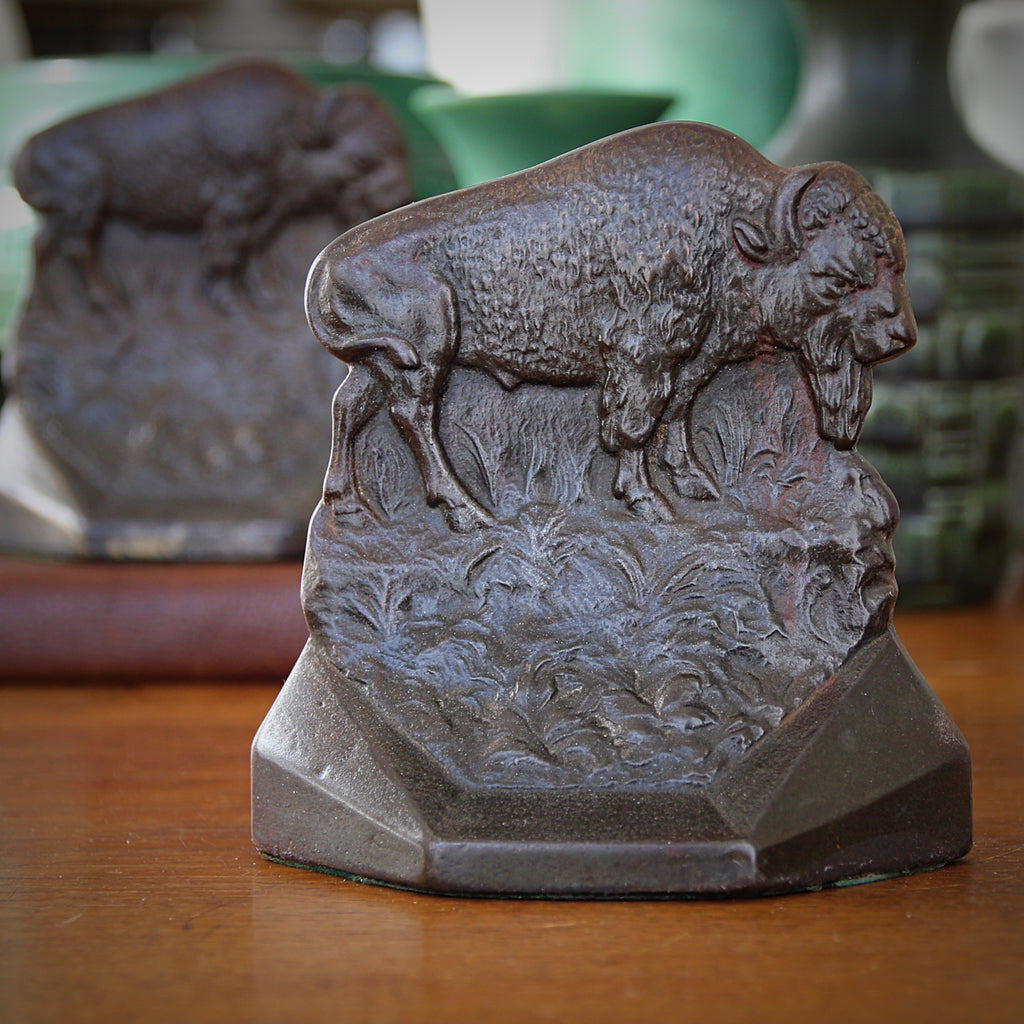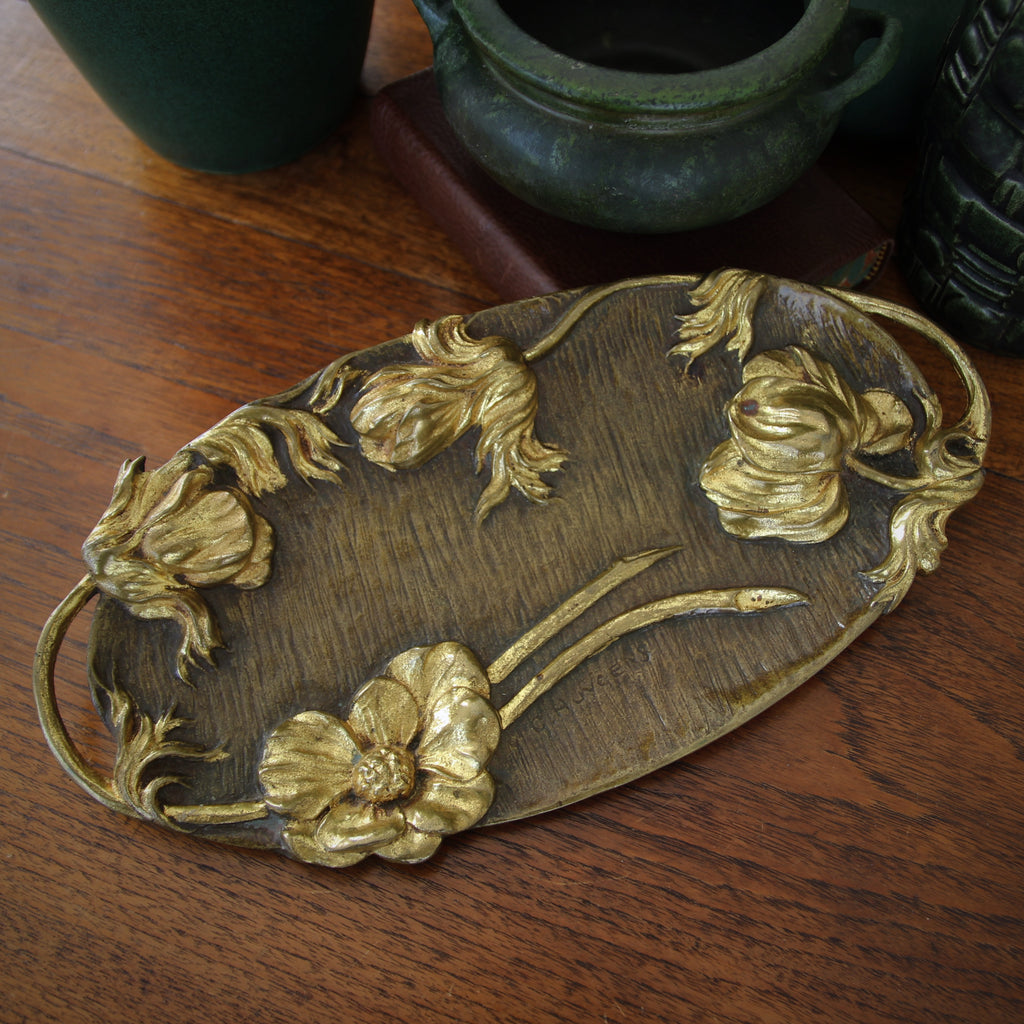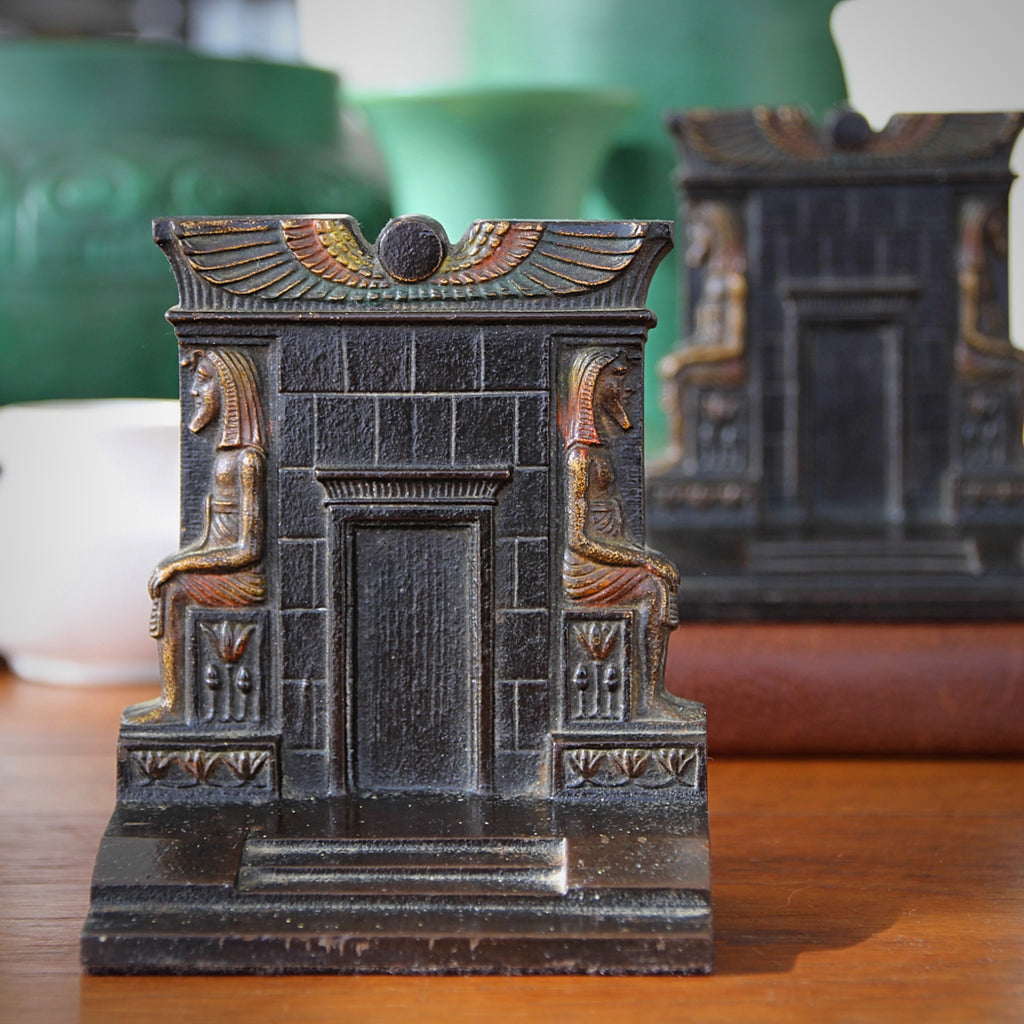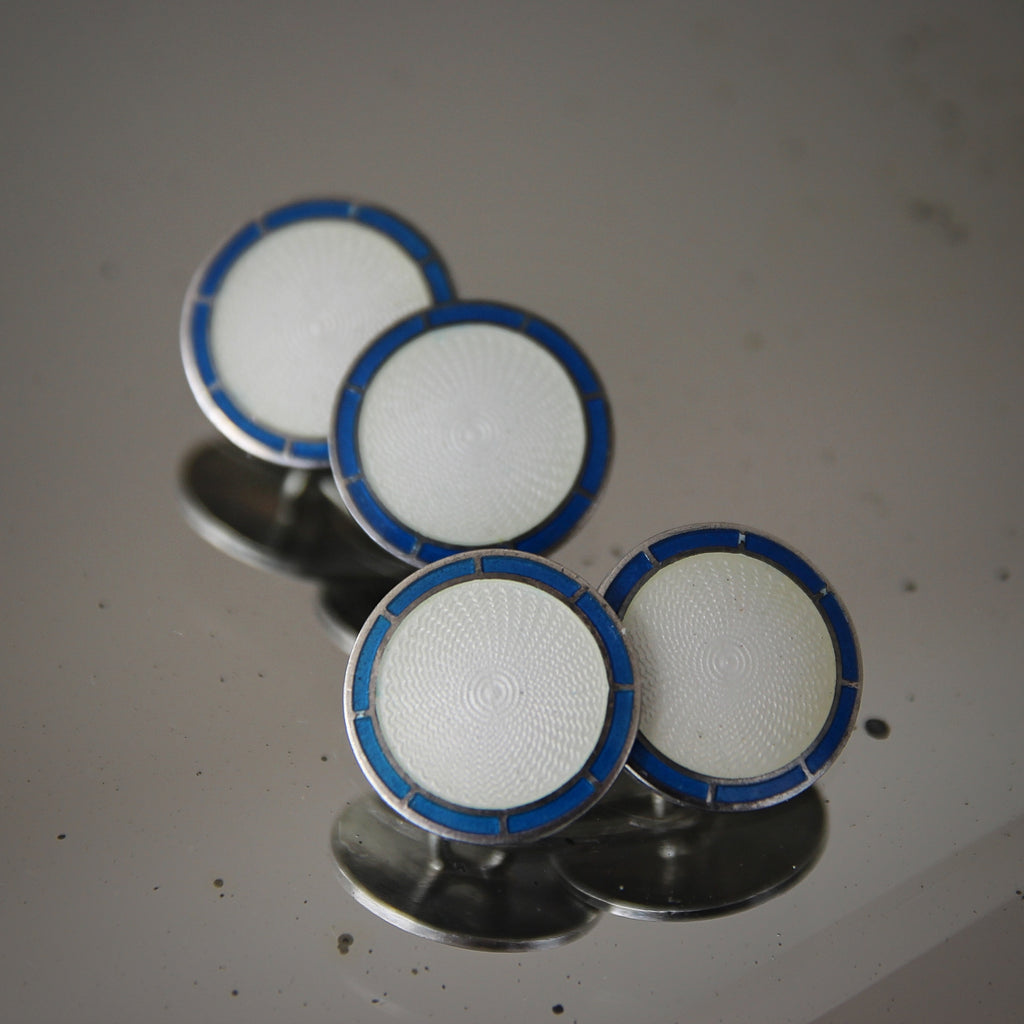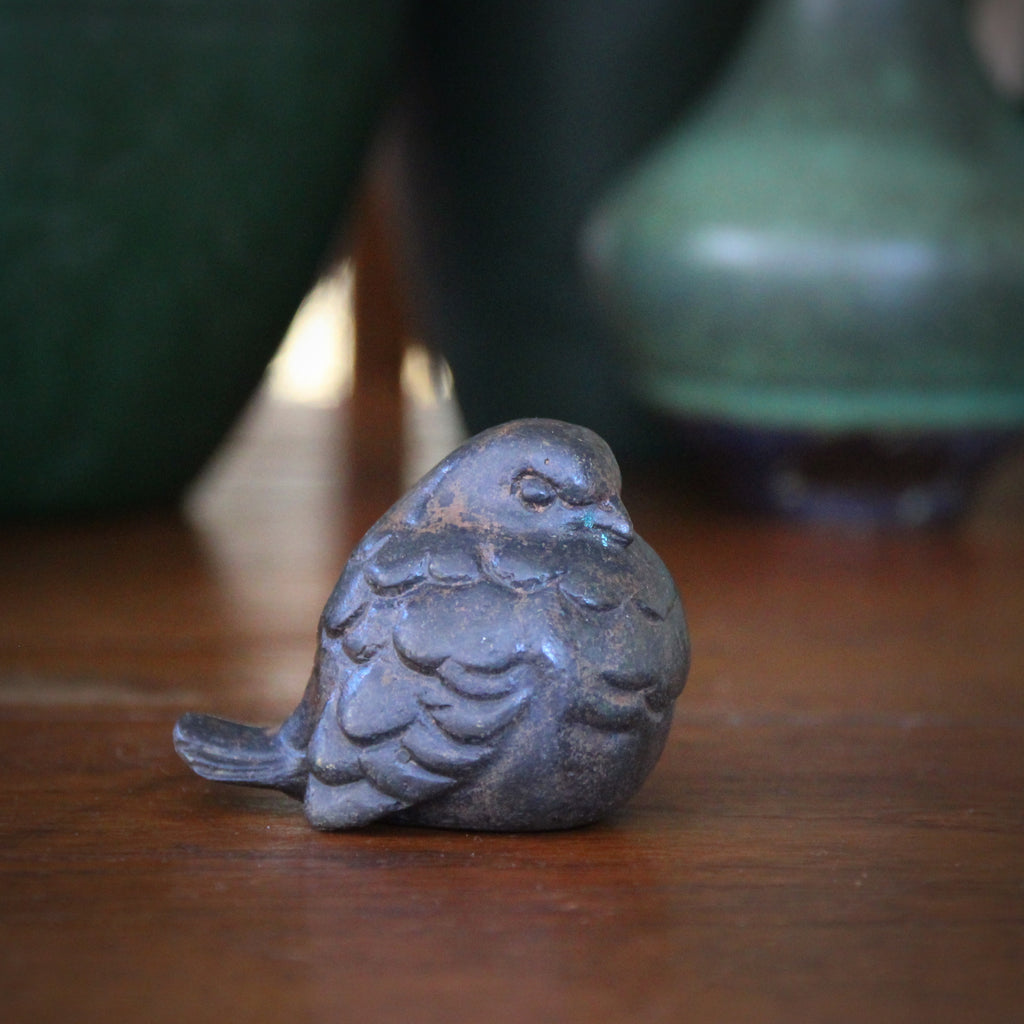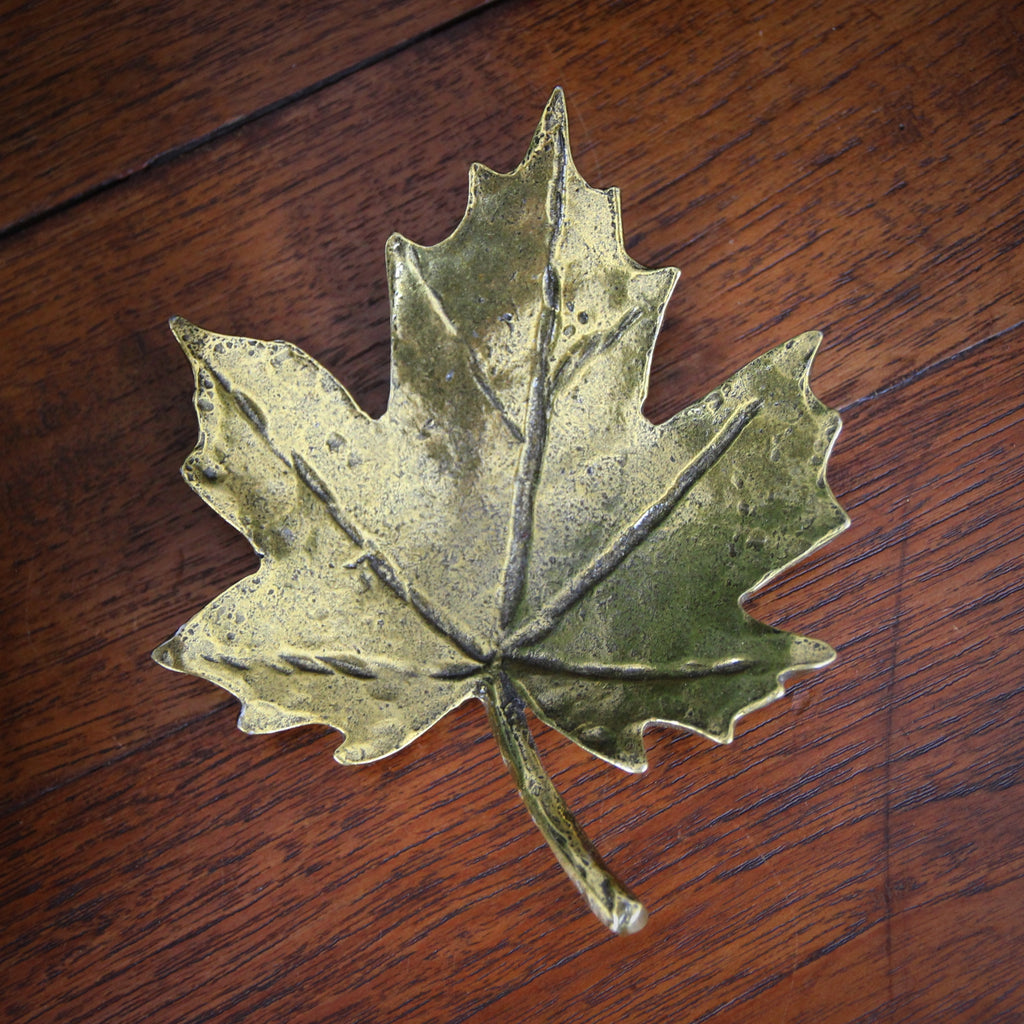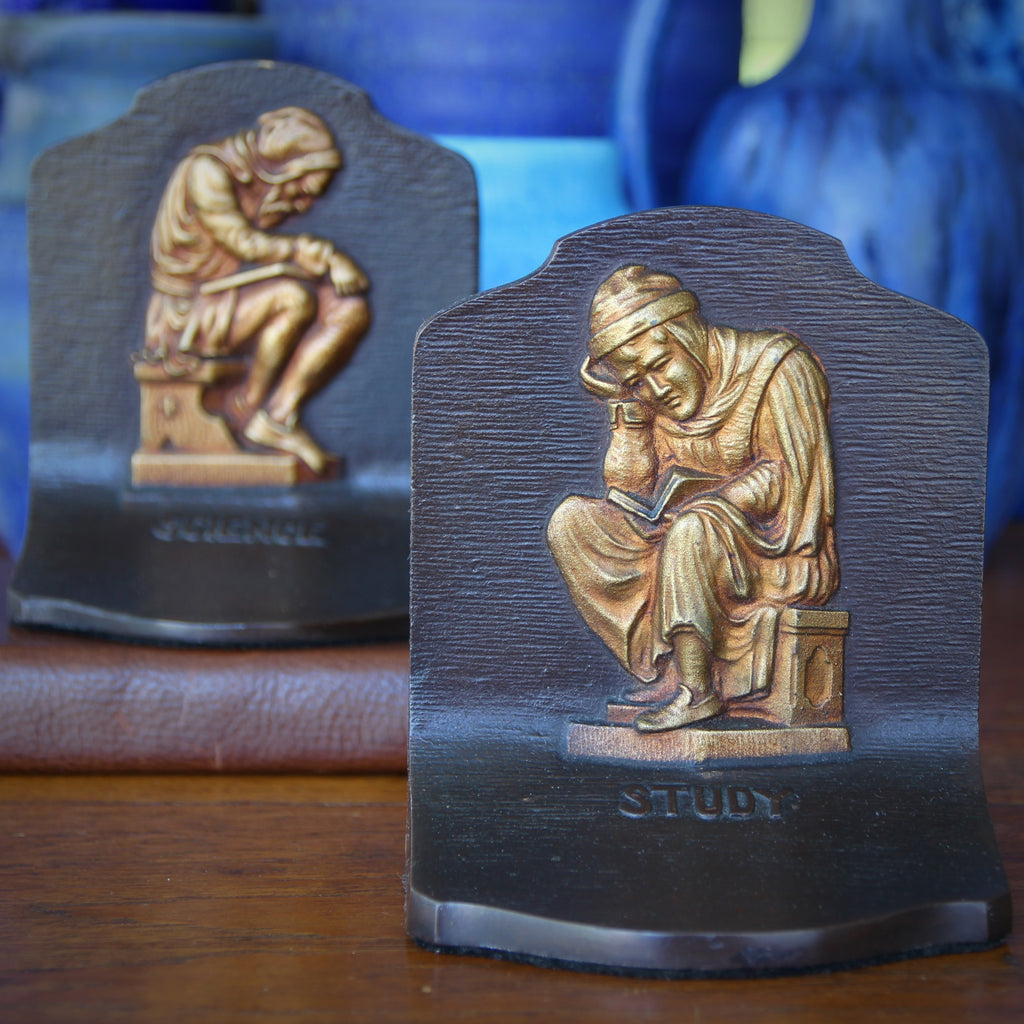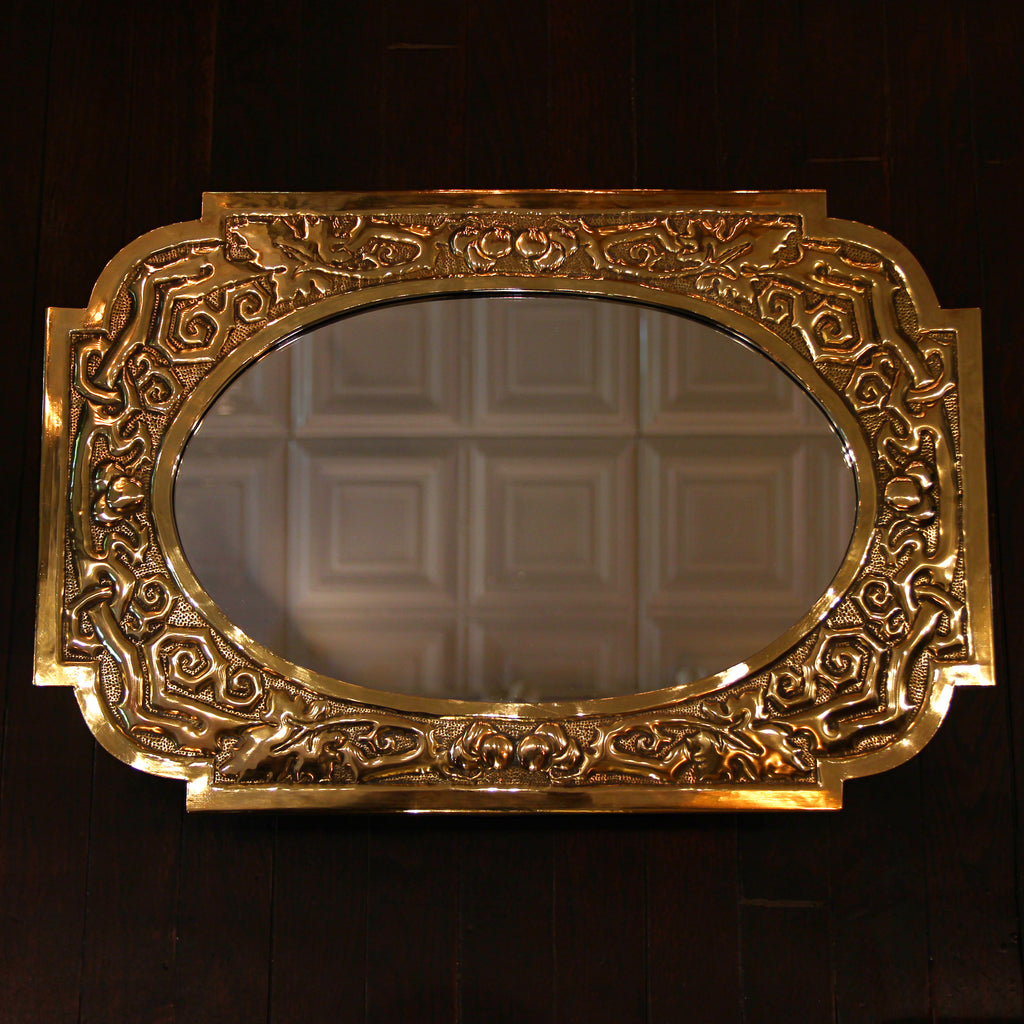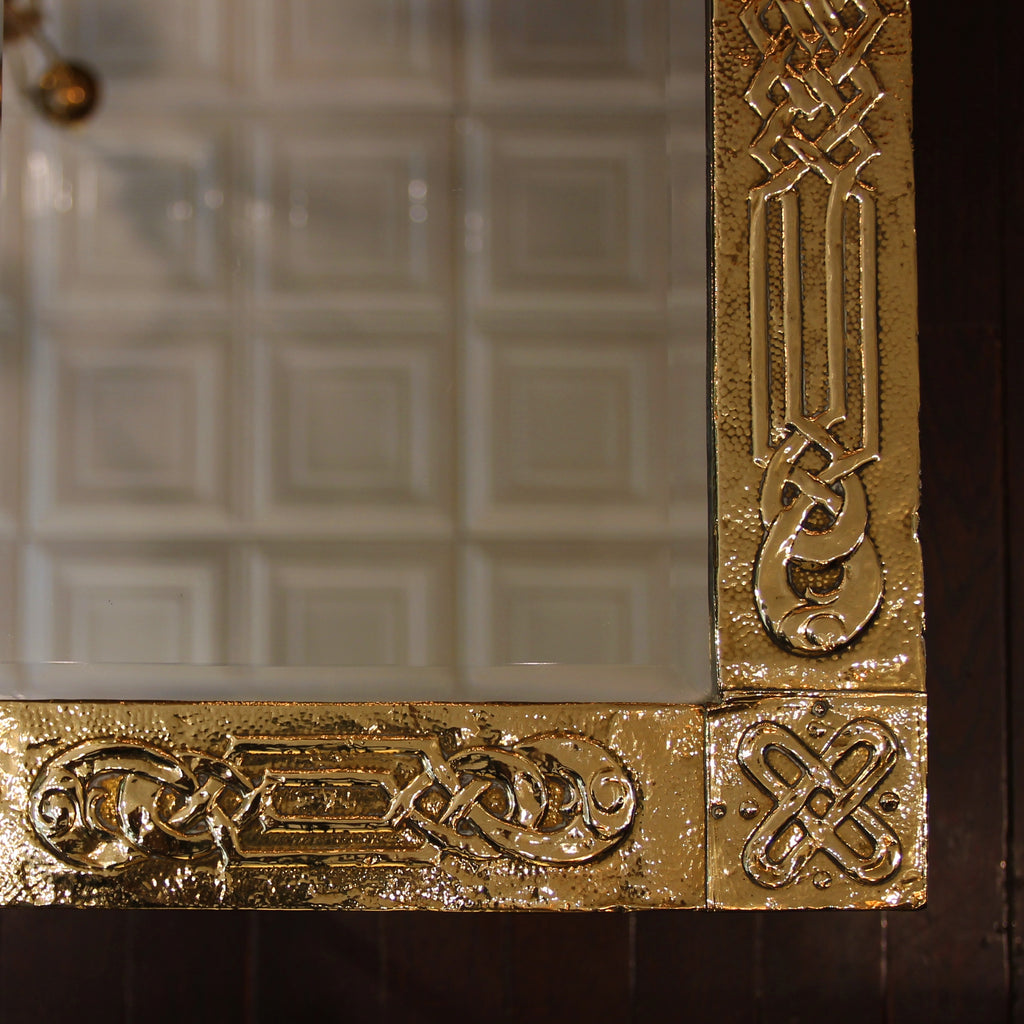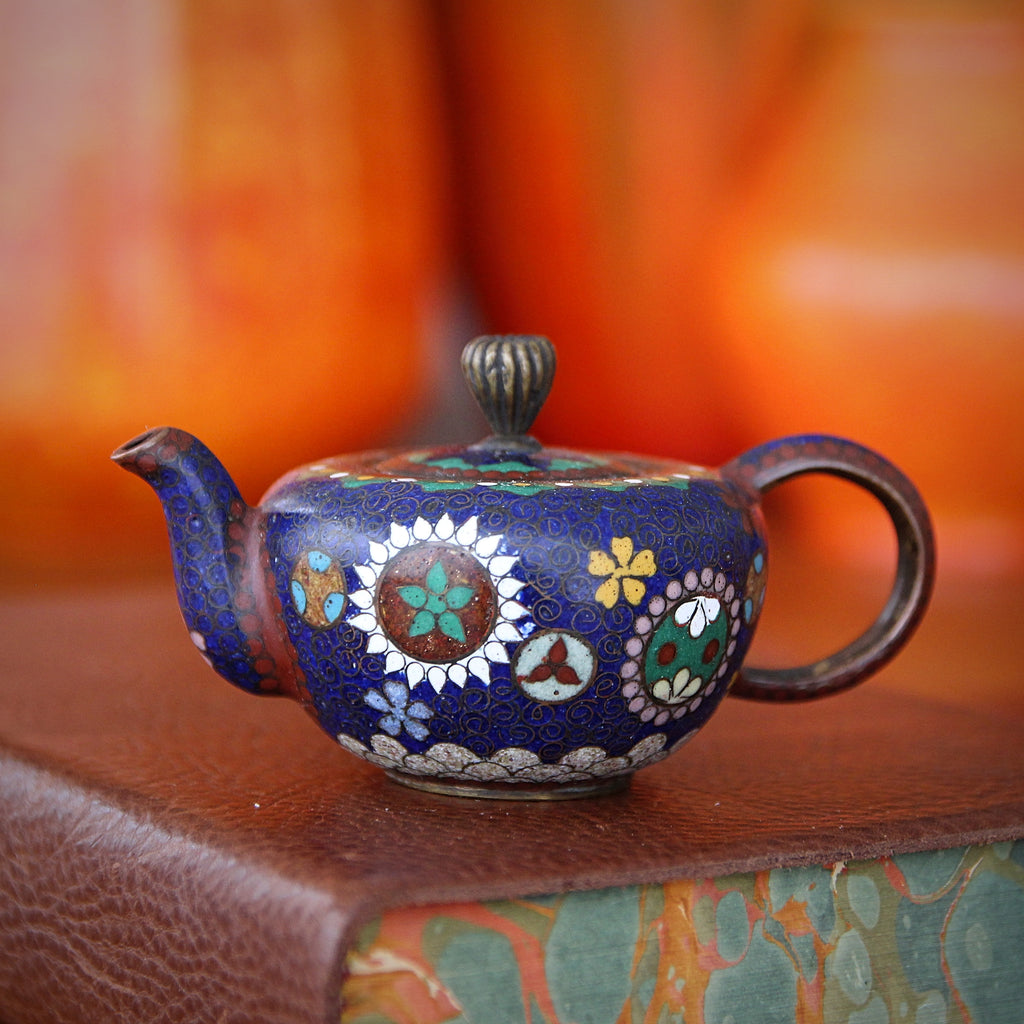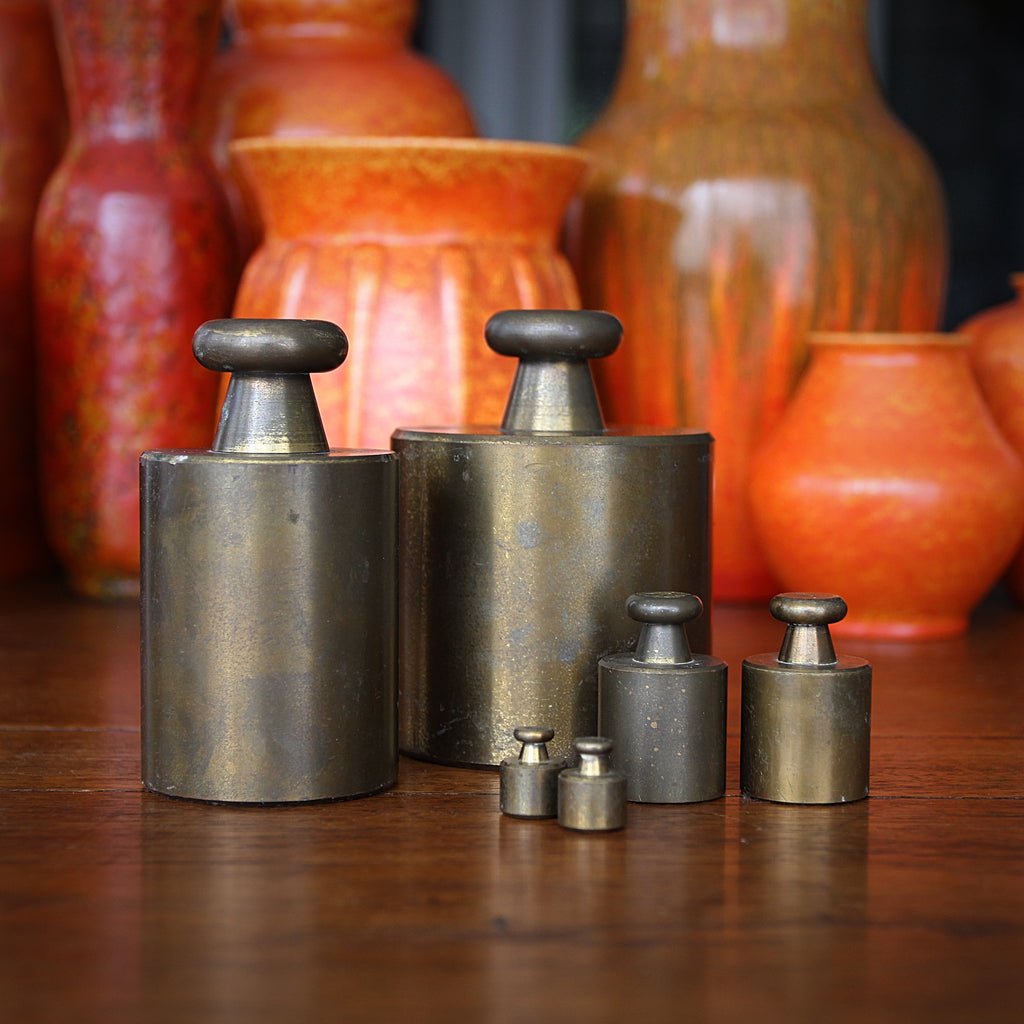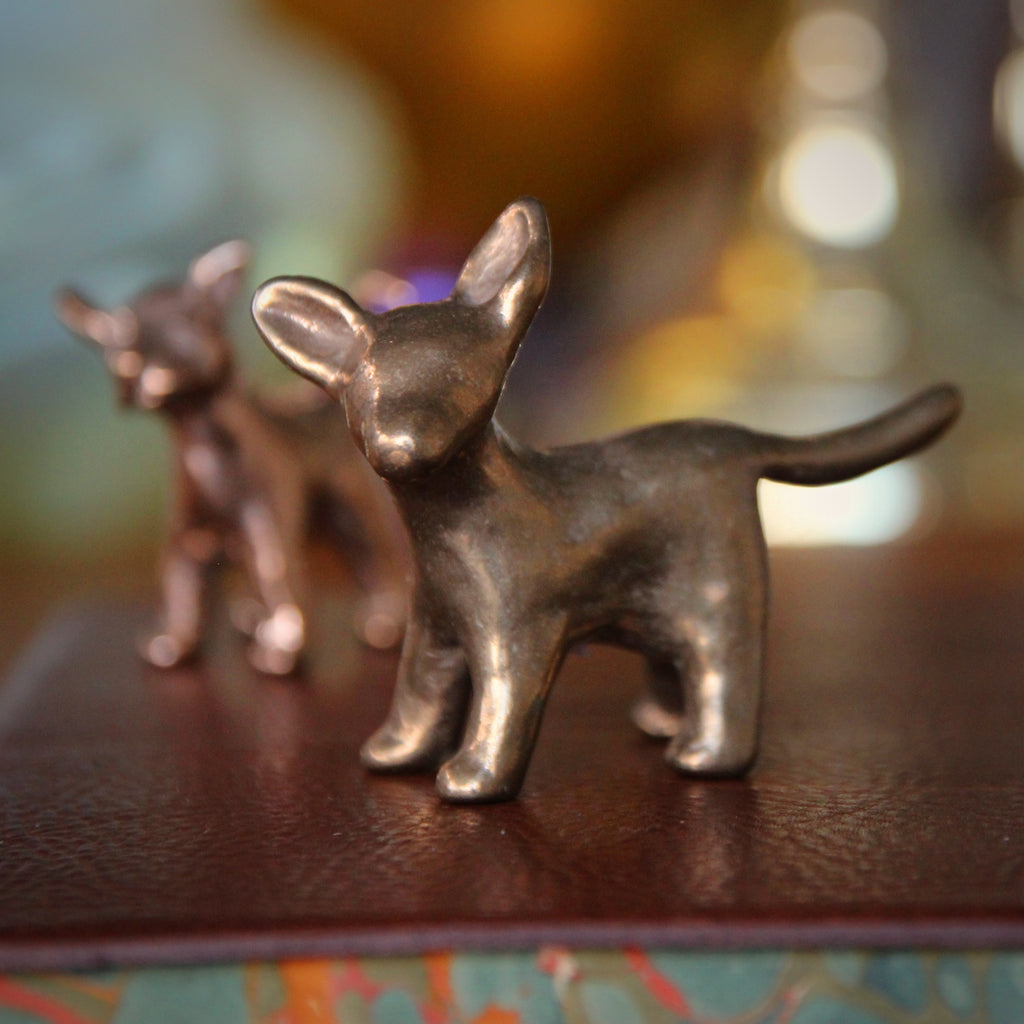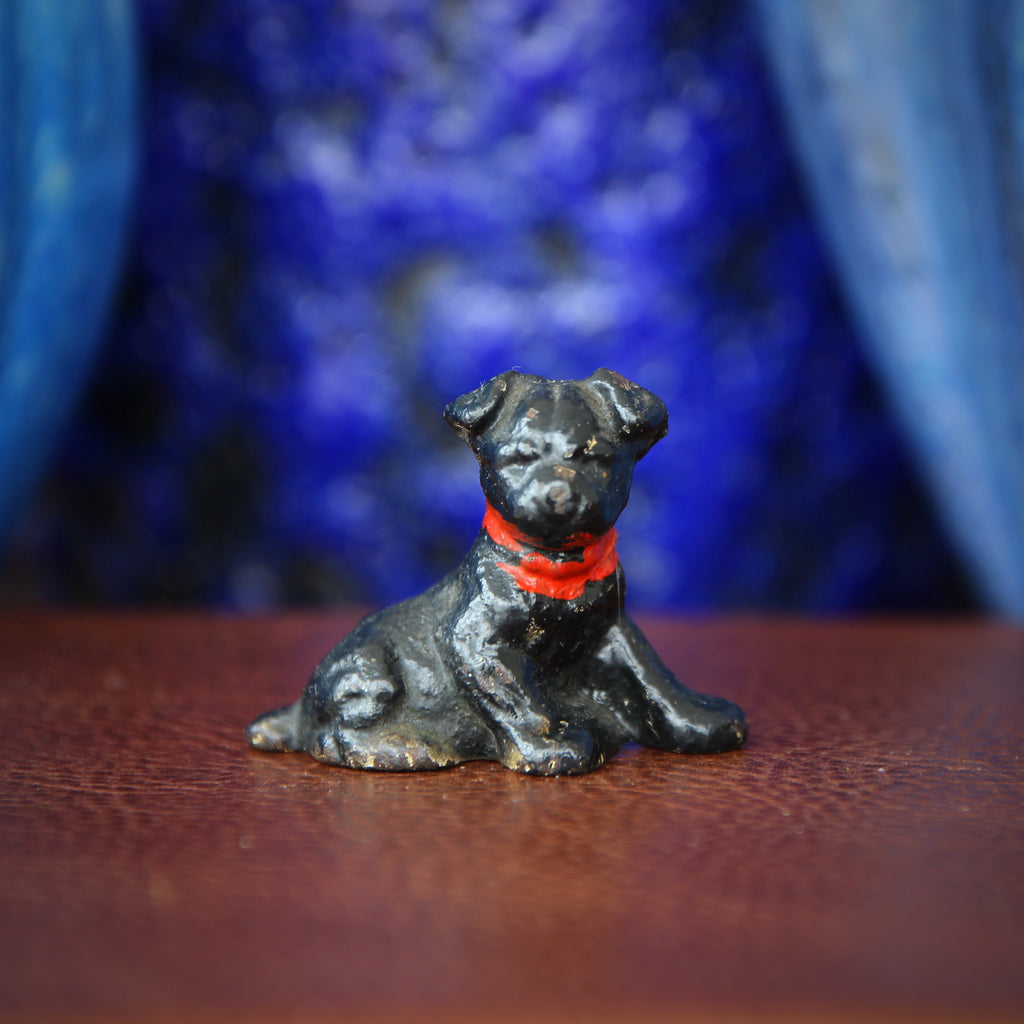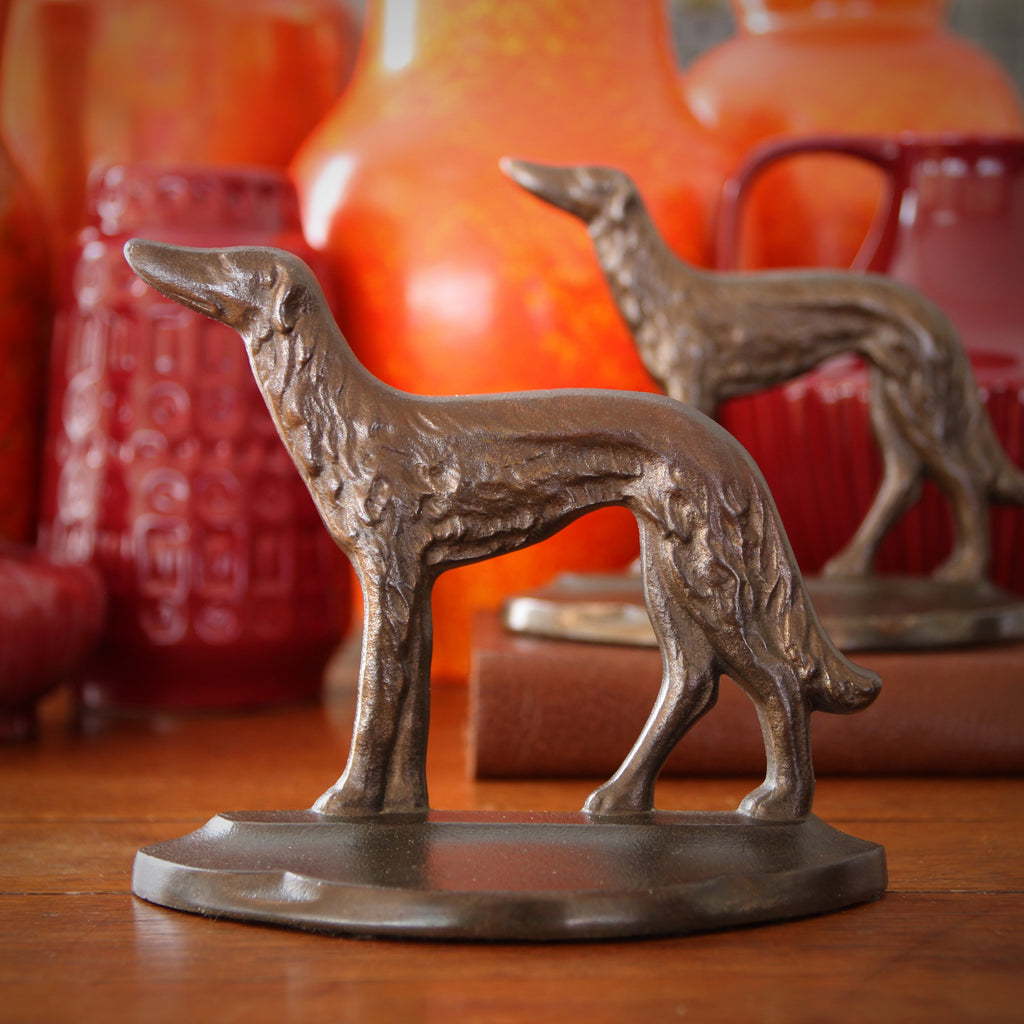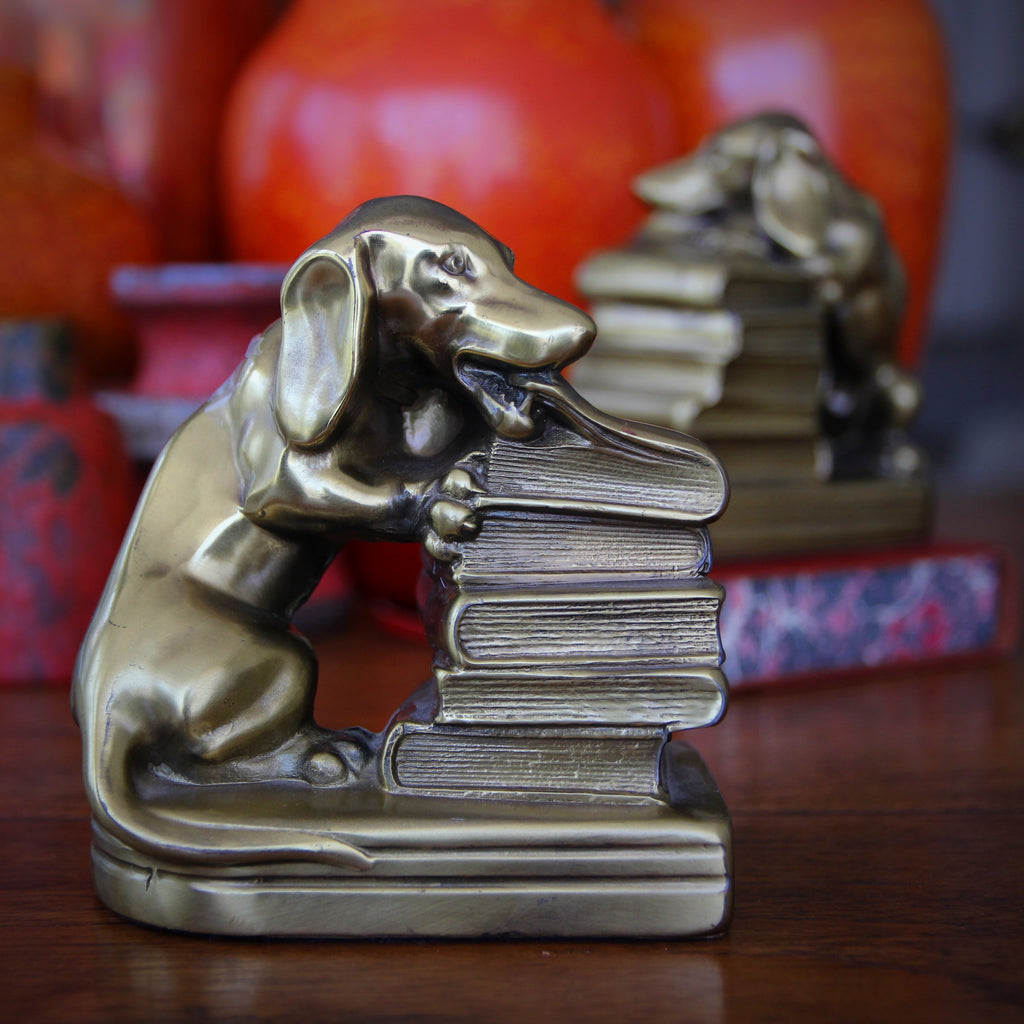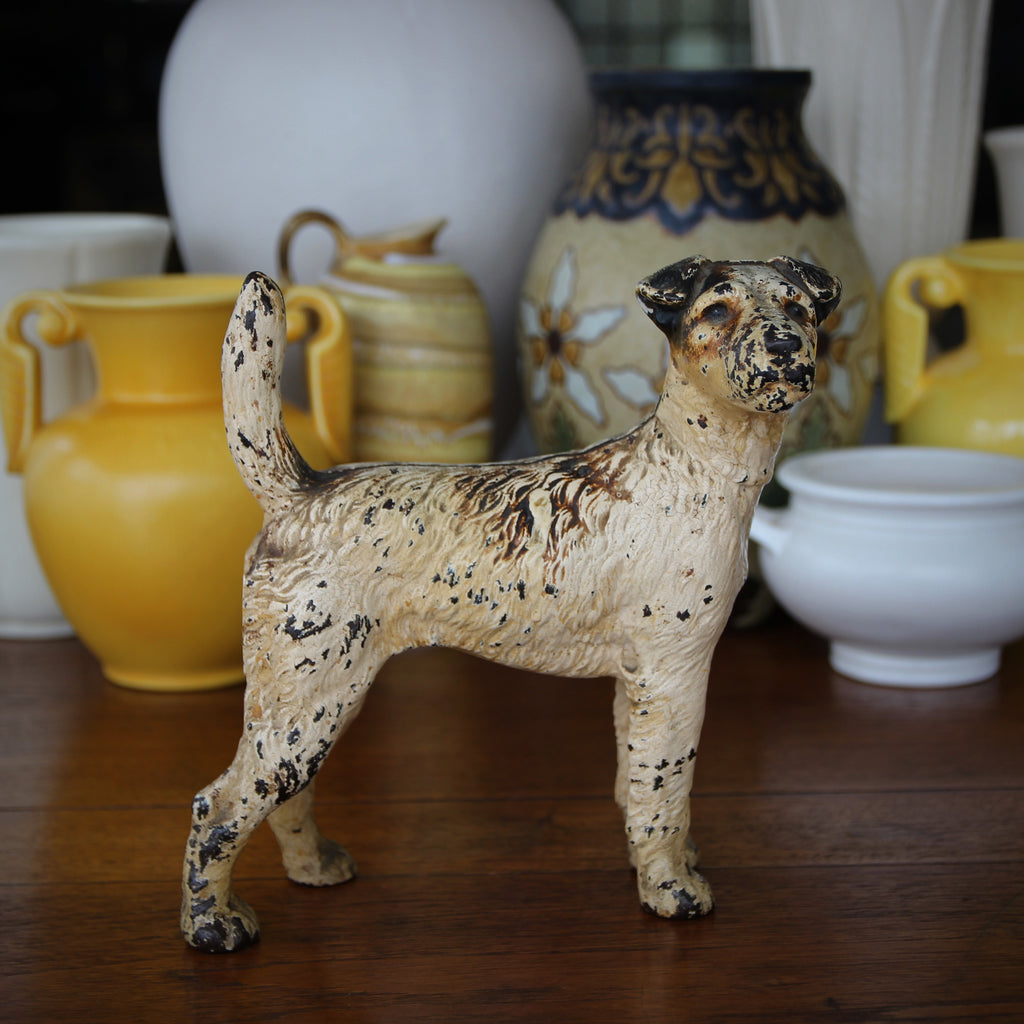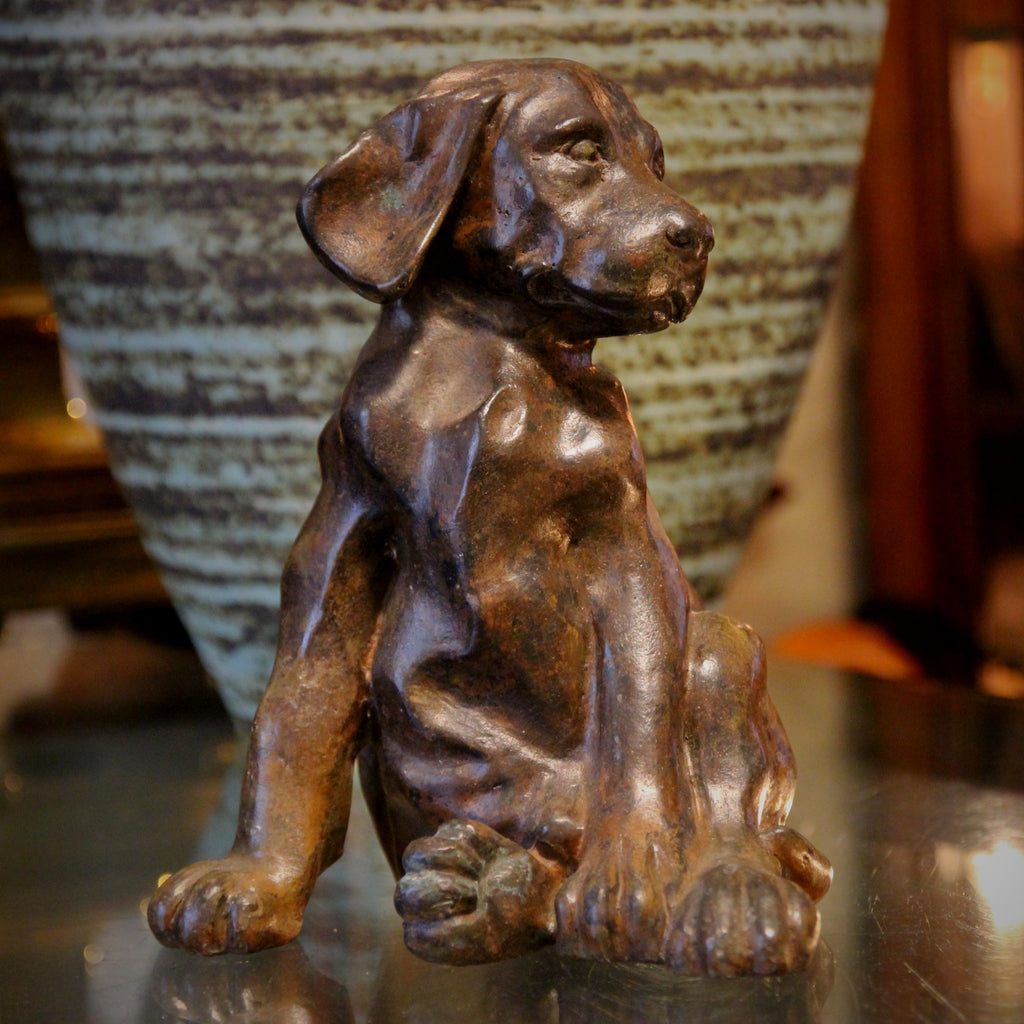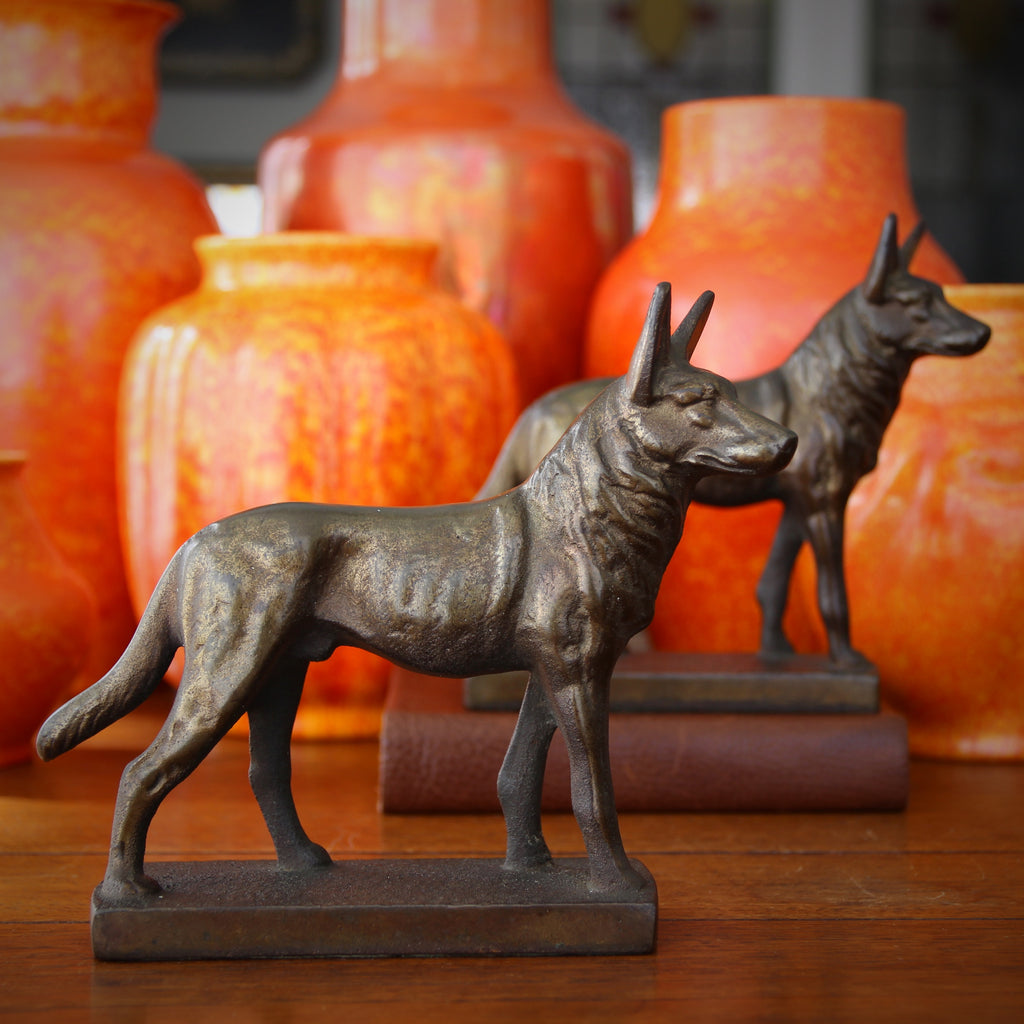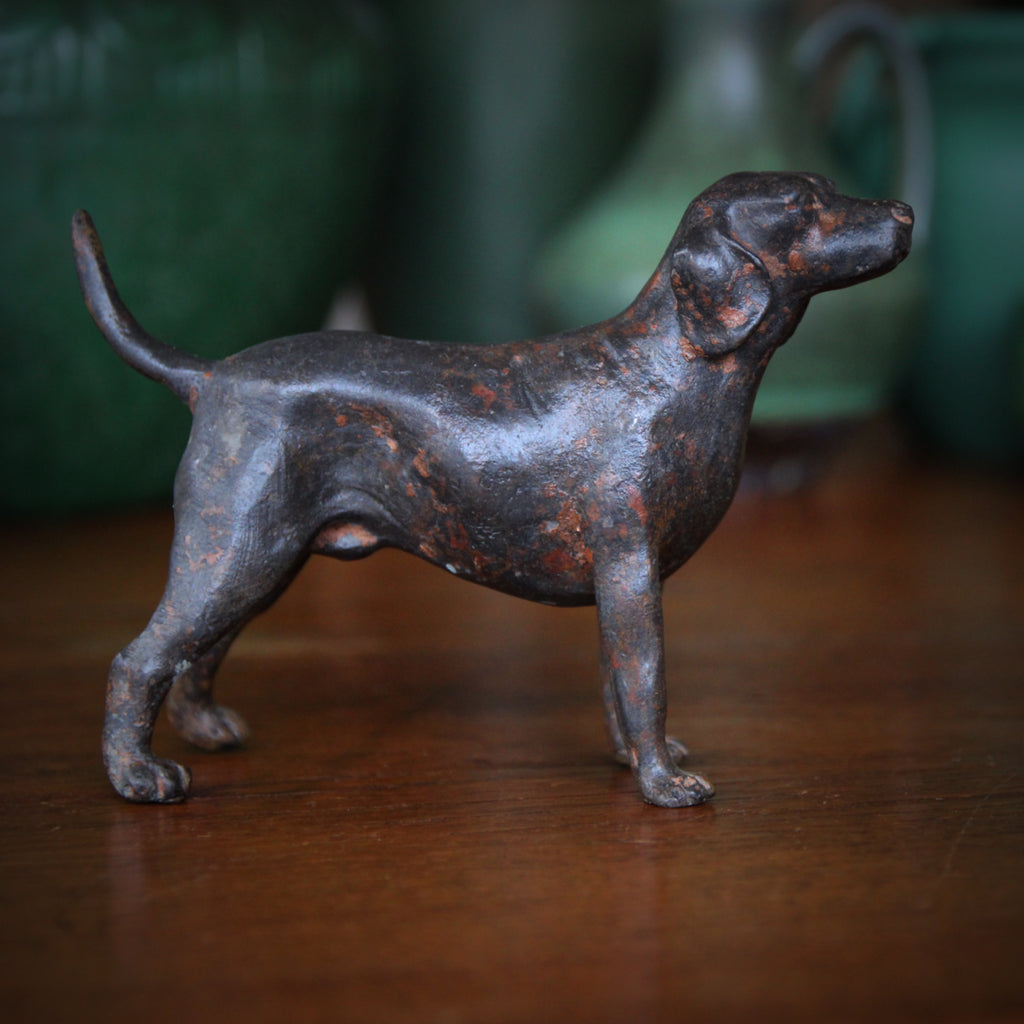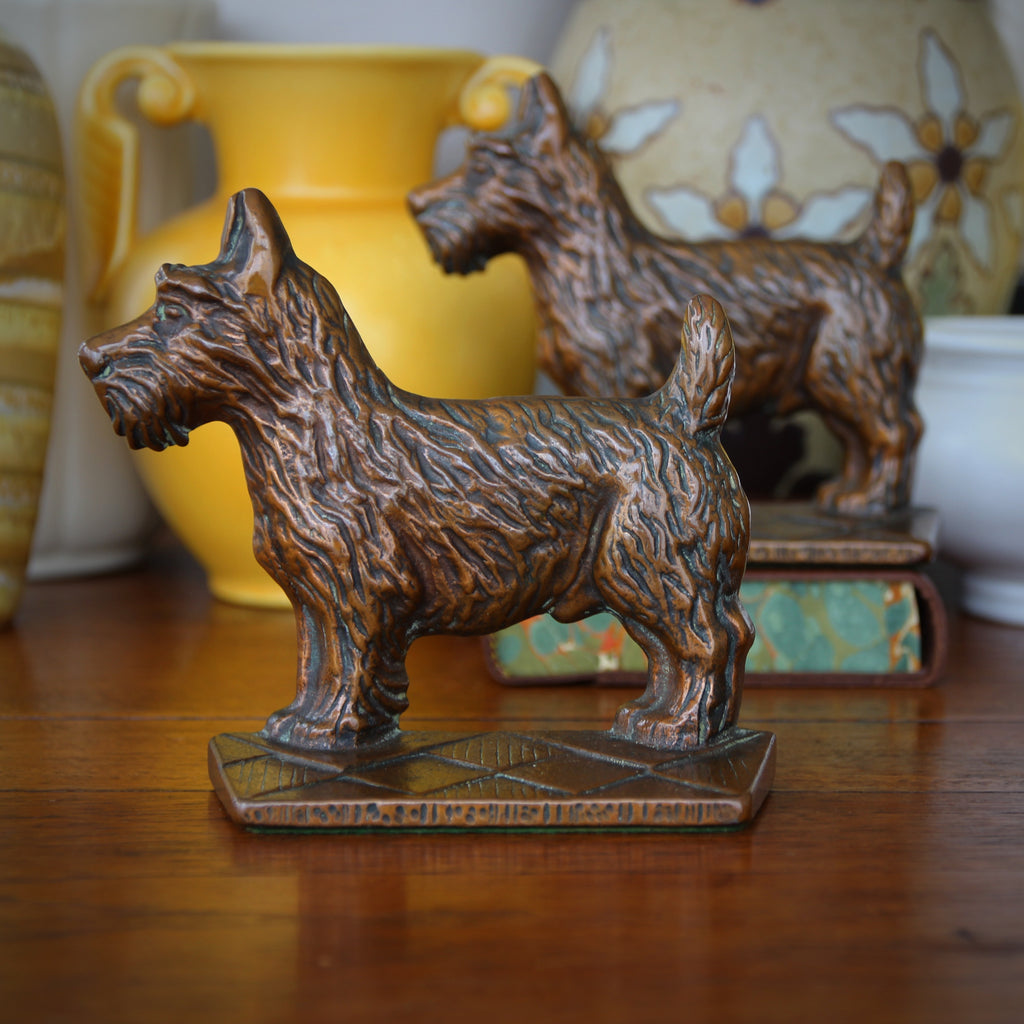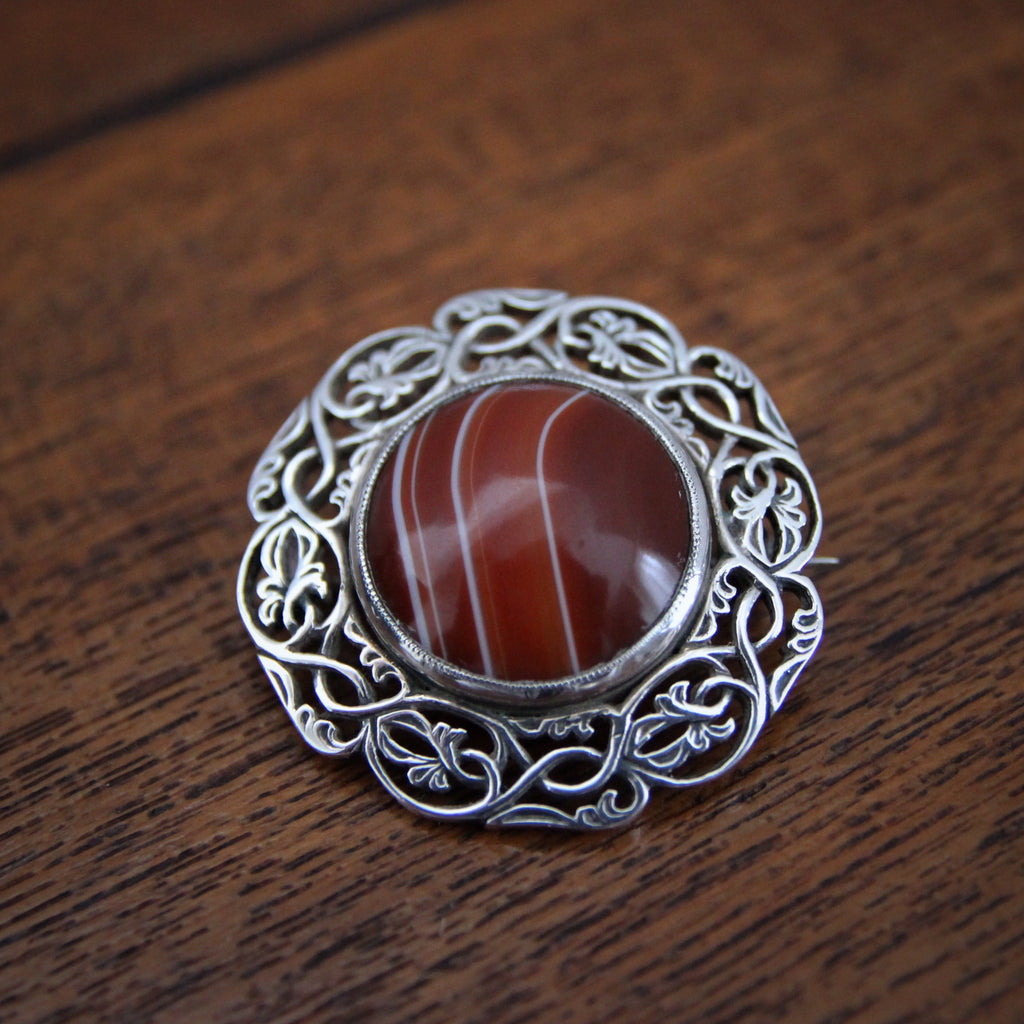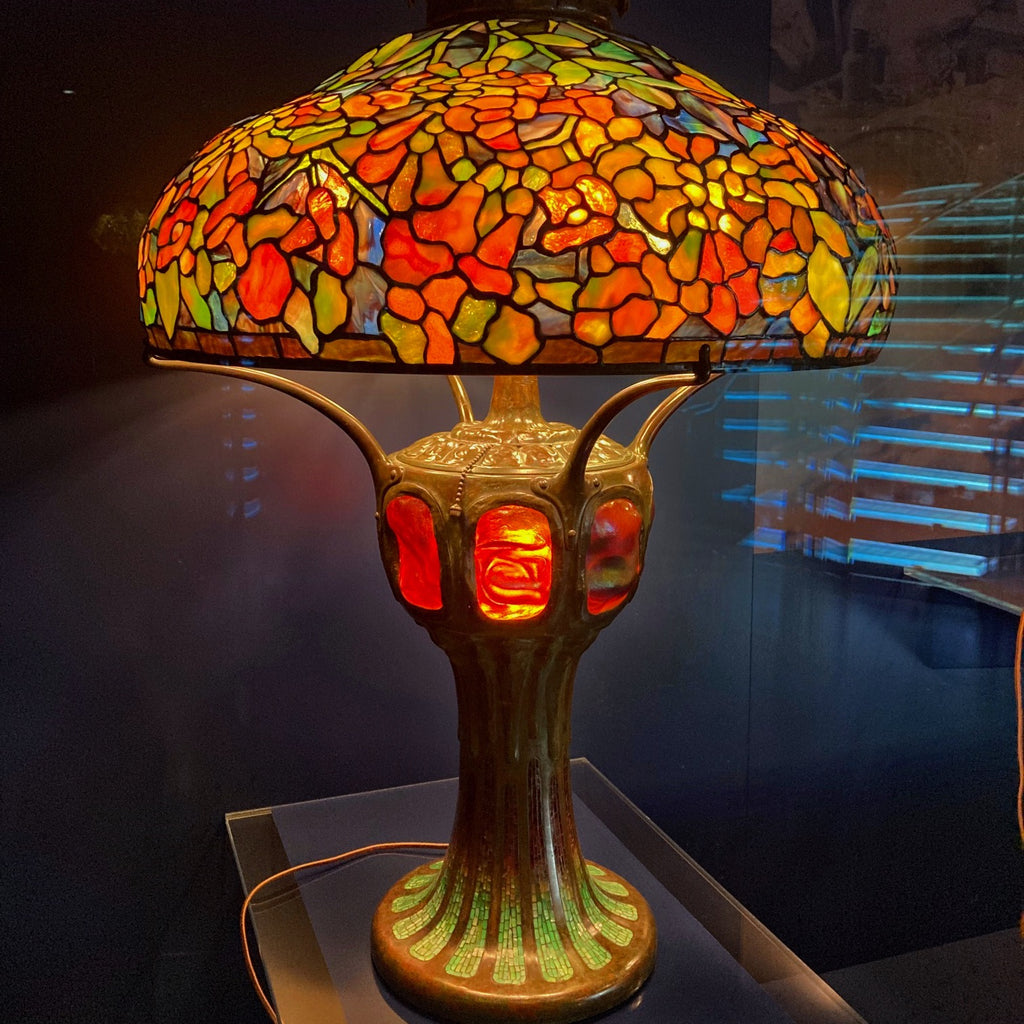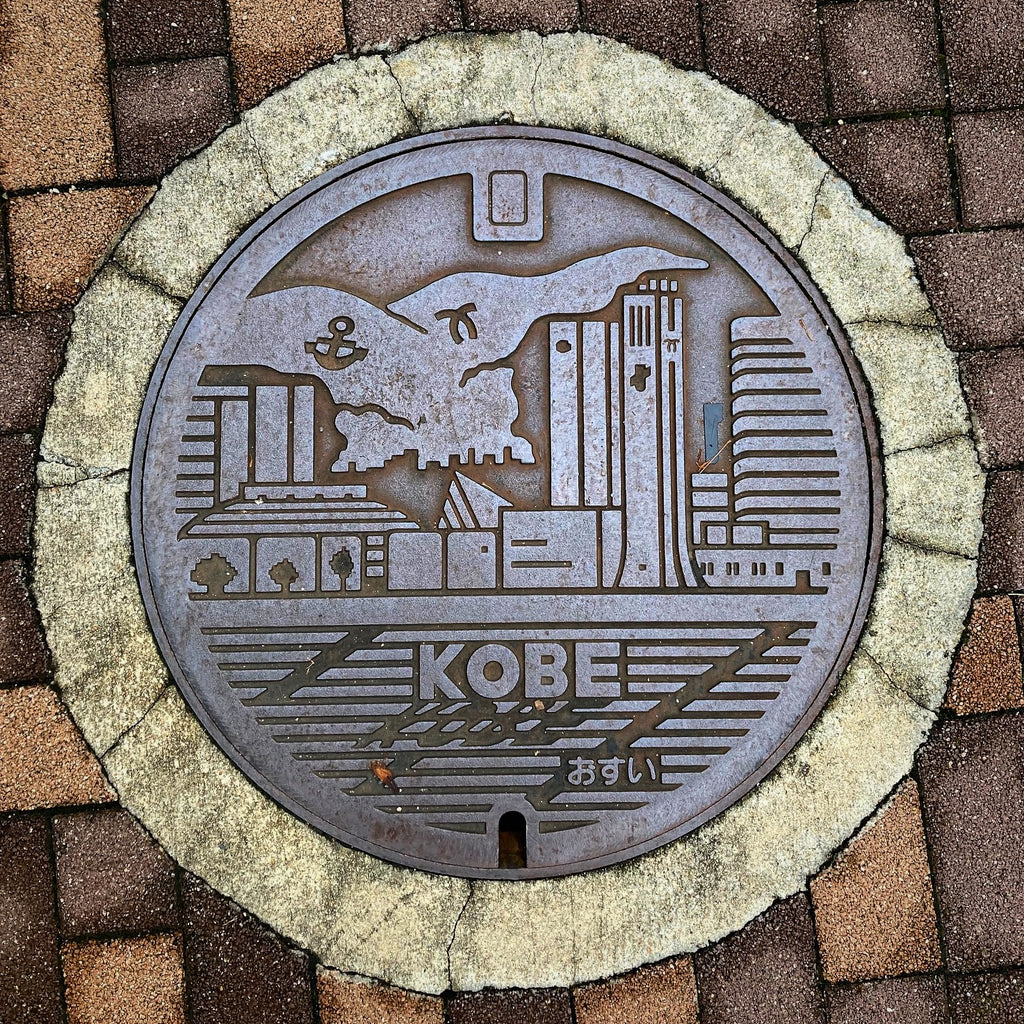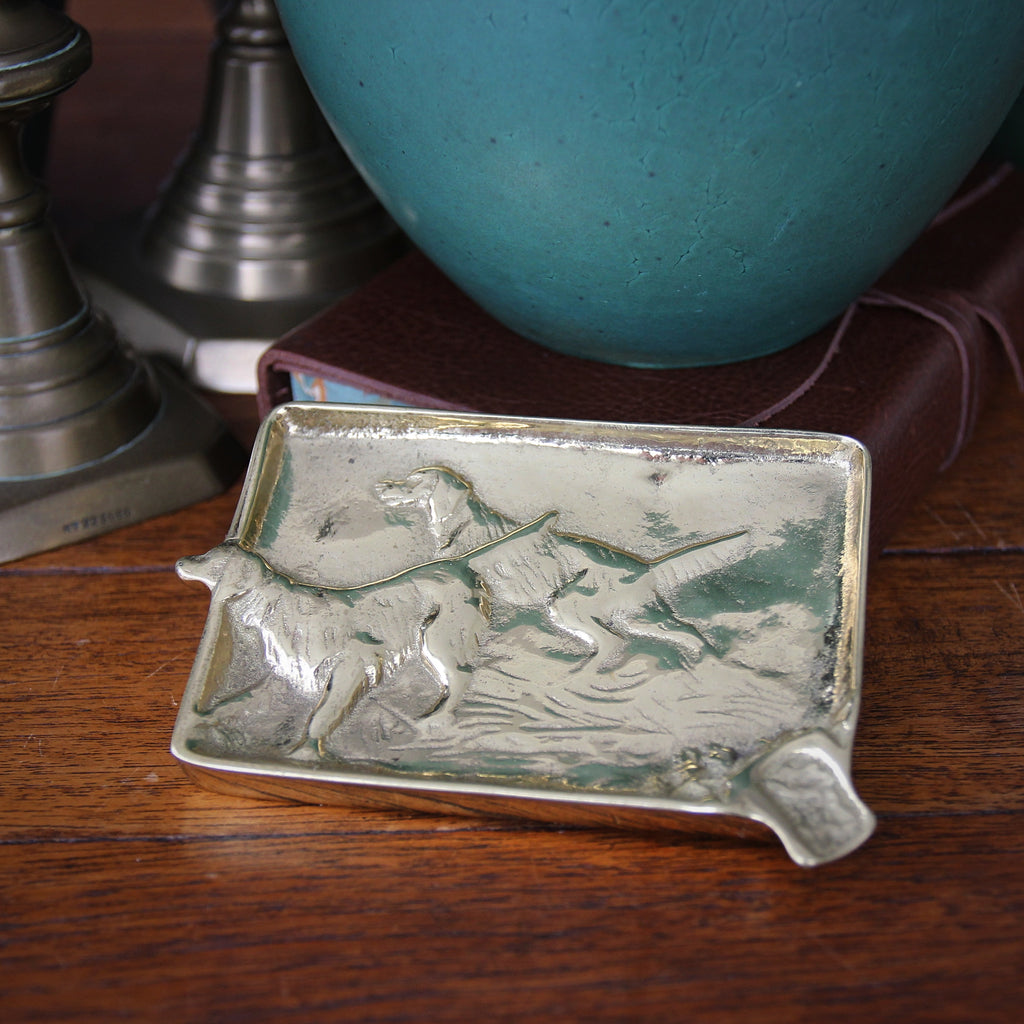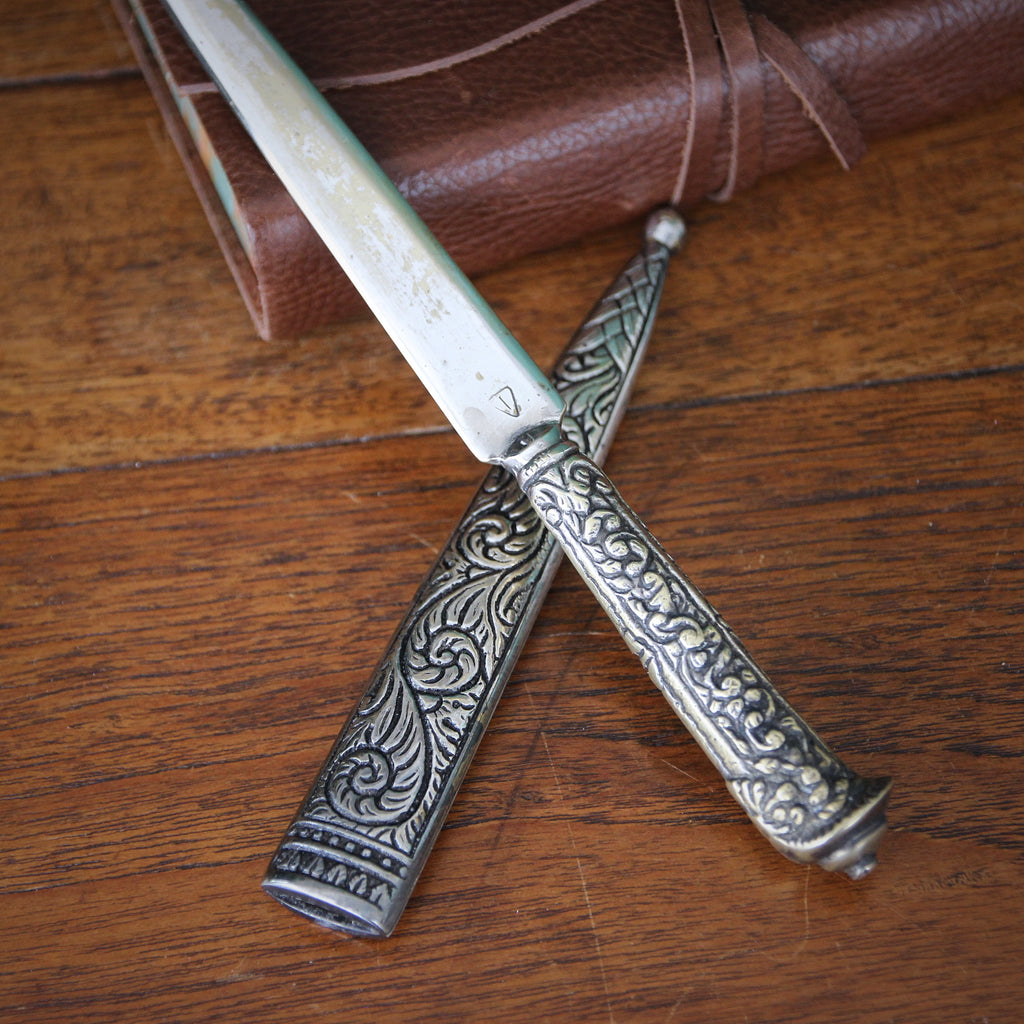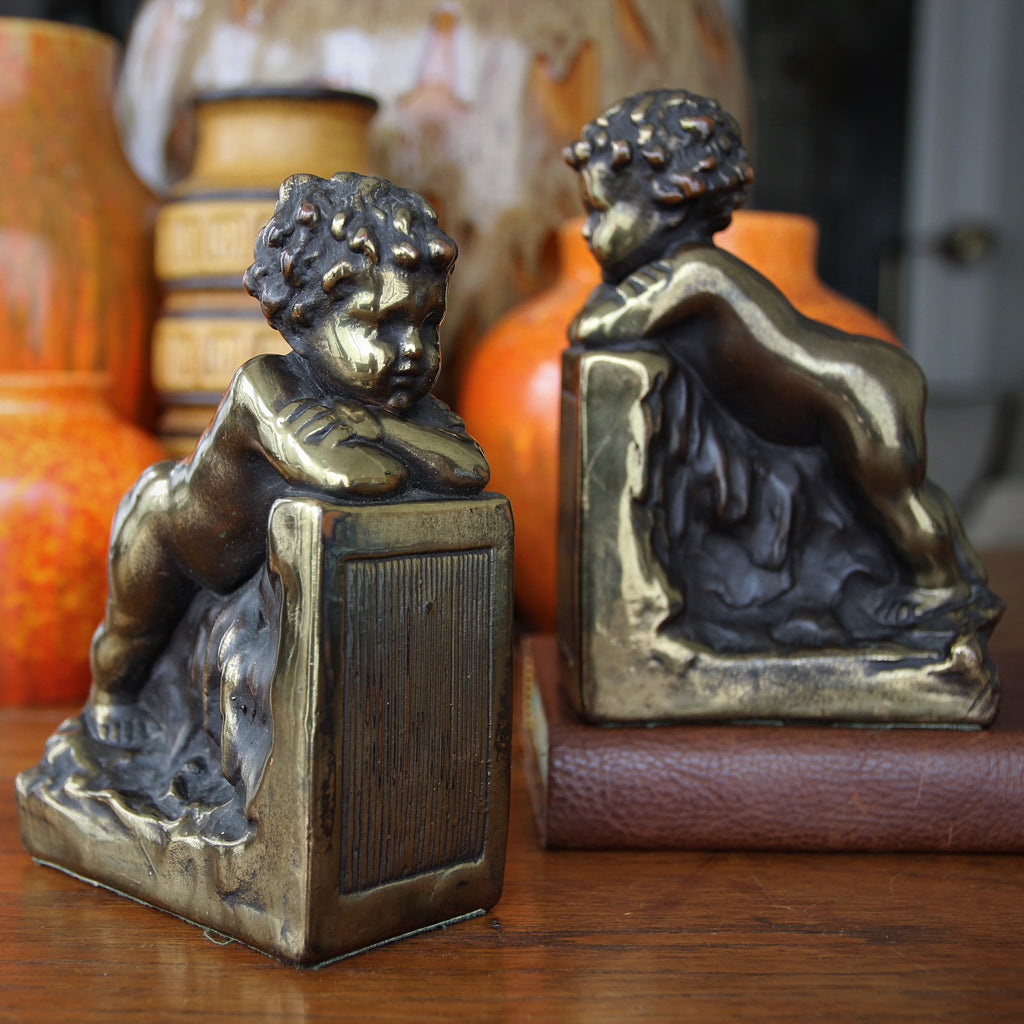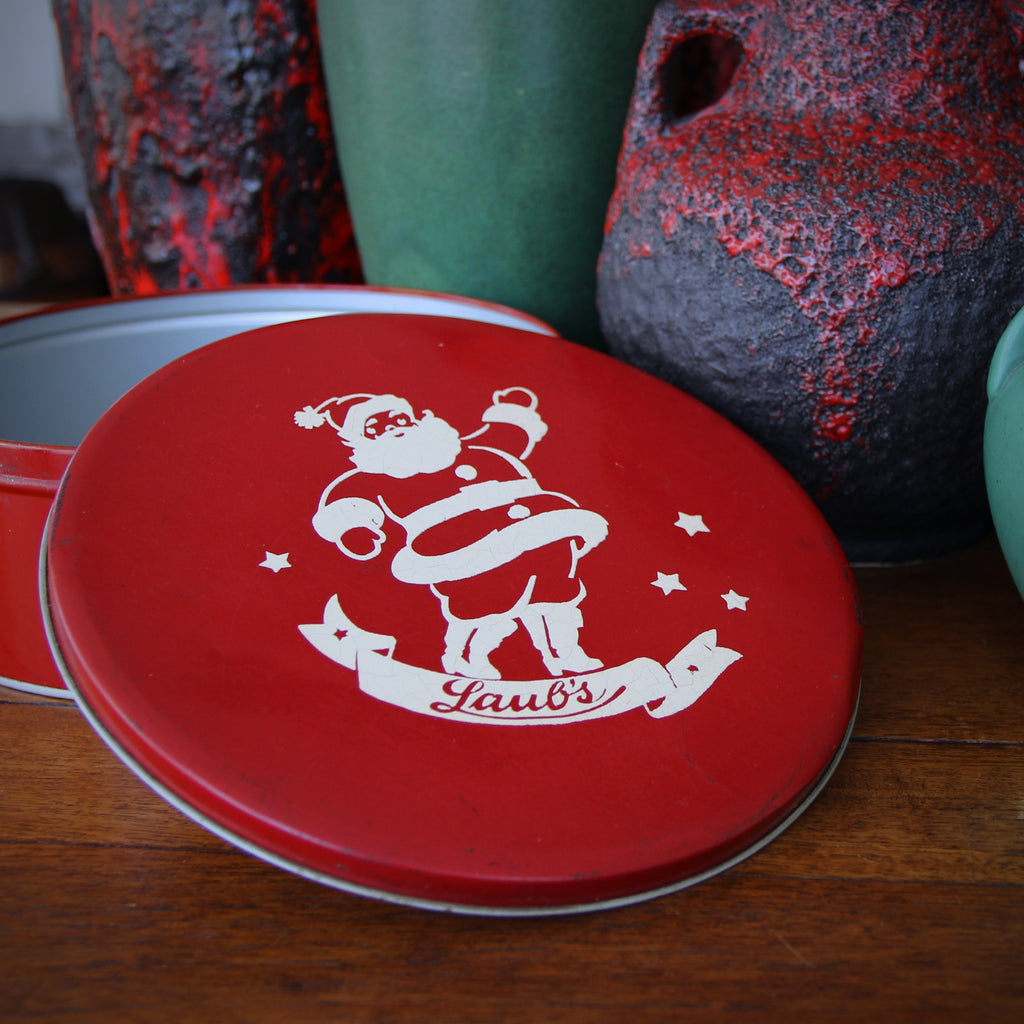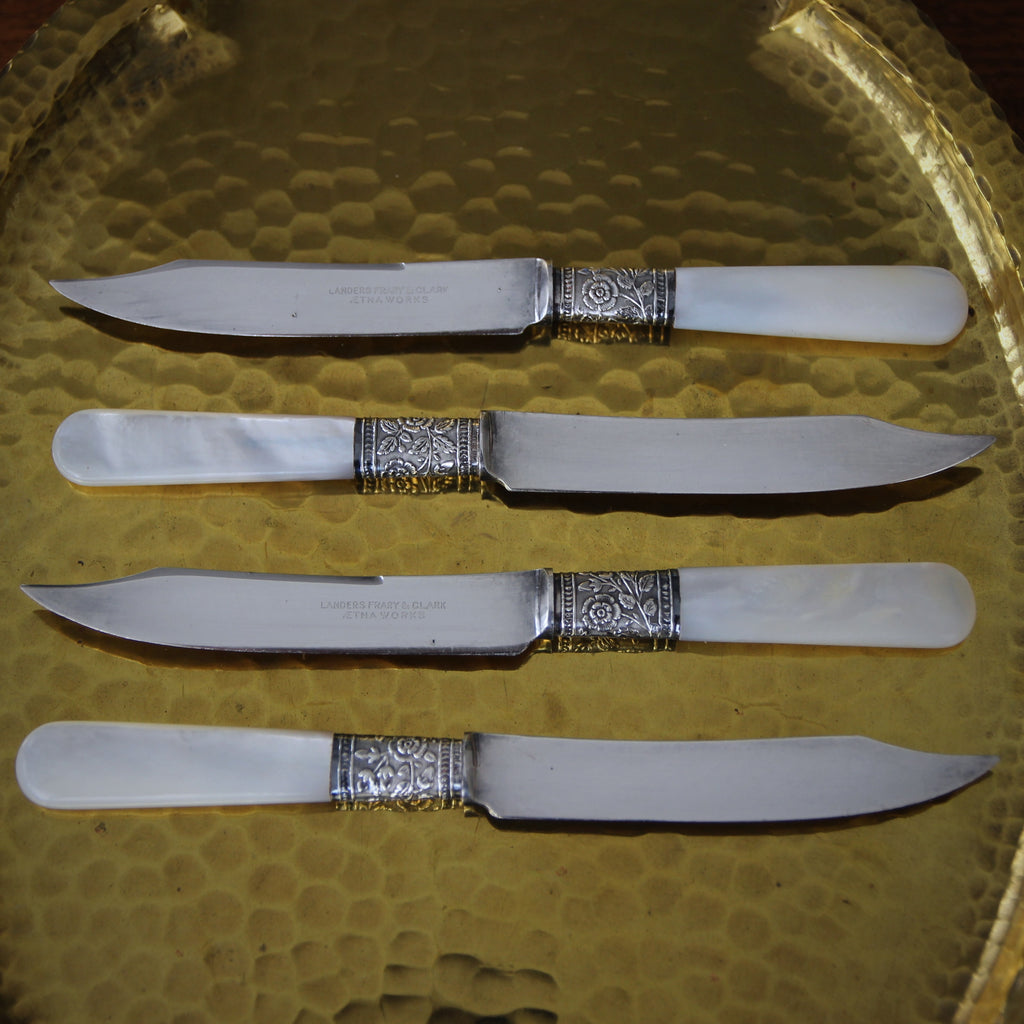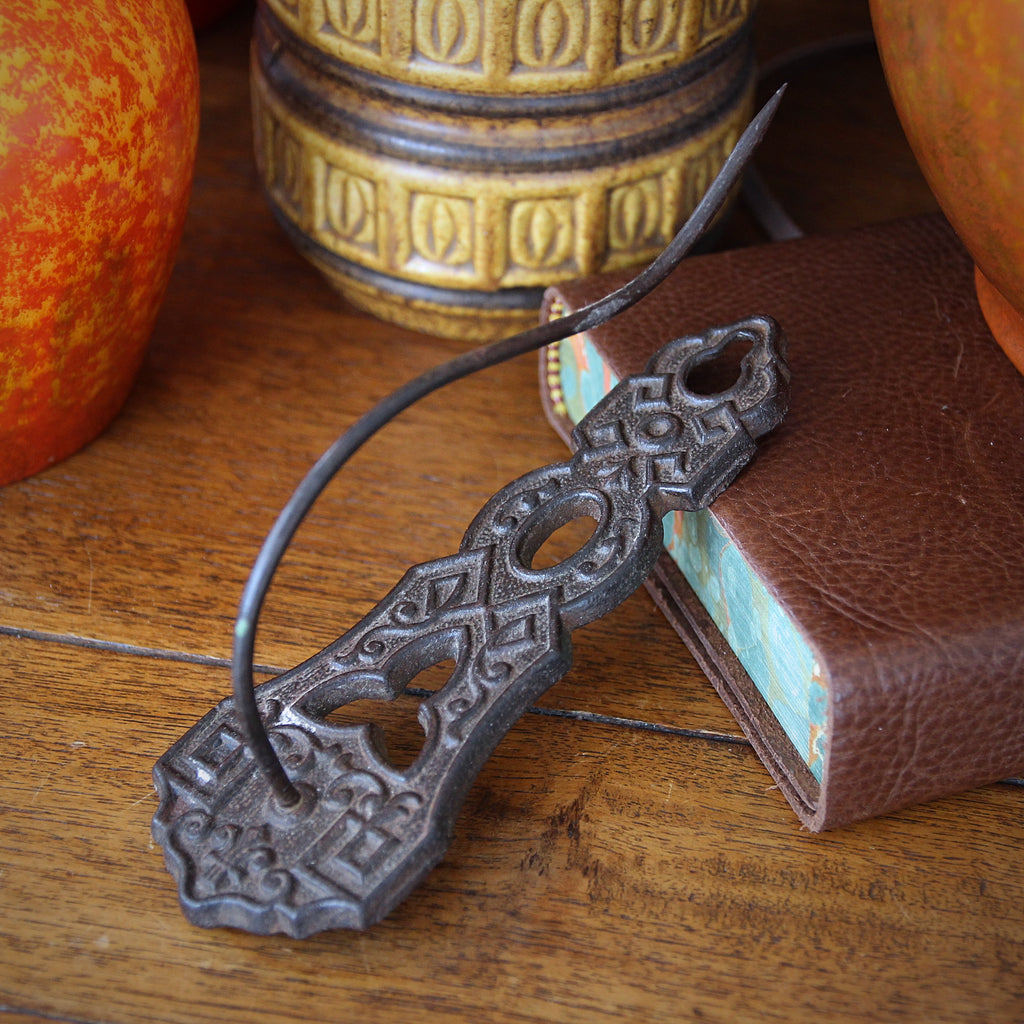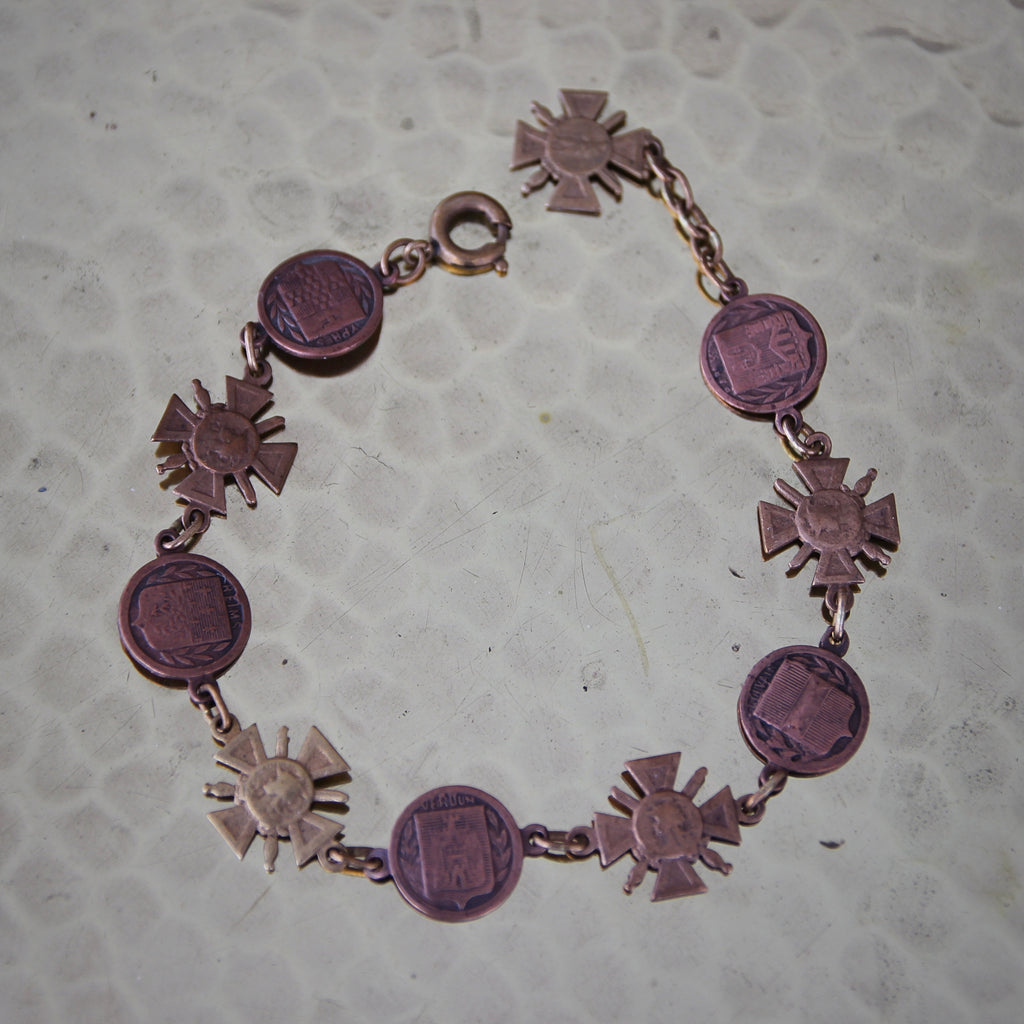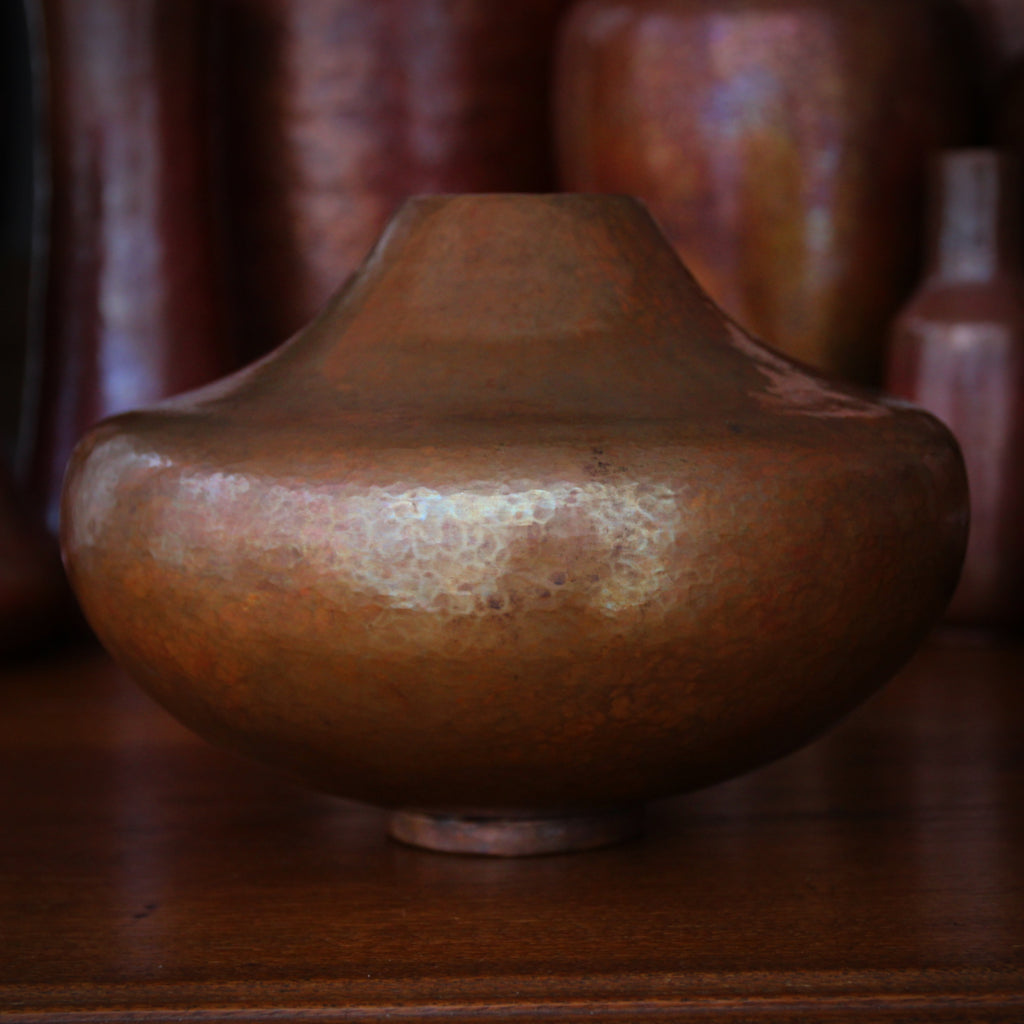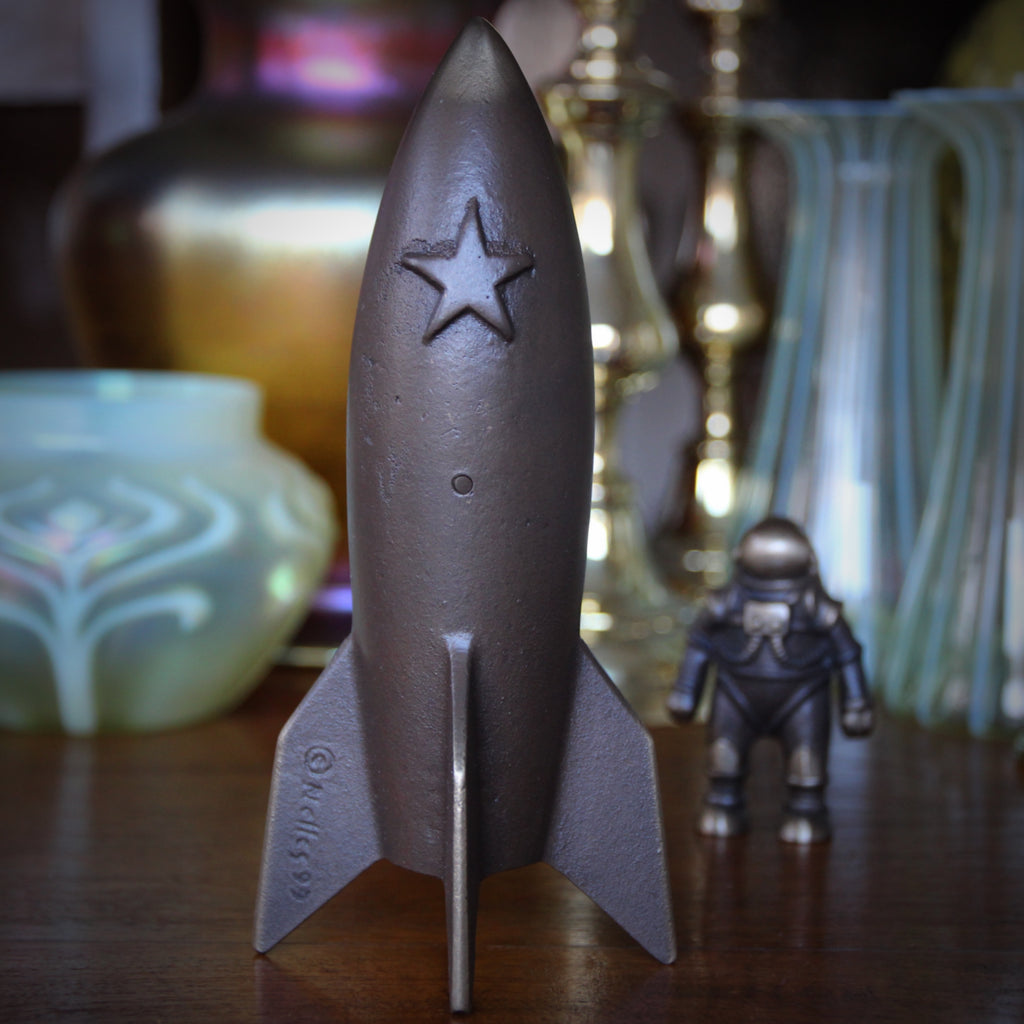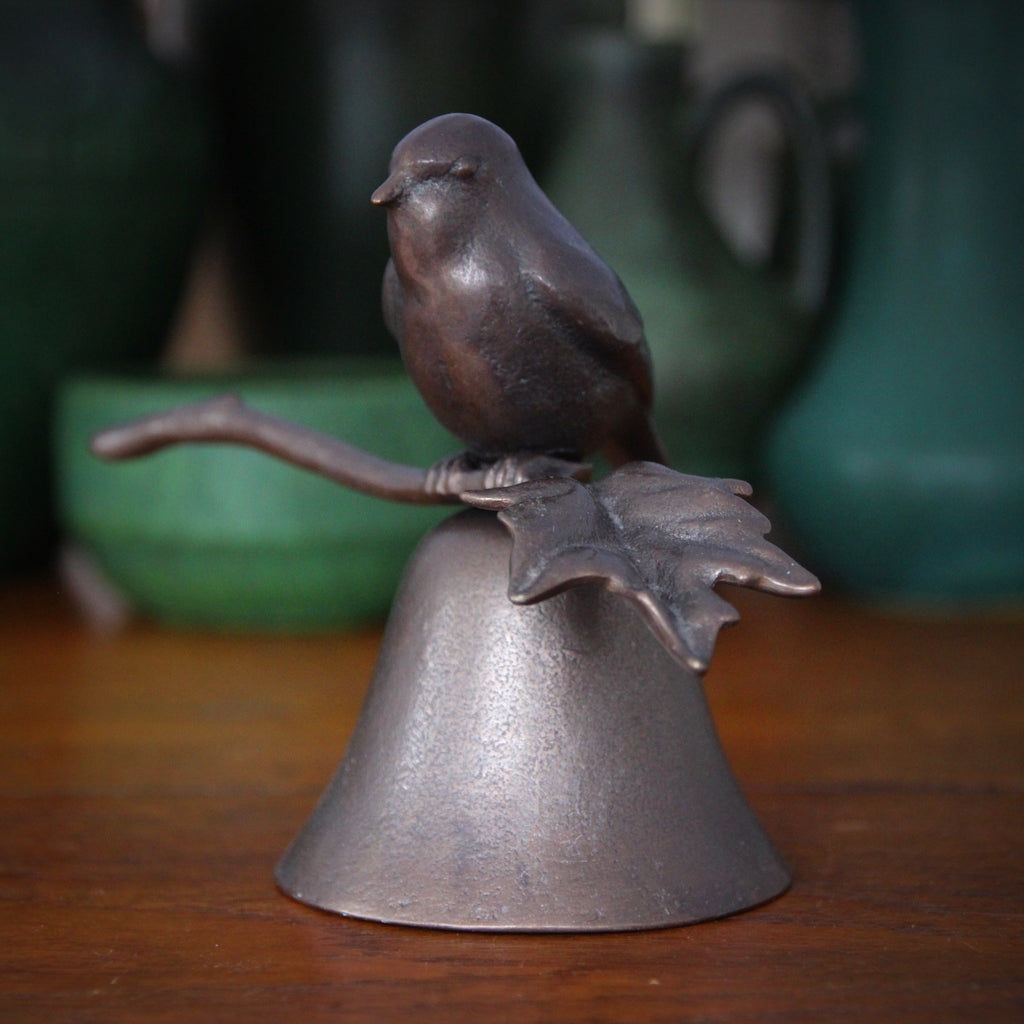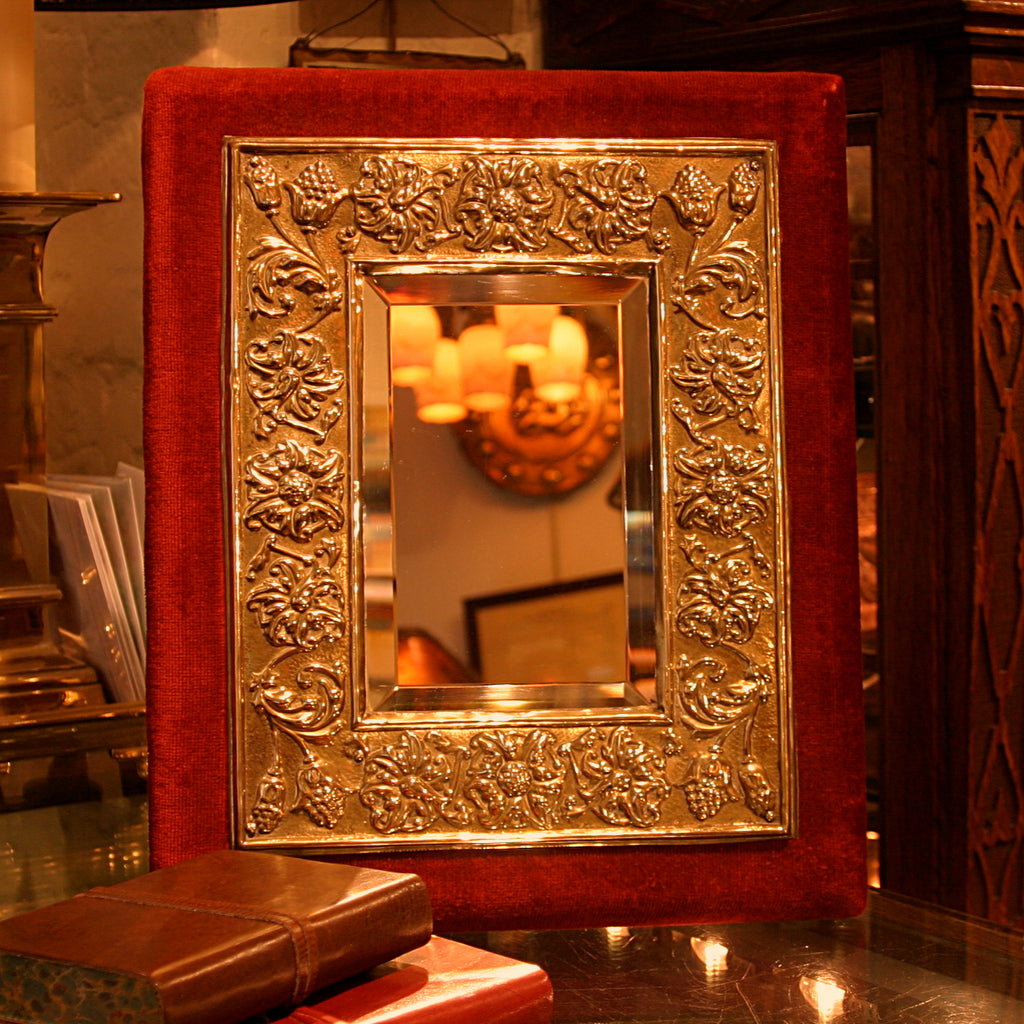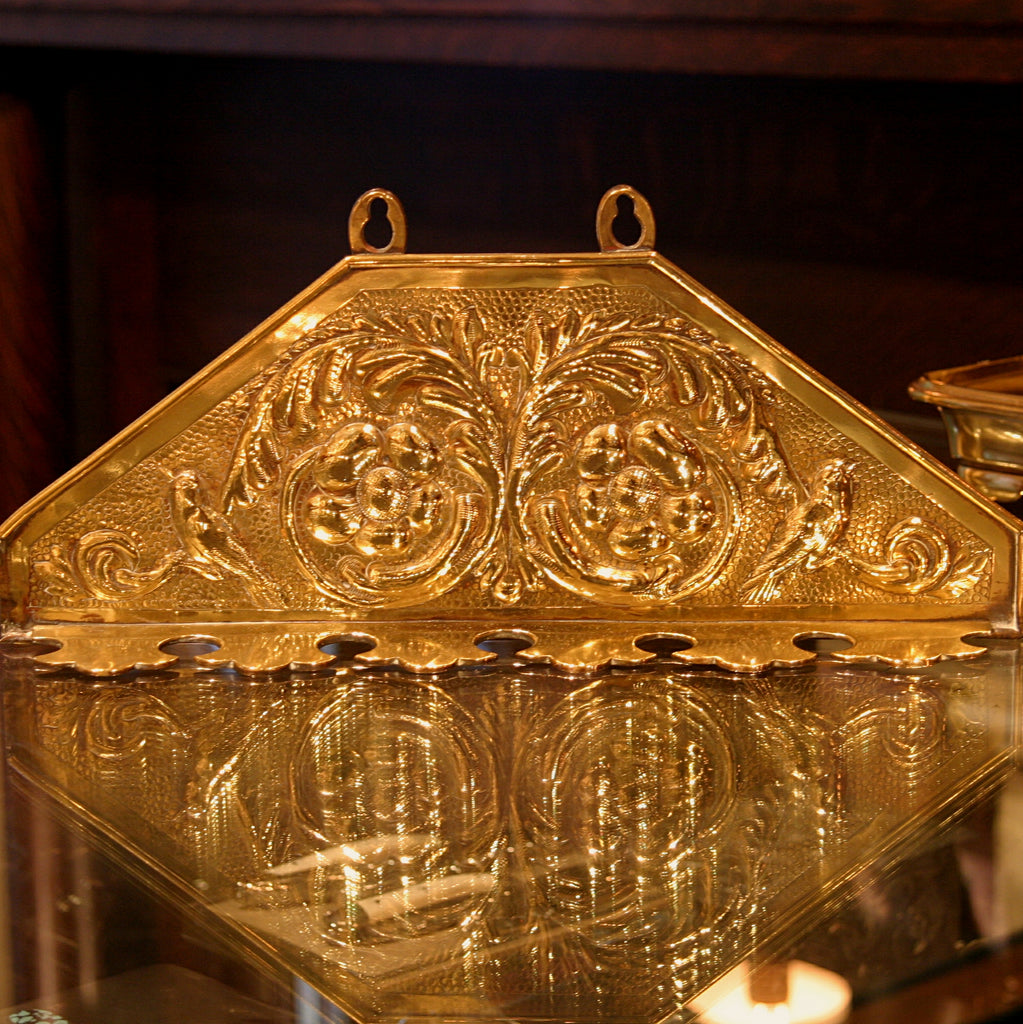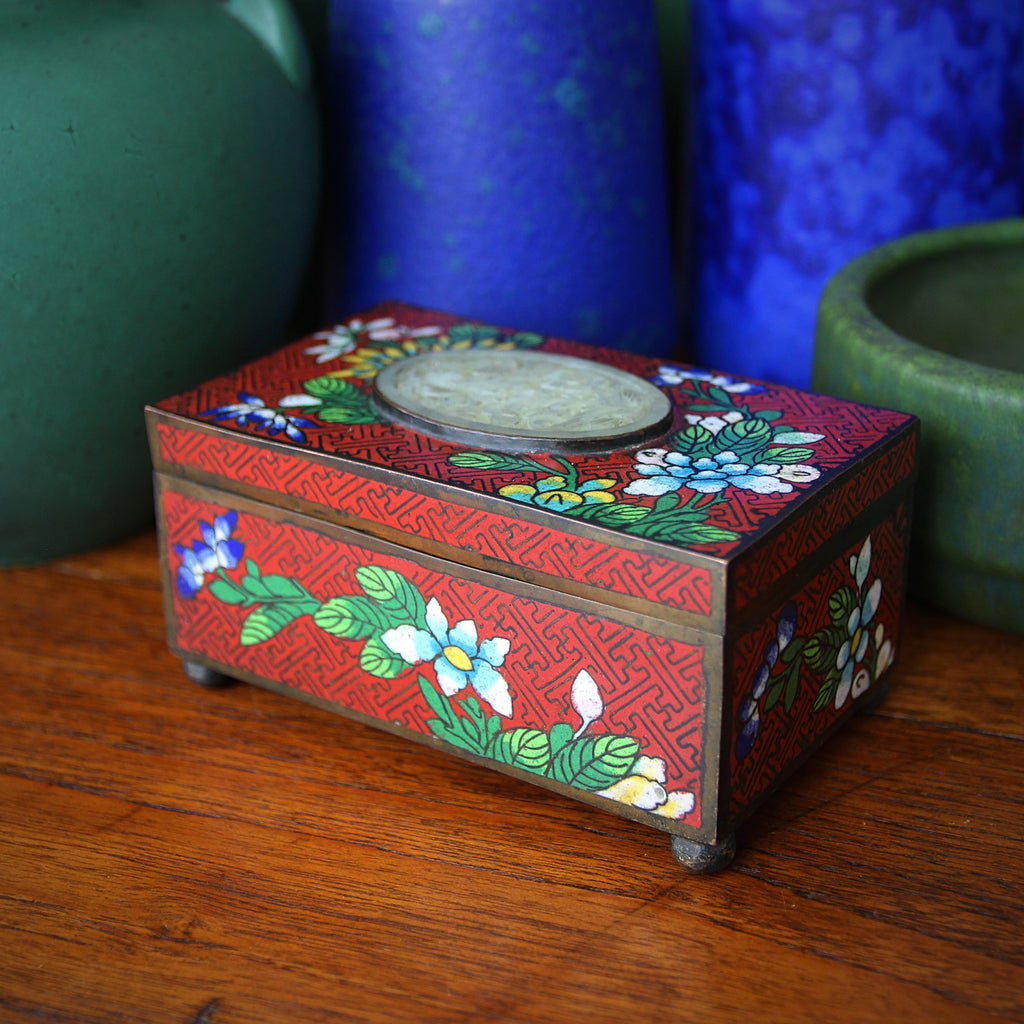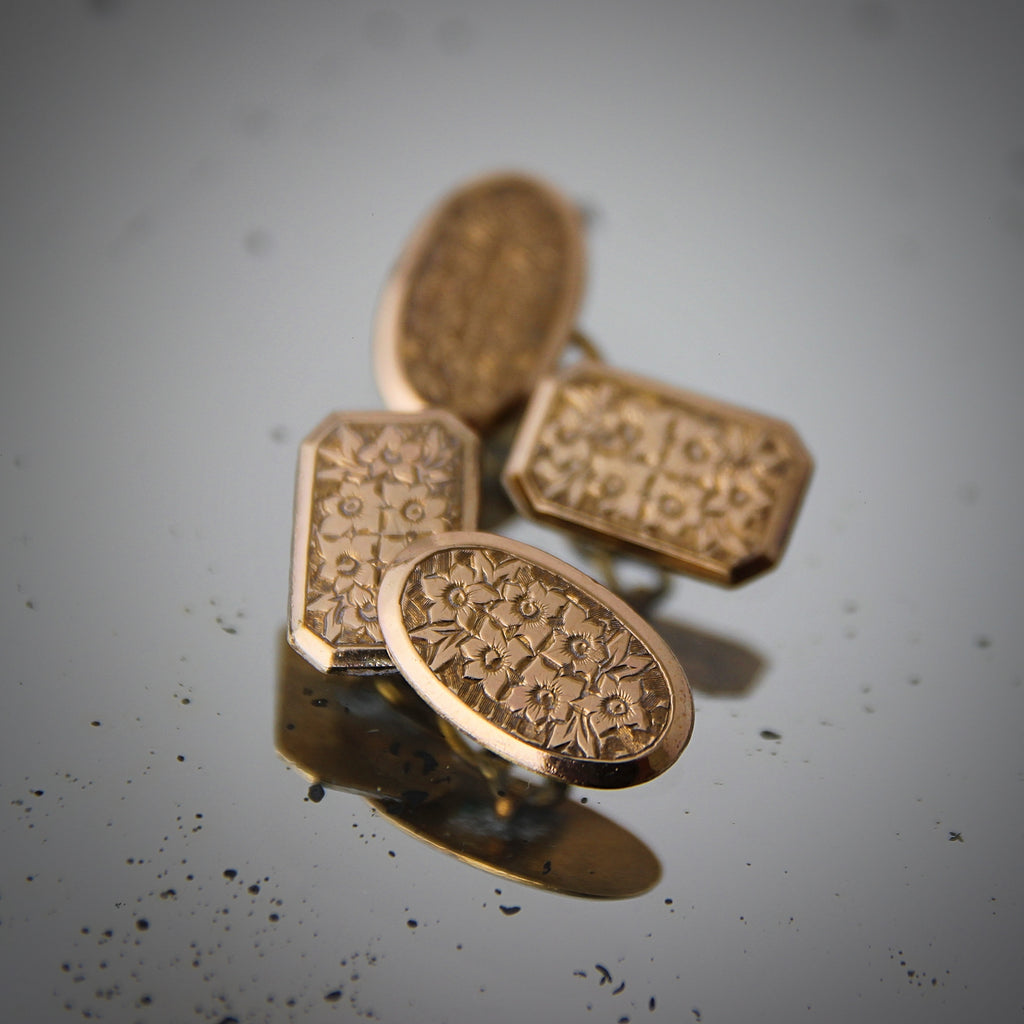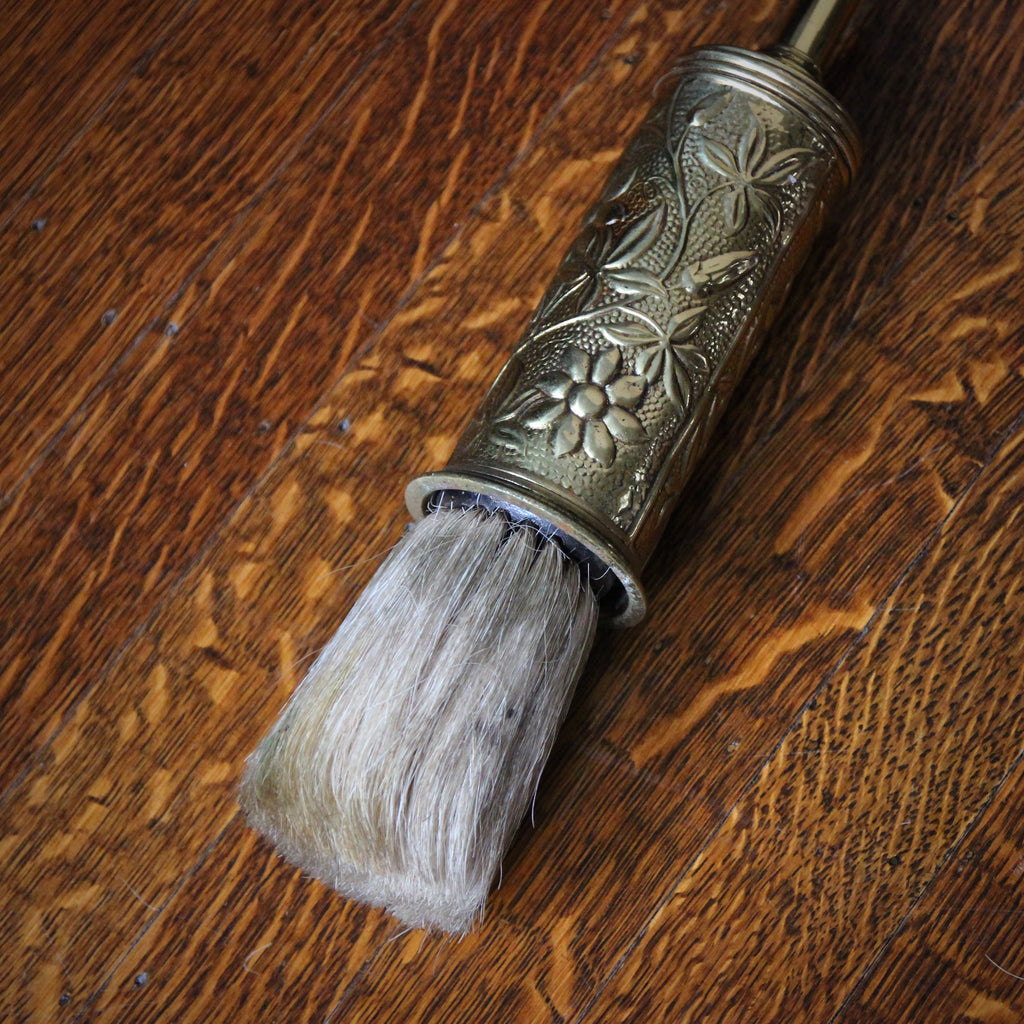JOURNAL — Metalwork RSS
A Happy Easter to all who observe it! And a joyous Springtime—of renewal and growth—to everyone!
Aluminum Chic
Skyscrapers! Angles! Silvery-shine! This pair of bookends screams "Art Deco!" They were made in the Thirties or Forties by Russel Studios (Chicago), cast of their "Silverlite" alloy—a blend of aluminum and zinc. Aluminum has been used since the 5th Century BC. It was especially important for dying fabrics and paint-making. Although aluminum ore is plentiful, it still was enormously costly, due to the very complicated processes required to make it useable. It was difficult to separate the pure aluminum from its compounds. We are told that when Emperor Napoleon III of France (who reigned from 1852 to 1870) wanted to impress his dinner guests, he'd have the gold flatware removed and replaced with aluminum cutlery. The six pound "cap"...
Michelangelo Buonarroti
When it comes to the arts, I love it all: painting, music, cinema, literature. Fine arts, performing arts, decorative arts. But, of all these disciplines, I think that sculpting will always be my favorite—especially the sculpting of stone. What art-creation could be more difficult, more physically taxing to produce? How does an artist "release" a perfect, delicate work from within the confines of its constricting material? To stand before a magnificent marble sculpture—a cold, dead piece of stone transfigured into a living, breathing human resemblance—is glorious to me. And The Master of All Sculpting is certainly Michelangelo Buonarroti. Michelangelo was a Florentine—born in just the right place at just the right time. Florence, circa 1500, was Ground Zero of...
The Twenties' Modern Woman
The Twentieth Century ushered-in a new conception of "The Modern Woman." Even before World War One—at which time many men were sent-off to war and women filled their work world vacancies—change was already in the air. Women were campaigning for the vote. They were entering the workforce. And they were mixing with men (socially and professionally) in more ways than they had in the Victorian era. The Nineteenth Century stereotype of the demure, frail, house-bound woman was being replaced with images of the active, strong and (even) athletic woman. Charles Dana Gibson's "Gibson Girl" was just such a modern woman.
For the Want of Handcraft
One of the things I dislike about Modernist architecture is its lack of beautiful handcraft—those hand-fashioned details which are the evidence that a human artisan had touched and built it. Masonry. Stone carving. Tile work. Back in the Art Deco Thirties, architects and builders still honored the artistic craftsmanship which gives a building its soul. The builders of Rockefeller Center—constructed during the dark years of the Great Depression—still managed to fund the artwork, the human handicraft, which makes the building special. Inside the building, frescoes by accomplished and famous artists decorate the public spaces: lobbies, hallways and stairwells. Outside, inlaid, painted bas relief panels honor the spirit of industry, commerce, trade work and progress. These exterior Art Deco panels are the aesthetic...
Dante Alighieri
Dante Alighieri—Italy's most important poet and one of the all-time greatest writers of the Western World—changed the course of Western literature. He affected the way we think of Heaven and the Underworld. Dante wrote in the vernacular (not in Latin, the language of the educated elite). Furthermore, Dante didn't write in "standard Italian"; he wrote in the dialect of his hometown, Florence. Alas, Dante found himself on the losing side of an ugly Florentine political struggle and he was banished, on pain of death, from his beloved home city. It was in Ravenna that Dante wrote his greatest work, the Divine Comedy. It was in Ravenna that Dante died and was buried (and where he remains to this day)....
Good Horsekeeping
I raised horses as a kid. I belonged to 4-H—"The Comancheros"—on the island of Kauai. Through the program, I learned important lessons about horsemanship, responsibility, sportsmanship, and competition. Each day, after school, I had to bid farewell to my friends and head-out to the pasture to ride and care for my horse. Seven days a week. Exercising, grooming, feeding and watering (our pasture land had no plumbing—I had to bring water in numerous 5 gallon canisters). Every couple of months, we had a horseshow which required three or four days of preparation and competition. On occasion, the routine was drudgery; much, much more often, it was incredibly fulfilling. There is an extraordinary relationship which forms between a person and his horse—something...
Sleepy Scholars
A pair of male nudes—young scholars—have fallen asleep, heads resting upon their still-open tomes. They are bronze-clad, in which a sculpted "composite plaster" figure is electroplated in bronze. This "bronze skin" can be finished—patinated, painted or both—as bronze would be. Such bronze-clad items had the appearance of bronze but were much less expensive to produce. Think of them as 1920's "poor men's bronzes," sold in gift shops or museum stores (where one might have just viewed the original work). This handsome pair of Art Nouveau bookends appear to straddle the transition where Art Deco design was just around the corner.
Mirrored Pairs
A "mirrored pair" of bookends is when the two mates—the two single bookends—are sculpted to face in opposite directions when placed on the shelf. The pair above is a good example: one bookend faces right, the mate faces left. This allows one to place them on the bookshelf, holding-up books, with each one facing-forward. Most pairs of bookends—perhaps 95% of them—are composed of two of the exact same sculpture. In such a case, when in use, one dog will be facing forward, the other will be facing backward (tail-out). Making a mirrored pair of bookends takes more effort and is more costly. Firstly, the foundry needs to create two original sculpted models (and make two different moulds) for each pair...
Hello, Spring!
Spring is here! Today at 11:05 pm is the Vernal Equinox, that day when the Earth's axis is perfectly-aligned with the Sun, such that day and night (on that day) are approximately equal. Equinox means "equal night." Going forward, the days increasingly will be longer than the nights—until the Summer Solstice (20 June), the longest day of the year, after which date the days will begin to shorten.
Speaking of Spring, these bright and cheerful cufflinks are certain to bring a touch of hopefulness to your shirt cuff. They are made of sterling silver and topped with white and lime green enameling
Just A Monk's Friends
Hooded monks stare-out from these polychromed, bronze-clad Gothic Revival bookends made by J. B. Hirsch in the 1910's or 1920's. The company was founded in 1907, on the Lower East Side of Manhattan, by Joseph Hirsch, a Rumanian immigrant. He hired designers to sculpt the original models for bookends, like the pair above. To make bronze-clad bookends, first a model was sculpted. From the original model, moulds would be made in which plaster "composite" duplicates were cast. These plaster sculptures were then electroplated: hung in a vat of water mixed with bronze powder and zapped with an electrical current, during which the bronze powder formed a solid bronze "skin" around the plaster form. Once the bronze skin was attached, the object...
The Wearin' of the Green
Happy Saint Paddy's Day!
As famous—and popular—as Saint Patrick is, his life is heavily shrouded in mystery. He is believed to have lived in the Fifth Century (possibly, some sources say, the Fourth Century) and was born in Roman-occupied Ravenglass (along the Western coast of Central England). According to his autobiographical Confessio, he was enslaved at the age of sixteen and taken to Ireland where he worked six years as an animal herder. After escaping, he undertook a difficult and dangerous journey, finally reuniting with his family in Britain. He later became a priest and returned to Ireland.
Keeping the Home Fires Burning
150 years ago, before the advent of domestic electricity (1880-1900) or widespread delivery of natural gas to homes (1890-1910), coal, wood and peat were the most common household fuels. Lighting was provided by candles and oil lamps. Candles were a domestic necessity—and a convenient storage box would be found in the kitchen, if not several rooms of a large home. Candles might be used to keep a convenient flame at-hand. They (or a thin "string-like" candle called a "spill") might also be used to transfer a live fire from one place to another.
Time to Leap
A calendar year, on Earth, is 365 days long. However, it takes a little more time than that for the Earth to complete its full revolution around the Sun—365.242374 days, to be precise. (A true "Earth Year" is 365 days, 5 hours, 49 minutes, 1.1 seconds.) This small difference would add-up to 24 days in a century. After 100 years, the calendar would be off by nearly a month. Within 500 years, our Summers would be freezing cold! So, in 46 BC, Julius Caesar instituted a leap day—an extra day added to the calendar every four years—on his new Julian Calendar. This "intercalary date" was still not quite right (the adjustment was too much). So Pope Gregory XIII instituted his Gregorian Calendar (in...
Trench Art
The term "trench art" is used to refer to the folk crafts fashioned of (or partially fashioned of) the used or spare materials of warfare. This art form was especially popular during and after World War One. Trench art was made by all the major WWI participants: England, France, Belgium, Germany, Canada, Australia and the United States. But very little trench art actually was made "in the trenches"—or even on the front lines, for that matter. Much of it would have been made away from the battlefield, for example, at training camps or other military posts. Some might have been made in hospitals by recuperating soldiers. And some may have been made back at home—by soldiers awaiting call-up. Even after...
Three Weeks 'til Spring
Can it really be? Spring is three short weeks away! Spring normally arrives on the 20th or 21st of March. However, this year, because it's a Leap Year, Spring springs one day earlier than normal: 19 March. The first day of Spring is also the Vernal (or Spring) Equinox. Equinox means "equal night." The Equinox is the date when the Earth's axis is aligned such that the Sun hovers right over the Equator. On the Equinox, night and day are (nearly) the same length. And, going forward, the days will be longer than the nights. The cufflinks shown here, made in England in the Twenties, are decorated with sunny enameled stripes: lemon and lime. Though they may be worn any...
Wooden It Be Useful? - III
This week we're sharing a selection of useful wooden items. The wood of this English barrel-form coin bank glows richly. Riveted brass bands punctuate the bulging form. Warm, honest materials meet straightforward function: a handsome place to stash your savings.
Wooden It Be Useful ?- II
Yes, this English Arts & Crafts Letter Rack is made of wood—though it is embellished with plenty of hand-hammered brasswork. A winged dragon stalks in a field of botanicals, while an undulate amethyst glass cabochon floats overhead. The hand-tooled panels are riveted to the oak understructure. This piece is made to hang (on its mounting ring) or it can rest of a flat surface.
London Calling - I
If I had to pick one London neighborhood to call my own, it would be Bloomsbury—long a center of London's intellectual, scholarly, medical and literary enterprises. I have been staying in this active, human-scaled neighborhood for decades—surrounded by students and faculty from the neighborhood's several colleges, and employees of the numerous bookshops and many creative businesses in the area. The neighborhood was first called "Bloomsbury"—or, rather, "Blemondisberi"—in 1281, named after the French Blemond family who owned the manor here. In time, King Edward III (who reigned from 1327-1377) acquired the property, still largely rural, and gave it to the Carthusian Monks. Later, when Henry VIII was "disbanding the monasteries," this property was seized and given to one of the King's...
Oxford Around the Corner - II
Here's a different take on the Oxford Corner—crisp, bold, structural. Chamfering of the members adds sophisticated elegance to the otherwise simple frame. The extended legs of the Oxford Corners make for simple, integrated "feet."
This Victorian English brass frame was made in the late Nineteenth Century. It would provide a nice "pop" for any picture—especially a dapper black and white portrait.
Fierce!
This fierce feline is ready! Ready to guard your precious tomes. This pair of fierce lion bookends was made of cast iron in the Twenties or Thirties and still wears most of his original golden paint. Beautiful, deep bas relief sculpting is well-aged by time—creating the perfect "high/low effect" on the patina, making the sculpture pop. Lions have been portrayed in the decorative arts for thousands of years. And they have been a significant part of European heraldry since the Middle Ages. In fact, every "attitude" (position or posture) of a heraldic lion has a specific name. A lion rampant stands upon its back legs. A lion passant is shown walking. A lion couchant is lying upright, on its belly (like...
Complex Reaction
Is it possible for one to have complicated feelings towards a pair of bookends? Well, it seems, in this case, I do.
The cast iron bookends shown here, are from the Twenties or Thirties. The workmanship is terrific: handsome bas relief sculpting, ultra-crisp casting, and a beautiful bronzed patina. The details of the unfolding scene—the distant mountains, the dust rising on the prairie, the scrub brush in the foreground—are conveyed with wonderful precision. The bookends are an homage to romanticized Western life—handsomely executed and perfect for any American Arts & Crafts interior.
Welcome, February!
February is here. And she brings with her the amethyst, birthstone of the month.
Until the Nineteenth Century, amethysts were rare and very expensive. They were considered one of the five "Cardinal Gemstones"—alongside diamonds, rubies, emeralds and sapphires. Initially, deep purple amethysts—the color of royalty—had only been discovered in Russia and Austria. Medieval monarchs loved amethysts. To this day, Anglican and some Roman Catholic bishops wear an amethyst in their episcopal rings.
According to Ancient Greek mythology, Dionysus—the god of wine—was in-pursuit of a beautiful virgin, Amethystos. Her prayers to remain chaste were answered: before he could catch her, she turned into a beautiful white stone. In his grief, Dionysus poured wine over the stone, turning it violet—the first amethyst.
Sailing Towards Christmas
True, Christmas is eleven months away. But it is coming!
This cast iron "Spanish Galleon" doorstop was made by Hubley (Lancaster, PA) in the Twenties or Thirties. It still has much of its original hand-painted color—though that paint is now well-aged (and full of character). Imagine this doorstop holding the door (or decorating the mantelpiece) of your favorite sailor's den or office. And imagine what style it would bring to someone's house at the shore.
Style, Quality, Mass-Production
One of the recurring themes of my Journal Ramblings is the confluence of taste, quality and modern production methods. There was a time in the Nineteenth Century—during the height of the Industrial Revolution—when good & tasteful design married the economically advantageous benefits of industrial mass-production. The idea was to create a beautiful original and then to produce them in great quantity—an effort "to bring good taste and quality to the masses." This happened in England and, a little later, in America and throughout the industrializing world. The simple 19th Century letter and pen holder, shown above, is an example of this phenomenon. Two identical "ends"—formed as a pair of flared, booted legs—are spaced three-and-a-half inches apart, joined with rods. A...
Hammered Copper
Copper has been hammered in Mexico since Pre-Columbian times. Even today, there are certain regions, like Santa Clara del Cobre, where artisans still work the copper—usually in small, home-based "cottage industry" settings. Fathers and sons (and grandsons to follow) have kept their family workshops going for decades. Each workshop usually focuses, specializes, in a certain type of work: perhaps small, delicate vessels, perhaps naturally-rendered fruit shapes, perhaps large, "macho" urns and heavy vases. Each piece is "raised" from a single ingot of copper: repeatedly heated in a bonfire on the end of a tongs and beaten with a series of various-peen hammers. An anvil might be the only other "tool" used. Nevertheless, the metalsmith is able to achieve a balanced...
Zinc
Zinc is a metal and one of Earth's 118 elements—and useful in many ways. Combined with other metals, it adds strength, corrosion-resistance or other desirable features to an "alloy." Brass is an alloy of copper and zinc (3%-45%, depending on the variety of brass desired). Zinc is sometimes alloyed with copper and tin to make bronze. And nickel silver is an alloy of copper, nickel and zinc. Rolled sheets of zinc are used in roofing or atop the wooden countertops in bars. And U.S. pennies, since 1984, are principally plated zinc. In recent years, since the ill effects of lead have become widely-known, zinc has often been used as a replacement for lead (in fishing weights, tire balances and other...
For the Champion, 1935
This Dutch hand-hammered pewter trophy combines elements from the Art Nouveau and the Art Deco. The hammering of pewter was a classic Art Nouveau treatment. The vessel's flaring, trumpet-like shape is punctuated with a pair of feathery, classical handles—a certain Art Deco influence.
The piece is "touch-marked" with the maker's name, "Gero." The company was founded in 1912 in Zeist, Netherlands, near the city of Utrecht. Gero (which is still in-business today) was the first company in Holland to manufacture affordable cutlery. They also produced pewter ware, like the trophy cup shown above, until 1955. A succession of artists and creative directors over saw the company's design, though I am uncertain which artist designed this piece.
Storage Space Upgrade
It's the New Year! Time to reorganize, refresh, retire that To-Do List, sitting oh-so-long upon the desk. Perhaps this pair of Victorian cast iron brackets—embellished with delicate, pierced "tracery"—will give your storage projects a lift? They were made in the 1880's or 1890's and are six inches in one direction, eight inches in the other. This means you can install a wider or narrower shelf, based upon your needs and the space you have available (supporting shelves from six inches to approximately ten inches wide). These brackets would provide a small but powerful shot of architectural interest wherever they might be installed: in the kitchen, a bathroom, or in the office-den.
Elephant, March!
When Cyrus the Great founded the First Persian Empire in 550 BC, it was the largest dominion in the world. Such a remarkable empire required cutting-edge defense—in this case, elephants! True, elephants were difficult to train and costly to maintain. But they did provide a competitive edge (at least for a while). When Alexander the Great came to conquer the empire in 334 BC, the elephant troops did cause him a moment of concern. Eventually, however, Alexander figured his way around the elephants and annexed Darius III's enormous realm to his sprawling Macedonian Empire.
Seven Months 'til LEO!
I need little encouragement to celebrate—to lionize—LEO. This Turn-of-the-Century cast iron "Ferocious Lion" coin bank will help remind us that LEO starts seven months from today! He is nicely-cast and wears an age-darkened, original patina.
From Birmingham, with Luck
The brass paperclips, shown above, are designed in the form of a lucky horseshoe—and are embossed with a wish for "Good Luck." They have a loop on the back, allowing one to hang the packet of paper sheets on a nail on the wall. They were made in 1870 in Birmingham, England, by M. Myers & Son. Birmingham had a very important "Jewelry Quarter" since the Sixteenth Century. It was here that much of England's jewelry was produced. With so many skilled workers in the area, other small metalworks manufacturers sprung-up: makers of buckles, blades, metal buttons and pen nibs. Besides inexpensive labor, Birmingham also had the materials of production (iron ore and the coal to process it) and the means...
'Tis the Season - XII
Let's end our array of Holiday miscellany with this handsome Christmas tin from the Twenties. A rather-serious portrait of Father Christmas is surrounded by a wreath-like frame of poinsettia blossoms. This covered box, modest in size, is made of machined steel sheets, litho-printed with this holiday illustration. It was made in Baltimore, Maryland, at the Tin Decorating Company—better know as Tindeco. Today, the box would make a wonderful place to keep holiday sweets. Or, perhaps, small ornaments, strings of glass beads or ornament hooks. It would also make a sublime presentation box for a special gift, packed within. Tindeco was founded in Baltimore in 1914. Within a few years, they were the largest tin decorating plant in the world—with a...
'Tis the Season - VI
Happy Hanukkah! The Festival of Lights begins tonight at sundown, lasting for eight consecutive nights. Each night, another candle from the menorah is lighted—using the Shamas ("the helper") candle at the center of the fixture. This Modernist Hanukkah Menorah is made of cast bronze. "Hanukkah Sameach!"
'Tis the Season - I
This Laub's biscuit tin, made in the Fifties or Sixties, really screams Christmas. Perfect for storing your home-baked Holiday cookies or an excellent place to keep your favorite Christmas ornaments during the off season. Laub's was founded in Cleveland by German immigrant Jacob Laub in 1889. In time, it became the largest independent baker in all of Ohio with 465 employees.. They ran a bakery storefront, home delivery routes, and a brisk wholesale business (to other stores, restaurants and institutions). A box like this would have been used to present their Christmas cookies. Today, it provides a blast of vintage Holiday cheer—and is useful at the same time.
Cipher Monday
Despite my chosen profession as a merchant, I think that there are far too many "selling holidays" on the American calendar. So, today, instead of celebrating "Cyber Monday," let's celebrate "Cipher Monday." A "cipher" has (at least) four varying definitions. First, it can be a monogram—an artful construction of interwoven letters—such as one used by royalty or aristocrats. Second, it can be a secret code used to translate a message so that it remains unreadable (except to those who can "decipher" it). Third, a cipher can be the diamond-shaped impression used on British antique ceramics or metal goods to indicate the piece's patent information. And, fourth, a "cipher" is a person of no importance or consequence. The Victorian sterling silver...
The Sporting Life - IV
If you can't get enough of the outdoor sporting life—or if you only wish to experience it from comfortably indoors—this English cast brass ashtray will bring a touch of Nature onto your desk, counter or coffee table. Two bird dogs, Setters, emerge from the water. Let them bring their bold, outdoor energy into your home.
The Sporting Life - II
What makes a good bird dog? First and foremost: obedience and an eagerness to please. A natural desire to retrieve is a must. They need to be athletic, have stamina, and be good in the water. A good nose is important. And a "soft mouth" means that they will inflict minimal damage on the retrieved game.
Traditionally, the best breeds have been "Retrievers" (naturally): Labradors and Golden. Spaniels, Pointers and Vizslas are also good. But, at the end of the day, the best bird dog will be the one who enjoys the activity and is compliant, obedient and willing to perform.
Life After Buckles
On this day in 1760—263 years ago—Archibald Kenrick was born in Wrexham, in Wales, along the English border. As a young man, he moved to Birmingham, England, where he began working as a buckle and metal horse fittings maker. Within a few years, alas, shoelaces began to replace shoe buckles, business softened, and Kenrick opened his own iron foundry in West Bromwich, about seven miles outside of Birmingham (historic Staffordshire). Over the years, Kenrick (who was joined in the business by his sons) made all manner of cast iron and metal objets: door hinges, door stops, handles, bell pulls, waffle irons, saucepans, kettles, coffee grinders, garden furniture, castors, bathtubs, and mole traps. In the Nineteenth Century, a significant part of...
Tomorrow's the Day
Tomorrow is General Election Day 2023—a precursor to "The Mother of All Elections" one year from now. I'm sure that tonight, many-a-candidate is hoping for a "lucky result" for him- or herself. Perhaps this sterling silver wishbone, shown above, will add a touch of luck? Or you might know someone, on the cusp of greatness, who can use just such a boost of confidence?
Somethin's Comin'!
What!!! Election Day 2024 is one year away! Get your sleep. Eat your Wheaties. And buckle-up! (It's gonna be a bumpy ride.) There is much to happen between today and the next 5 November.
The cast iron donkey bottle opener, shown here, was made by Hubley in Lancaster, Pennsylvania, just after World War II. It is beautifully hand-painted and will be a delightful addition to the bar cart of your favorite Democrat.
Olde King Coal
In the Edwardian Era—indeed throughout much of the last three centuries—England was driven by coal. It was coal that powered industry. Coal supplied mechanical transport. And coal kept people warm in their homes or flats. Even in tightly-inhabited places like London, most people (who had heat) enjoyed it by burning coal in small fireplaces. Some homes or flats had a coal-burning fireplace in numerous rooms. Next to such a fireplace, one might find a "coal scuttle," basically a bin or hopper to hold a stock of coal in readiness for burning. To handle the dirty carbon chunks, a pair of coal tongs would be kept in or near the scuttle.
The Right Hold on Books
When reading a large, heavy book—a reference tome, a Bible, a cookbook—it is often easier to read when placed on a stand. There are also times when one must use his or her hands while referencing the book. In such cases, a sturdy (and handsome) bookstand, like the one shown above, comes to the rescue.
This Nineteenth Century English bookstand is made of pierced brass, stands atop four feet, and has an adjustable "tilt" to create just the right angle for reading. And the whole unit folds shut for storage when it's not being used. It is also a fine place for displaying a framed photo, a piece of art, a menu, or a sign atop a table or credenza.
Fashion Plates
In the late Nineteenth and early Twentieth Centuries, Pochoir printmaking was a popular technique, especially in Paris. The French word "pochoir" (pronounced poe-SCHWA) literally translates to "stencil." In this technique, a stencil is made to create a limited number of fine-lined prints—which are then hand-colored. Sometimes a collection of the limited edition plates, related in theme, were bound in a portfolio (for example, pochoir prints of the Ballets Russes). Although the pochoir stencil-print method allowed prints to be duplicated quickly, the high level of handcraft allowed each one to be considered an original work. And, as the ink was daubed over the paper stencil, it would create a varied, hand-drawn look to the line work. Of course, the extensive hand-coloring...
Franz Liszt
Romantic musical superstar, Ferenc Liszt, was born in the Hungarian village of Doborjan—at the time part of the Austro-Hungarian Empire and today a part of modern Austria (called "Raiding"). Ferenc (called "Franz" in the West) was born to a musician father who began teaching his son to play the piano by the age of seven. By eight Franz was crafting simple compositions and, by nine, he was performing concerts. After hearing the prodigy play, a group of wealthy music patrons agreed to finance Franz's musical education in Vienna—the capital city of the Austro-Hungarian Empire. Liszt spent the rest of his boyhood studying, composing and touring. When his father died in 1827, the 16 year old Franz quit touring, moved with his...
Long-Legged Beauty
After unfolding its spindly legs, and taking first steps—tentative and shaky—a newborn foal will soon find its way to its mother's milk. This first drink is rich with colostrum—packed with antibodies which a newborn foal needs to create its own immunity system. Usually, amazingly, by the end of the first day, a newborn foal will be cantering (quite comically) around its mother's paddock—like a rocky hobby horse, as much up-and-down as back-and-forth. Horses are born with its legs at nearly adult length; they will only get a little longer as the horse grows up. It takes a week or two before the foal will begin to nibble at grass or its mother's grain. Domesticated horses may start eating grain in...
Holiday Prep
The Holiday Season in fast approaching. Baking. Dinners. Holiday gatherings. Perhaps it's time to spiff-up that bar cart? Shown here, a set of four silver-plated "bar bottle" collars. They are made in a "horse hoof" form, designed to snap around the narrow neck of a bar bottle or long-necked decanter. Years of polishing have left the enameling a little worn—and portions of the underlying brass shine-through—but they are still legible and still very stylish.
Terriers
Terriers comprise a wide and diverse range of dogs, originally selectively-bred for particular working or sporting purposes. Their sizes span from the smallest, at two pounds, to the largest, tipping-the-scales at 130+ pounds. In earlier days, these purpose-built breeds tended to stay fairly well-isolated geographically—that is, genetically distinct, not interbred with other regional terriers too much. The farmers, hunters and business owners who kept these dogs tended not to travel as far (with their dogs) as people do today. Before modern transport, people (and their dogs) tended to keep within tighter geographic circles. For this reason, in Scotland alone, we see many well-known varieties of terriers which were developed over the years: Scotties, West Highland Terriers, Cairn Terriers, Skye Terriers, Dandie Dinmont...
Bird Bell
A proper Victorian household would not be complete with a broad collection of bells, scattered variously about the house. A "quick tinkle" of a tea bell would summon the servant to bring-in the tea, collect a letter for posting, or to escort a guest from the sitting room. Bells should sound nice, of course, but their sound must also travel a reasonable distance, sometimes through walls or closed doors. The handsome Victorian bronze tea bell, shown above, may have helped keep a proper household properly moving. The handle is in the form of a parrot. And the hand-painted coloration (on the bird and on the skirt of the bell) is referred to as "cold painting"—that is, paint applied to the...
Three Wise Monkeys
There is a very important shrine in Japan for Shinto Buddhists, namely, the Tōshō-gū Temple in Nikko, Japan. Seventeenth Century wooden carvings by sculptor Hidari Jingoro depict the Three Wise Monkeys: Mizaru, Kikazaru and Iwazaru. These monkeys (actually Japanese Macaques) wisely see, hear and speak no evil. But 900 years earlier, in the Eighth Century, Buddhist writings from China made their way to Japan, conveying a similar maxim. And more than a thousand years before that (during the 4th to 2nd Century BC), Confucius's writings (probably collected by his followers) advise us to "Look not at what is contrary to propriety; Listen not to what is contrary to propriety; Speak not what is contrary to propriety." Monkeys—in Asia and elsewhere—are...
Monarch of the Glen
The "Monarch of the Glen" stands proudly atop his rocky outcrop with this pair of oversized cast bronze bookends, made in the 1920's. Besides their size (large), their material (bronze), and their handsome sculpting, they are also a mirrored pair—that is, the two mates face in opposite directions, This allows you to place them on your bookshelves with both bookends facing forwards. They would also look wonderful standing at opposite ends of a rustic mantelpiece—as a beautifully-sculpted decorative touch in your home or weekend cabin. Mirrored bookends required considerably more effort, time and expense to create. Because the two mates use different moulds, two original models needed to be sculpted. And different moulds required greater attention to detail—ensuring that a...
Basic Black
This handsome "dress set"—cufflinks, shirt studs, buttons—was crafted in the Art Deco Thirties, with an eye on the Modernism to come. They were made by the jewelry-maker Larter (Newark, NJ), founded at the conclusion of the Civil War in 1865. Soft squares of black mother-of-pearl are set into rolled-gold mountings for a nice, finished look. One of the nice things about black mother-of-pearl is its versatility—its ability to complement nearly any color shirting or suiting fabric. The soft, natural iridescence of the shell material reveals a subtle rainbow of colors: blues, grey, reds, pinks, purples, greens, golds. This flexibility makes it a useful accessory, especially for the man who doesn't (yet) have a broad collection of cufflink color options. These cufflinks go...
On the Range...
This majestic Monarch of the Range stands atop a crisply-cast prairie—one can almost see the wild grasses rustling in the breeze. And the animal, himself, is beautifully sculpted and cast, too. Despite the American Bison's status as an icon of America strength, independence and determination, they nearly were driven to extinction in the 1880's—a full five decades before these bookends were cast. In the year 1800, an estimated 60 million buffalo roamed the Great Plains. By the end of that century, all but 500 had been exterminated by overhunting. Cattle ranchers attempted to breed their domesticated bulls with bison cows, though the results were poor. The hybrids were generally weak and only the female offspring were fertile. Luckily, today, about...
Art Nouveau Belge
This Belgian Art Nouveau bronze platter ticks so many boxes for me. It's Art Nouveau. It's Belgian. It is highly sculptural. It is cast of heavy bronze. And it features an exuberant spray of highly-realistic tulips—each one dressed in a gilded bronze patina. Is it practical? Well.... Sure, you could place business cards on it. It could be used to hold pens or clips on the desk. It's perfect for corralling few cufflinks, collar stays or earrings at the bedside. And it could even present a small offering of wrapped candies on a table. But its greatest feature is its beauty. It would perform no task better than being a beautiful accent on a flat surface—a Nouveau punctuation on your...
Back to Abu Simbel
After my Summer's Trip of a Lifetime—to Egypt and Jordan—I am more committed than ever to collecting Egyptian Revival decor: bookends, paintings, desk accessories. I love items, even Western items, which express the world's riveting fascination with Egypt's ancient treasures, some of them being rediscovered after centuries of being buried under sand. The bookends shown here, made by Bradley & Hubbard in the Twenties, remind me of the Temple of Rameses II in Abu Simbel, Egypt (in "Upper Egypt," that is, in the South of the country, close to the border with Sudan). While the artist-sculptor took great liberties with the arrangement of elements, here we see the temple entrance, flanked by seated likenesses of the pharaoh, Rameses II. The "Winged...
Make Your Mark
"Handsome and Useful" has always been my lodestar—at least when it comes to selecting gifts and other antique items to offer in my shop. The dressmaker's "Skirt Marker," shown above, ticks both of these boxes. A cast iron base holds the boxwood measuring stick used to achieve a level hem while marking the skirt or dress. It is patent-marked from 1940 and was probably made shortly thereafter (before America diverted much metal production to the war effort). Perhaps you've fashioned your final couture creation? Well, this piece of vintage sewing paraphernalia will help maintain the atmosphere of an old-time tailoring shop. It would also be a cool gift for a fashion designer friend or graduate.
Crisp and Clean
Show-off the last of your Summer tan against the clean, white enameling of these Art Deco sterling silver cufflinks from the Twenties. Machine-turned guilloché work rests below the bright white enameling. A bold ring of Danish blue enameling encircles the white. Clean and classic, these handsome cufflinks will work regardless of the season.
Autumn is Here - part XV
Let's end our procession of Autumnal Offerings with this fat and fluffy bird—apparently well-fed and ready for the Winter! Is that a disgruntled look? Or is he just feeling a bit overstuffed? He is cast in brass, finished with a verdigris bronze patina. Bigger than a golfball—but smaller than a tennis ball—this little bird would make a wonderful paperweight or quiet companion on your desk, windowsill or bookshelf.
Autumn is Here - part IV
Even a Non-Canadian is likely to agree: the maple leaf is a beautiful thing. Add to that the splendors of "birdseye" or "curley" maple wood—and let's not forget the wonder of maple syrup. O, Canada!
Shown above, a cast pewter maple leaf "dish," finished with a brassy patina. It could be used to hold rings, cufflinks, collar stays, paper clips, wrapped candies or a stack of business cards.
Back-to-School - II
Nothing illustrates the drudgery of academics quite like this pair of bookends, made by Bradley & Hubbard (Meriden, Connecticut) in the Twenties. Cast iron bookends portray a bas relief studious monk, leaning sleepily over his book. The bookends are finished with a bronze patina, the figurals in a golden bronze. Bradley & Hubbard started small—with six employees—in 1852. They produced finely-crafted, decorative metal desk accessories and other household objects. Bradley & Hubbard's design, style and quality was always very good. But they did not have a carriage trade business like, say, Tiffany Studios. Bradley & Hubbard's well-made product line was aimed squarely at the growing Upper Middle Class (and the aspirational Middle Class). By the 1890's, Bradley & Hubbard...
Arts & Crafts Mirrors - III
This Scottish Arts & Crafts mirror is not large, but it packs a big punch. It was hand-crafted in Glasgow around the Turn-of-the-Century. The heavy brass frame is handsomely tooled with deep, scrolling "botanical whatnots"—like a wreath of intertwining rose stems. The crisp medallion-form frame, inspired by Adams (a Scotsman!), manages to confine the piece's sprawling, sculptural energy—which seems to want to burst-forth from the brass.
Arts & Crafts Mirrors - II
Different Arts & Crafts movements—in different parts of the world—sought to "travel back in time" by making references to their country's important historical, cultural, literary or aesthetic past. By reviving these ancient cultural elements, in an aesthetic manner, the Arts & Crafts movement was distancing itself from the Industrial present (and the social problems that came with modern life). Arts & Crafts movements endeavored to resurrect a feeling of the past—"a better, purer time" long, long before. In Scotland (and Wales and Ireland), Celtic motifs were a popular Arts & Crafts aesthetic theme. These "ancient and unspoiled" Celtic decorative elements ticked all the boxes: they were well-know yet primitive; they lent themselves to sophisticated handcraft; and they provided a tasteful...
Arts & Crafts Mirrors - I
When it comes to Arts & Crafts decoration, mirrors are heavy hitters for making a big impact, very quickly. Hammer-in a nail, hang the mirror, and there you go: instant architectural interest. Even in modern, non Arts & Crafts interiors, a handful of period mirrors will give your space a terrific aesthetic upgrade. Best of all, you can move them around easily and take them with you when you move!
The English Arts & Crafts bevelled mirror, shown above, was made around the Turn-of-the-Century. It features hand-hammered butterflies surrounded by classic, Art Nouveau whiplashing. The brass sheeting was hand-tooled and then wrapped around a wooden frame, for support.
Cairo-Bound
After three years of cancelled vacations, we are finally enjoying a long-wished-for holiday: a visit to Egypt and Jordan. We've already visited Cairo and Alexandria—two fascinating cities—ten years ago. But we've never been further inland. This time, we will get to see some important archeological sites along the Nile and visit the ancient city of Petra in Jordan. By the time you read this journal entry, we should have touched-down on the African continent. Egypt holds a complex fascination for us. For most of 2020 and 2021, my husband, Robert Perdziola, spent 18 hours a day hunched over his drafting table, designing the sets and costumes for the ambitious Nineteenth Century ballet, The Pharaoh's Daughter for the Mariinsky Theatre in...
Last Days of LEO - Part III
Let's mark the last day of LEO with this sensational, impressive piece. It is a beautifully-rendered model of the 1840 "Walking Lion" by French animalier par excellence Antoine-Louis Barye (1795-1875). Barye, who had little formal education, began his artistic career working for his father, a goldsmith and military engraver. He later was apprenticed to Napoleon's master goldsmith. After military service (1812-1814), he found work in a painting studio, followed by work with a sculptor. From 1818 to 1823, Barye studied at the esteemed École des Beaux Arts. His public debut as a sculptor occurred at the Paris Salon of 1831—after which he generated many government, religious and private commissions. When key patrons died, and commissions slowed, Barye began producing limited...
Last Days of LEO - Part I
We're in the last three days of LEO; Virgo is waiting in the wings. Let's countdown the last days of LEO with an assortment of handsome feline gifts.
Shown above, a pair of cast iron bookends with portraits of a regal King of the Jungle. They were modeled by the talented sculptor Gregory Seymour Allen who was born in New Jersey in 1884 and died in Glendale, California in 1934. Alas, I can find little biographical information about the artist or his life. But I can see that he was a talented sculptor, judging by his work on this pair of bookends.
Money, Money, Money
Every country has its typical, traditional National money box—a place where money-changers, shop keepers and street vendors can keep their cash (safe and organized) while doing business. In England, cash boxes seem frequently to be black-painted steel with gold edging, sometimes with additional decorative painting on the top. In other countries I've seen other commonly-used styles: wooden boxes or trays (with or without denomination dividers), plastic "tackle" boxes with a top handle, or even old coffee cans. In America, at least within my lifetime, I've always observed merchants using the same very utilitarian, hinged rectangular metal boxes—usually finished with soft grey or putty colored baked enamel. A removable black plastic coin tray usually sits inside.
Japanese Cloisonné
Cloisonné is the French word for the enamel work technique in which a metal surface (usually copper or brass) is artfully subdivided with metal wires or strips to create small fields—each holding a different color of enamel. Glass powder is blended into a paste and applied to each field (called a "cloison") following the designer's color plan. Once the colored pastes are applied, the piece is fired in a kiln (to melt, that is "vitrify," the glass powder into enamel), cooled and polished to create a smooth, lustrous surface. In some cases, whole gemstones were cut-to-fit and inserted into the fields. But the use of glass enameling was a quicker, less costly way of achieving an impressive effect.
Counterbalance
Before digital scales were invented, objects were weighed by "balancing" the object against another group of objects whose weights were already known and could be added-up. On one side of the balance, a measure of grain. On the other side of the scale, a group of counterweights which balance the weight of the grain.
The handsome—and sculptural—industrial scale weights, shown above, were made in the early Twentieth Century. Each brass weight (raging from .8 ounces to 10 pounds) is marked with its weight. These counterweights would have been used, in combination, to ascertain the weight of some other object. Add and subtract weights until balance is achieved. Then, simply add-up the total weight of the multiple counterweights.
St. Johnsbury to the World
Thaddeus Fairbanks, of Saint Johnsbury, Vermont, was an inventor, mechanic and wagon-maker. He developed a cast iron plow and a cast iron oven, yet he was disappointed with contemporary weighing scales. They were inaccurate and difficult to use. With his brother, Erastus, he formed the E & T Fairbanks Company. With their clever new inventions, the brothers' business rocketed—and their timing was perfect, right at the start of the Industrial Revolution. By the 1860's, at the time of the American Civil War, Fairbanks scales were the most famous American product in the world. Thaddeus achieved ease and accuracy of weighing by applying the physics of leverage to reduce the amount of counterweight needed to measure heavy objects. He developed...
The Dog Days of Summer - Part X
Let's end our parade of Summer "Hot Dogs" with this curious little pup—a cast bronze canine, a symbol of "Puppy Love." For on the bottoms of each of his paws are found the letters L, O, V & E. Give him to a sweetheart. Or keep him for yourself, a reminder of that special someone who once (inexplicably?) haunted your consciousness. This little rascal—impressionistic though he is—radiates playful curiosity and energy.
The Dog Days of Summer - Part IX
We are counting-down the last of the "Dog Days of Summer"—a forty day period scheduled to end on 11 August. To commemorate these waning days of Summer, we'd like to share some of our favorite "canines" from the LEO Design collection. Consider sending one as a gift to your favorite dog lover.
Our little pup, shown above, is as winsome as he is determined. Formed of cast iron, he is painted—mostly black, but finished with a red bow. Click on the photo above to learn more about him.
The Dog Days of Summer - Part VIII
We are counting-down the last of the "Dog Days of Summer"—a forty day period scheduled to end on 11 August. To commemorate these waning days of Summer, we'd like to share some of our favorite "canines" from the LEO Design collection. Consider sending one as a gift to your favorite dog lover.
Scotties—formally called Scottish Terriers or Aberdeen Terriers—were developed in Scotland as "ratters"—dogs bred to capture and kill rats around the home or on a farm. The first reference to them was in literature published in 1432. In the Seventeenth Century, English painter Joshua Reynolds included a Scottie in a portrait of a young girl.
The Dog Days of Summer - Part VII
The Russian Wolfhound, despite its imperial bearing, is no palace lap dog. In fact, they were originally developed to hunt wolves with their human masters—a grueling and dangerous activity, indeed. The breed was developed in the 1500's, a cross between the Saluki and other European "Sighthounds." A "sighthound" is a type of dog which hunts with vision and speed (as opposed to "scent hounds" which track game with their advanced sense of smell). Russian Wolfhounds have a wavy top coat and a thick undercoat to keep them warm in the winter (which falls away in the warmer months). Russian Wolfhounds were so beloved of the Tsars that Russian subjects were not allowed to purchase one. The only way one could...
The Dog Days of Summer - Part VI
A "naughty dachshund" is featured on this pair of cast metal bookends, made in the Seventies. A bronze alloy is moulded in this highly three dimensional figural—a stack of books, with the top volume being gnawed by the problem pooch. They are finished with an antique golden bronze patina and stand ready to hold-up your collection of favorite tomes.
The Dog Days of Summer - Part V
Before the days of residential air conditioning, windows were left open—and doors required "fixing-open," to prevent them from slamming-shut in a breeze. A wooden wedge-shaped offcut was all one needed to stop a door. But how much fun is that? Metal foundries stepped-in to produce a wide variety of doorstops (and other metal household items), often highly decorative). Hubley Manufacturing was one such company. Founded in Lancaster, Pennsylvania, in 1894 by John Hubley, the company made a range of decorative sand-cast iron doorstops, some of them modeled after different breeds of dogs. The process started by carving an excellent wooden model—complete with details like fur, musculature and facial features. The model was then pressed into a tray of sticky sand,...
The Dog Days of Summer - Part IV
We are counting-down the last of the "Dog Days of Summer"—a forty day period scheduled to end on 11 August. To commemorate these waning days of Summer, we'd like to share some of our favorite "canines" from the LEO Design collection. Consider sending one as a gift to your favorite dog lover.
Speaking of the Dog Days, this "Slouchy Puppy" really hits the mark. His sculptor imbued the form—cast brass finished with a rustic verdigris patina—with a slouchy puppy's energy (or lack thereof). He could be used to hold-up some hardbacks. But he was made to sit on your coffee table, bookshelf or nightstand—relaxed, attentive and always ready to join you on the next adventure.
The Dog Days of Summer - Part III
This pair of antique bookends—I've had a few of them during LEO Design's 28 years in business—has always been a customer favorite. Handsomely sculpted, proudly alert, these Shepherds are noble, fit and fine. They were made in the Twenties, the heyday of German Shepherd Superstar "Rin Tin Tin." Rin Tin Tin was a German Shepherd who appeared in 27 Hollywood films. He was immensely popular, worldwide, and ignited an interest in German Shepherds as American household pets. An American soldier had discovered him, his mother and four littermates in a bombed-out kennel in France (1918). The soldier rescued the dogs giving four of them away. But he kept one male and one female puppy for himself—eventually sneaking them aboard his...
The Dog Days of Summer - Part II
We are counting-down the last of the "Dog Days of Summer"—a forty day period scheduled to end on 11 August. To commemorate these waning days of Summer, we'd like to share some of our favorite "canines" from the LEO Design collection. Consider sending one as a gift to your favorite dog lover.
"Man's Best Friend" is certainly apt—to anyone who has had and loved a dog. This sculpted bird dog—standing quietly attentive—should remind any sportsman of a favorite hunting companion. He's cast in brass and finished with a rusticated verdigris bronze patina. He'll stand loyally on your desk or bedside table—awaiting the signal to fetch your game.
The Dog Days of Summer - Part I
We think of "The Dog Days of Summer" as those mid-Summer days—hot, humid and still—when we should follow the example of our canine friends: lie still in the shade and drink lots of water. And, perhaps this is true.
But the origin of the term "Dog Days" actually refers to the "Dog Star," also called "Sirius." Sirius is the second brightest star in the sky (after our Sun) and is part of the constellation cluster "Canis Major." The Dog Days begin when one can observe Sirius rising along the horizon at dawn (usually around 3 July). The period lasts about 40 days (usually to around 11 August).
August is Here
It's August! Thus, let's welcome the month's birthstone, Sardonyx. Sardonyx is "striped" with random bands of two different variations of chalcedony: "Sard" (the reddish portion shown here) and "Onyx" (which is shown above in white). The range of possible natural colors is quite wide (including black and white) and, like onyx, the stone can be color-treated with heat or chemical washes (usually various acids) to amplify or change the stone's natural color. In the antiques retail trade, sardonyx is sometimes casually called "agate." Agate and sardonyx, though related, are differing varieties of chalcedony. Agate is usually softer than sardonyx and agate's bands are more irregular than the straight-ish lines found in sardonyx. Both stones, sardonyx and agate, are used...
Back To The City - Day 4
Though I lived in New York for 27 years, I never knew that the New York Historical Society exhibited a sensational collection of Louis Comfort Tiffany leaded glass lamps and other Tiffany Studio objets. 100 lamps—table lamps, lanterns, chandeliers—are beautifully displayed in a two-floor gallery. Never have I seen such a wonderful accumulation of Tiffany items, all in one place. Besides lamps, there are a small number of desk accessories and a large stained glass window depicting the good shepherd. The collection—indeed the entire New York Historical Society—is a true gem. It was a hidden gem, for me (at least for 27 plus the six years I've been gone). But it's hidden no more. I intend to visit frequently, whenever...
Notes From Japan - Part One
I arrived today in Kobe, Japan. I am here to hear an opera, Don Giovanni, costumes and scenery designed by my husband, Bob Perdziola. (Perhaps I should amend that statement: I am most interested in seeing the opera, since the scenery and costumes are my husband's work. Though singing—and Mozart's music— promise to be wonderful, too.) After 28 hours of travel—door-to-door—I still had the presence of mind to appreciate some of the finer details of artful Japanese industrial design. This manhole cover, which I found walking through the hilly, leafy neighborhood near our hotel, displays the wonderful confluence of handsome, artisanal design with modern, affordable, mass-production technology. During the Nineteenth Century Industrial Revolution, when mass-production methods were invented and...
Summertime!
Although we have been "in-summer" for a full two weeks, it really seems to be kicking-in now, with the temperature spiking and Independence Day behind us. I find myself heading out to my garden early in the day—before it gets too hot. If I can do my weeding and trimming and fertilizing before 10:30 am, I can shower and focus on "work" for the rest of the day. These working dogs—English Birddogs—seem to be enjoying a cooling splash in a steam. They also seem to like getting out of the house and into the countryside. Though I have endured many a hot day in England, on the whole, there is nothing more beautiful than an English Summer. The light, the...
Rip, Cut or Slit?
How one opens an envelope tells you a little something about that person. (Not everything, but a little bit.) Most people are content to insert a finger into the flap and "rip-away." What does it matter if the top edge of the envelope is tattered crudely? The envelope will be binned momentarily. The envelope already has served its purpose; let's not get precious. Other people are fastidious about being neat, exercising precision, or preserving options (specifically, the need to save the envelope to store the enclosed document). Such people prefer to use a letterknife to execute a clean opening. If the document needs to be saved or stored, the envelope is nice-and-tidy—ready to receive the returning letter, bill or form....
Not All Putti Have Wings
Let's start here: not all putti have wings. Yes, some (like Cupid) are winged. And, yes, Baroque churches and palaces often showed flying putti holding-up the ceiling or other architectural elements. But putti need not be winged. They are usually shown as chubby, naked, male toddlers. Another distinction: putti are not angels. Cherubs got their start in pre-Christian mythology and were thought to be able to influence (or interfere with) human lives—for good or bad. Cupid is one such cherub (known in Greek as Eros). He is the little god of sexual desire and erotic passion, hardly the proper job description of an angel. Angels, on the other hand, are intermediaries (or ambassadors) of God—often sent as a messenger or...
Handsome and Useful
The earliest known reference to a pocket watch was in the mid 1400's—though (for many centuries after that) they were strictly the province of the wealthy. In the Nineteenth Century, improved mass production made pocket watches more affordable and, thus, more common. Now the middle class (and the professional working class) could afford to buy such a convenience. Additionally, it was in the second half of the Nineteenth Century that time became increasingly standardized, that is, unified into larger zones across states and counties (mostly to accommodate the boom in railway scheduling). Prior to this standardization, every village might have its own time zone, based on the local town square clock. It was during World War One that wrist watches...
Six Months 'til Christmas!
Six months to go! Is it ever too early to start preparing? No pressure; we stand ready to help you, should you choose to make the jump. Shown above, a cheery Christmas biscuit tin—with a jolly silk screened Santa waving from the top. Use it for storing ornaments, Christmas stuff, precious holiday cards, sewing supplies or...cookies! In 1878, 17 year old German immigrant, Jacob Laub, moved to Cleveland, Ohio and became a baker's apprentice. Before long, he was baking in his home, eventually expanding to commercial premises in 1892. The company was incorporated in 1903 and enjoyed regular, continuous growth, eventually becoming the largest independent wholesale bakery in Ohio. In 1974, after being acquired by a larger company, the bakery...
Fruit of the Season
The Summer Season is Fruit Season: cherries, apricots, berries, plums, pears, peaches, nectarines. And is there a better time of year to end a meal with a refreshing and light serving of fresh fruit? Fruit knives, like the ones shown above, would be laid with the final course—a fancy, elegant way to to cut and peel fruit. These knives were made, just after the Turn-of-the-Twentieth Century, by Landers, Frary & Clark (established 1842 in New Britain, Connecticut). The blades are stainless steel and the handles are crafted of carved and polished Mother-of-Pearl. Sterling silver bolsters—decorated with rose bas relief embossing—connect the two parts. End your summer dinners with with this handsome and useful set of fruit knives—and a light,...
Take Note
In the Nineteenth Century (and much of the Twentieth Century), notes, orders and receipts were all on paper—usually hand-written. Shops, offices and government agencies needed a place to store small scraps of paper for proper filing at a later time. Workers used "note spikes" to hold such pieces of paper—usually on a desk, sometimes mounted to the wall.
The cast iron note holder, shown above, was made in the last quarter of the Nineteenth Century (it is patented 5 November 1872). The Aesthetic Movement backing is made to attach to the wall with a screw or it can hang from a nail.
Memorial Day
Today we commemorate, honor and express gratitude to those Americans who died in service to our country. In the period immediately following the American Civil War (and, some argue, even before that), states and local jurisdictions celebrated the holiday in various and individual ways. These days became known as Decoration Day—a day reserved for cleaning and decorating the graves of fallen soldiers. On 30 May 1868, the first national Memorial Day was celebrated; the national commemoration was observed on every 30 May for the next century. In 1971, Congress moved the national holiday to the last Monday of May (to regularize the celebration with a three day weekend).
Cinco de Mayo
Cinco de Mayo—the Fifth of May—commemorates Mexico's victory over the French at the Battle of Puebla in 1862. The celebration was short-lived, however. Within months, the French were back (with increased troop strength) and took Mexico City. In 1865, once the American Civil War was concluded, the United States began to support Mexican independents and pressured France to withdraw—which Napoleon III did in 1866.
Today, Cinco de Mayo has become a celebration of Mexican-American heritage, culture and cuisine. The feast actually is more popular in the United States than it is in Mexico itself. Though, today, other international locales are beginning to celebrate the holiday, too.
"May the Fourth . . . "
It's Star Wars Day. May the Fourth be with you!
Although this "holiday" is only casually observed, it has developed resonance with some—especially space movie geeks and Science Fiction aficionados. It will be followed closely by "Geek Pride Day" on 25 May, the date on which the original Star Wars movie was released in 1977. (I remember going to see Star Wars on opening weekend with my father. What a landmark event that movie release was to become!)
The cast bronze bank, shown above, holds coins and opens with the turn of a screw. A stately star sits near the cockpit. Four stylish fins hold the rocket aloft.
Song Birds
Spring is here—and, with it, comes the increasing presence of avian life: bird song, fluttering and the empty halves of turquoise egg shells, tossed from the nests above. When I first moved to Pittsburgh, six years ago, I was astounded by the din of morning birds—loud and oh, so early. By now, I've grown accustomed to the ruckus, much as I grew used to the clatter of automobile traffic when I lived in New York City.
For a more controlled birdie-reverberation, consider this cast bronze bell. A quiet chickadee perches atop a twig—atop a bell. He'll only tinkle when you tell him to. Handsome, practical, and perfect for the bird lover in your life.
April Showers - Part Twelve
We have been sharing some of our florally-inspired items over the past several days in honor of the Spring. Enjoy the season—including the flowers which delightfully distinguish this most wonderful of seasons.
It's Spring all year 'round—with this Victorian English Arts & Crafts mirror. A small bevelled glass is framed with a broad brass frame—beautifully hand-hammered with ambitious floral repoussé work. The glass and brass are mounted to a red velvet-covered back. It's perfectly sized for a small powder room or next to the door—for a quick inspection before leaving the house.
April Showers - Part Eleven
A stylized, engraved flower radiates from the faces of these gold-plated cufflinks, made around the Turn-of-the-Twentieth-Century. To get such precise and clean engraving, jewelers used a "lathe" to create what was called "machine turning." The piece of jewelry, in this case a cufflink, was mounted to a precise (and deliberate) rotating arm. There was also a sharp, cutting tool (to provide the engraving) which usually could only move back and forth in a line. The combination of rotation (of the cufflink) and the skillful manipulation of the cutting tool (for engraving) created the etched pattern, called guilloché.
April Showers - Part Nine
Although I generally hate smoking, I have always liked the handsome accoutrements of lighting-up. And, I must confess, I have occasionally enjoyed the (light) waft of a really nice pipe tobacco. Ashtrays, tobacco jars, cigar cutters—these are all things which have intrigued me (and have often become part of my stock). Perhaps it's because smoking used to be part of a Man's World (and, thus, smoking items often had a handsome, masculine, grandfatherly aesthetic). The English Arts & Crafts pipe rack, shown above, boasts sensational hand-hammered repoussé work: birds, flowers, scrolling foliage. And it has space to hold seven special pipes. It is meant to be mounted to the wall, perhaps next to Dad's chair or over the smoking...
April Showers - Part Seven
In honor of the Spring, we have been sharing some of our florally-inspired items over the past few days. Enjoy the Spring season—and the flowers which delightfully distinguish the Spring. The Qing Dynasty ruled China for over 275 years, from 1636 to 1912. Manchurian (Northeastern) factions took control of the country, made Peking (Beijing) its capital, and established the basic geographic boundaries which define Modern China today. Although Europeans had established contact (and some trade) with China before the Qing Dynasty, it was during the Qing Dynasty that trade (and the complications of international friction) really grew. Chinese silk, tea, spices and ceramics were highly coveted by Europeans during the Qing Period. It seems the Chinese, on the other hand,...
April Showers - Part Six
While decorative buttons and clasps have been used for centuries, the modern sewn-on button (with a buttonhole, as we know it today) is a fairly new development. It became common with the advent of ready-to-wear fashion, at the Turn-of-the-Twentieth-Century. Before that, most men's shirts would be pulled-over the head and, if fastened, would be closed with string, ribbon or fabric ties. In the Nineteenth Century, cufflinks and shirt studs replaced ties to close or fasten men's dress shirts. In the Twentieth Century, spurred-on by World War I, sewn-on buttons (convenient and quick) became more popular—and, eventually, ubiquitous. In the Edwardian Era, when the cufflinks shown above were made, most men's shirts still required links to fasten-closed the cuffs. At that time, every...
April Showers - Part Three
The Victorians had a tool—or an implement—for every conceivable need. Tidying-up the fireplace was no exception. And they found a way to do it with stye and class! This Victorian English horsehair fireplace brush is housed in a retractable brass "sleeve"—embellished with Springtime flowers and scrolling foliage. Between uses, the brush can be pulled-back into the sleeve and the brush can stand (tenuously) or hung until the next use. Click on the photo above to learn more about it,


